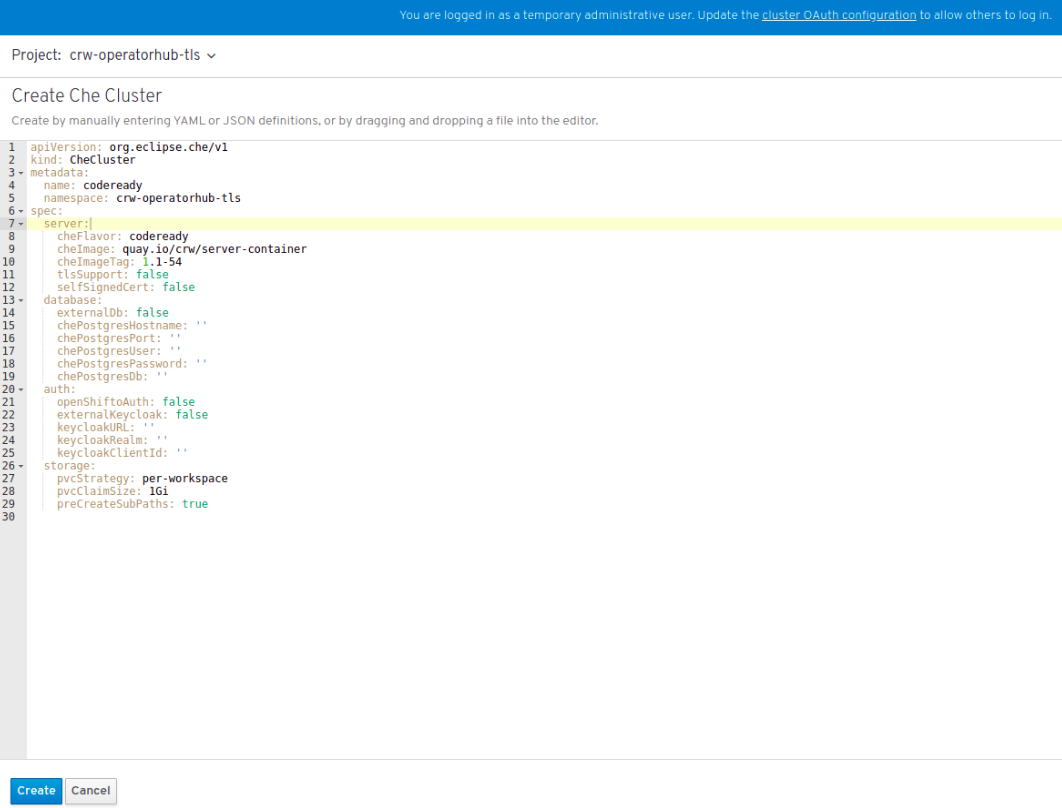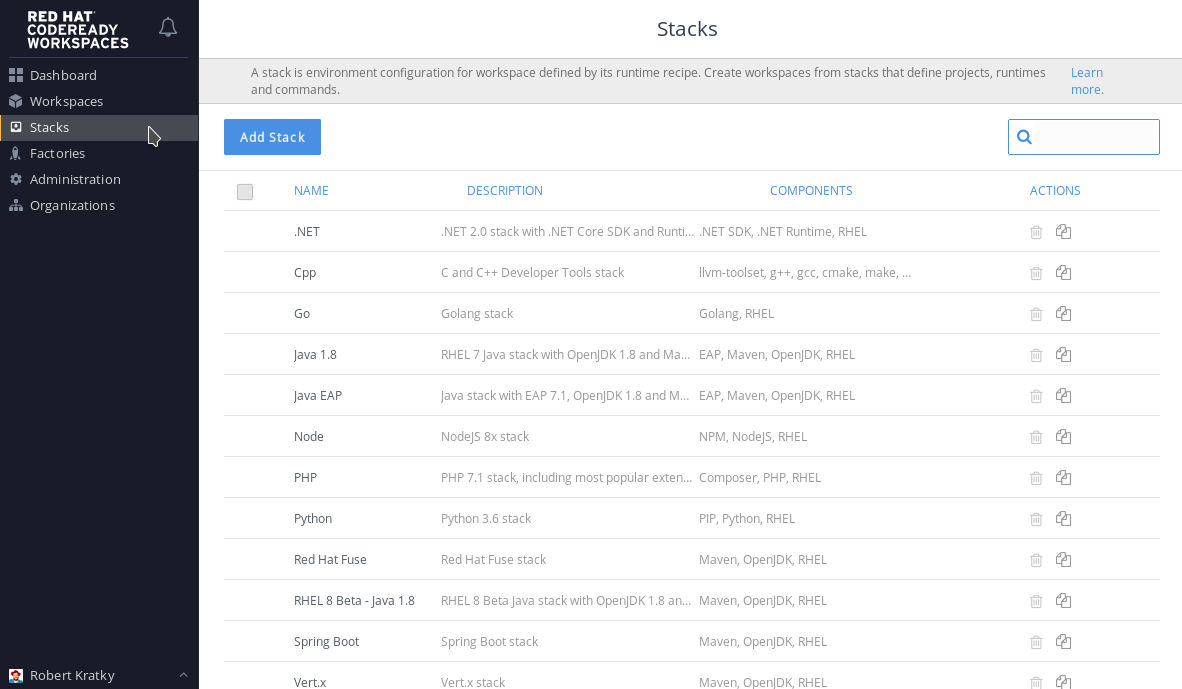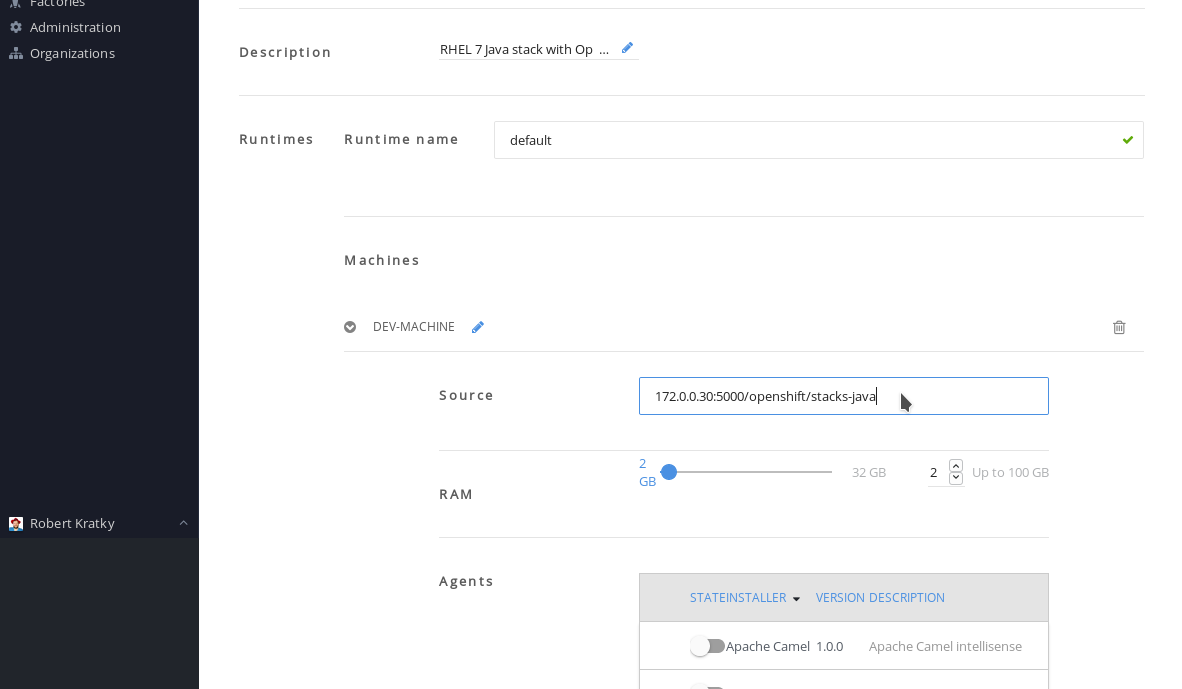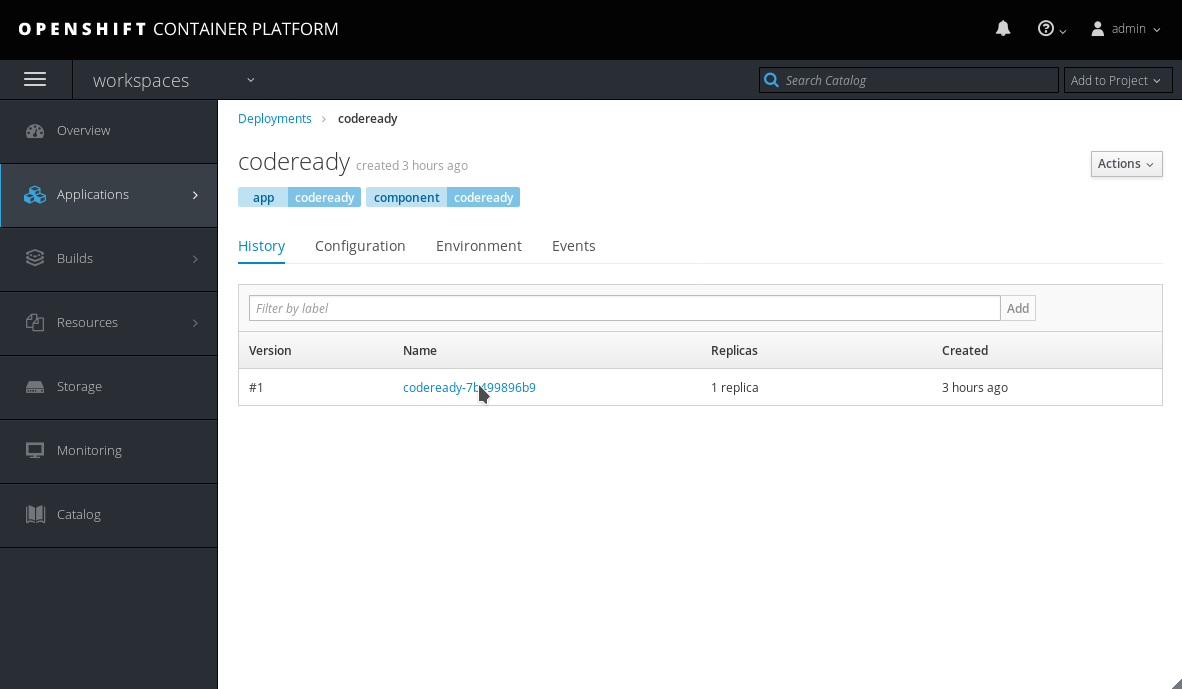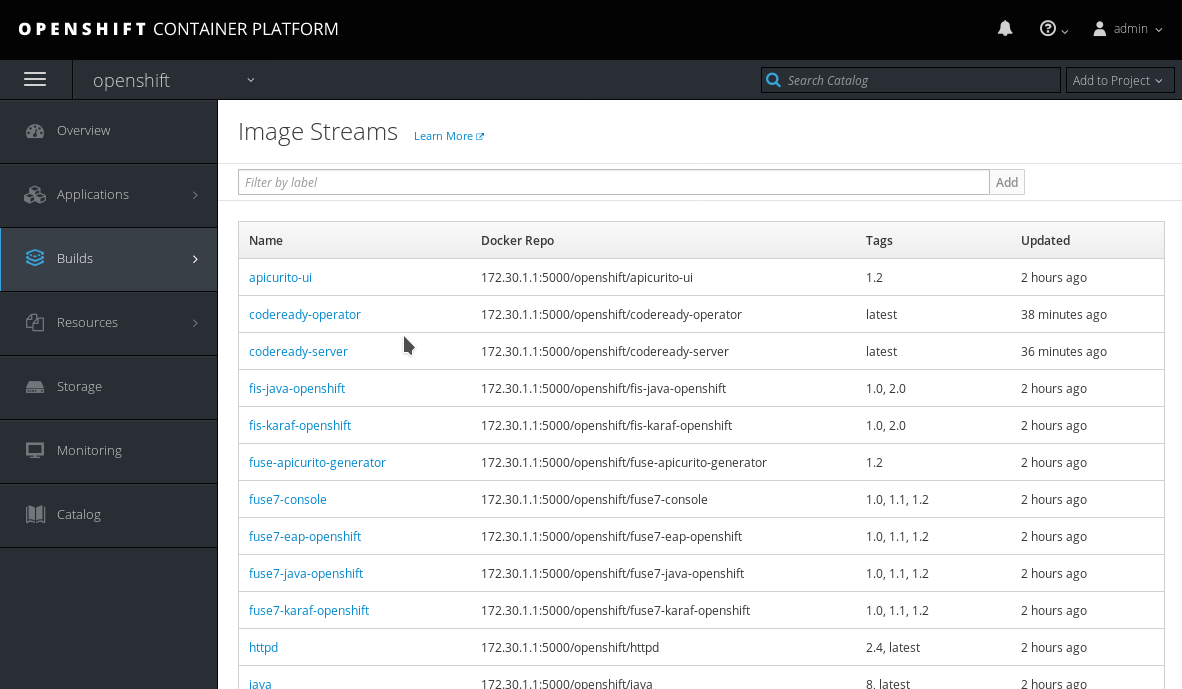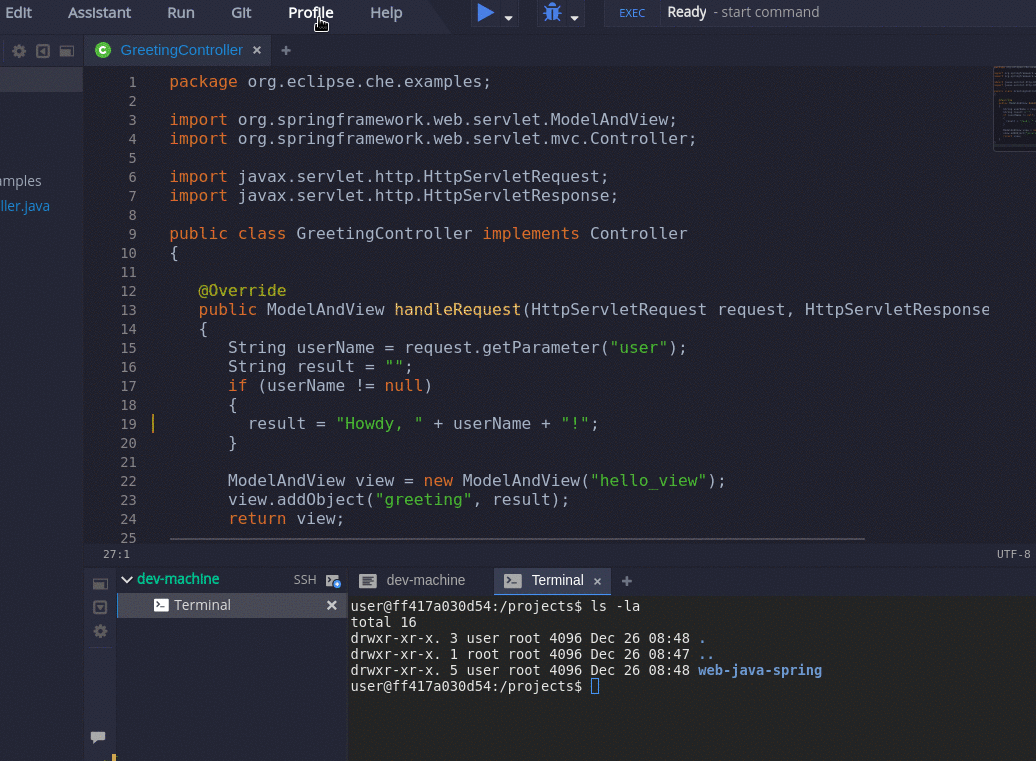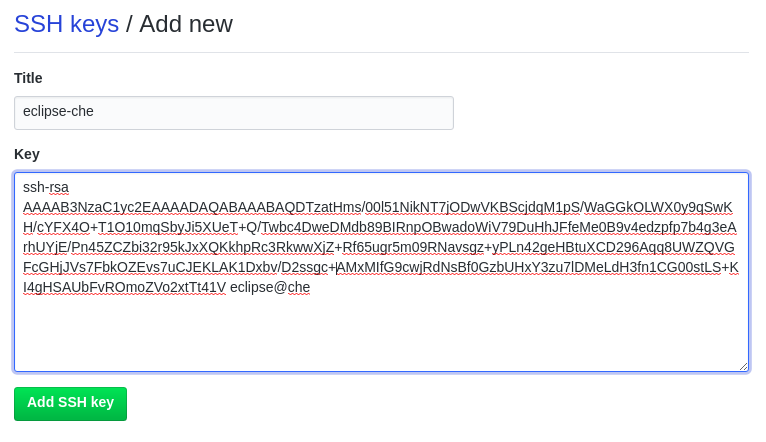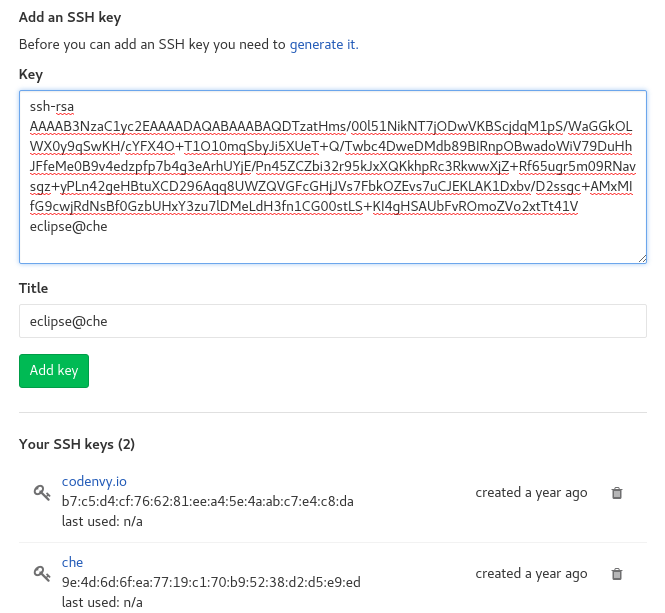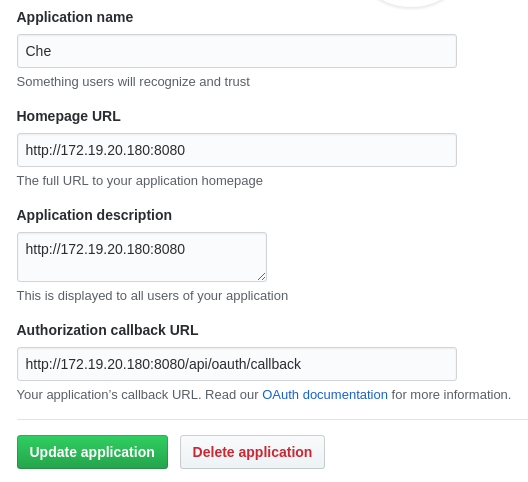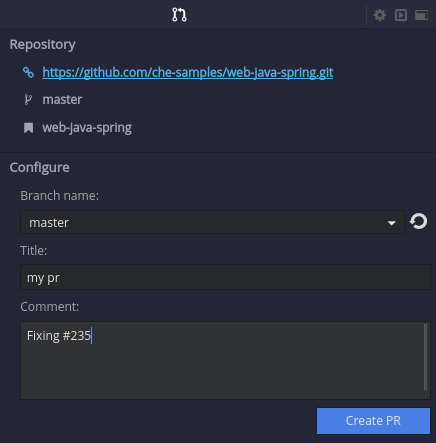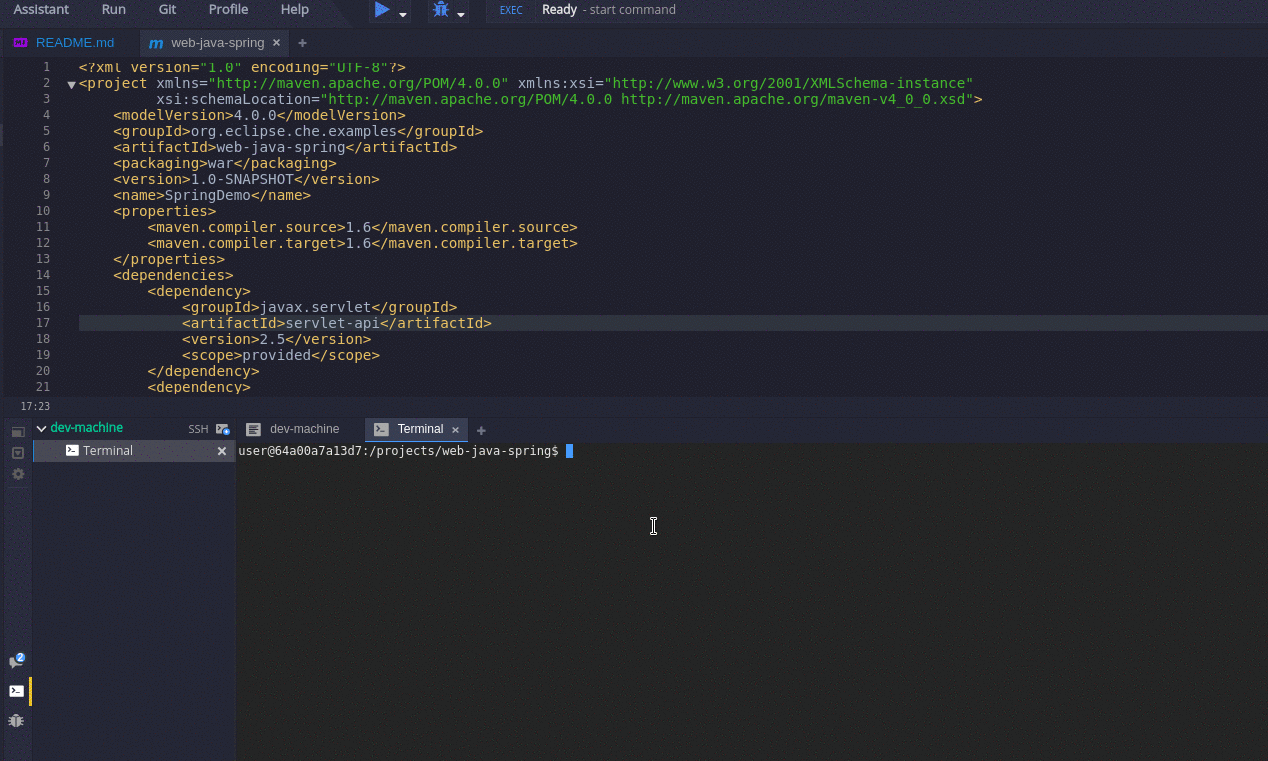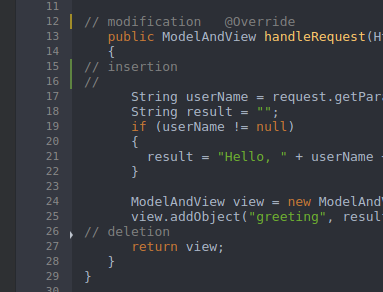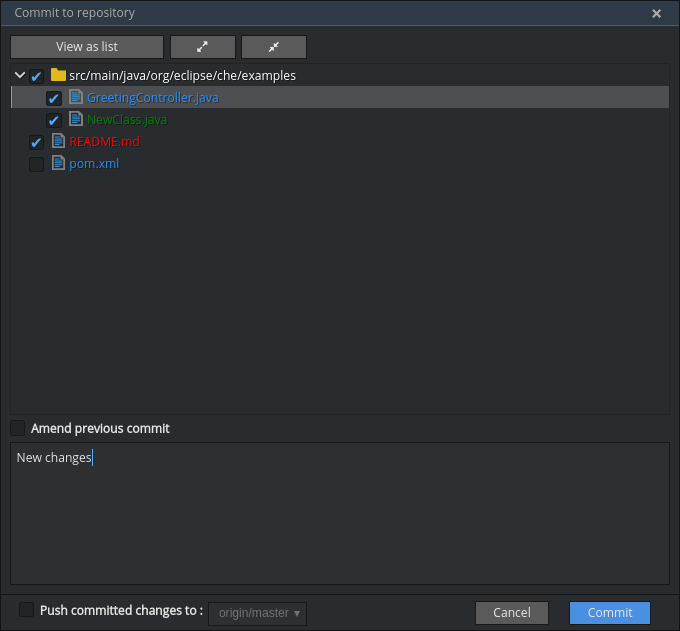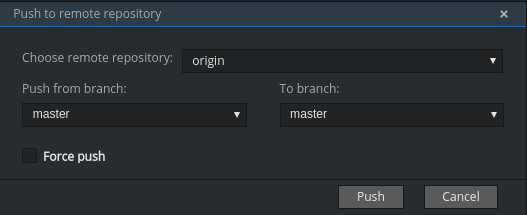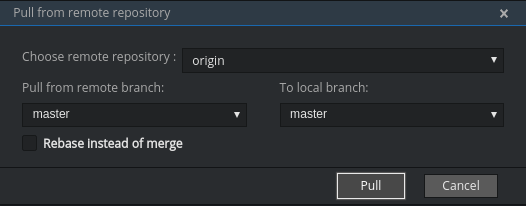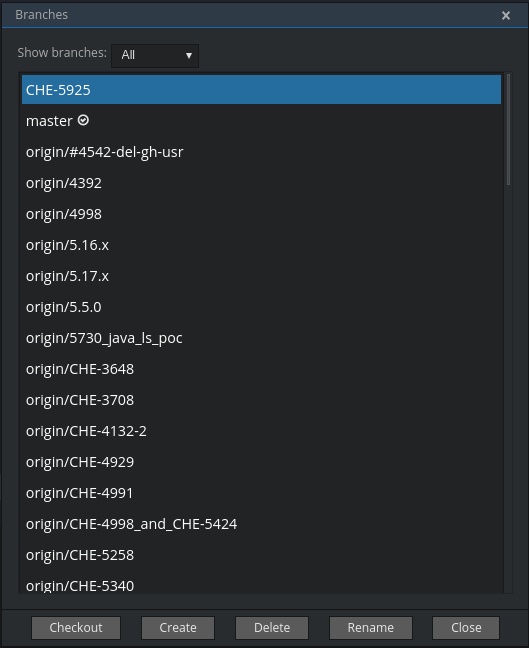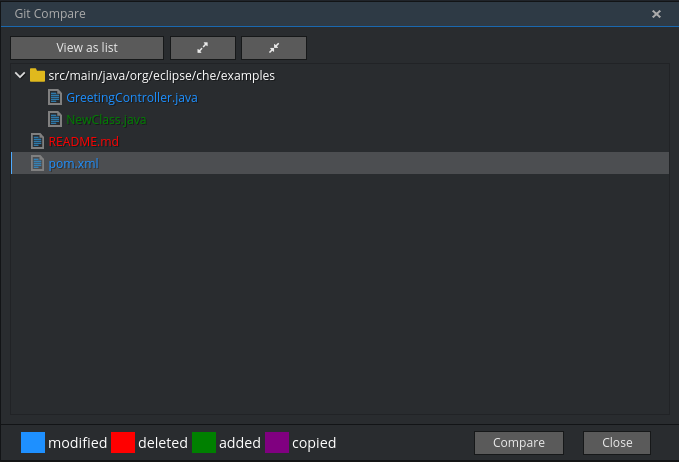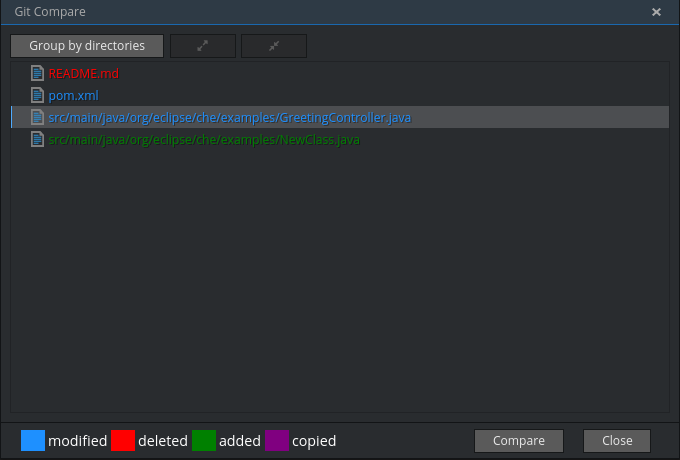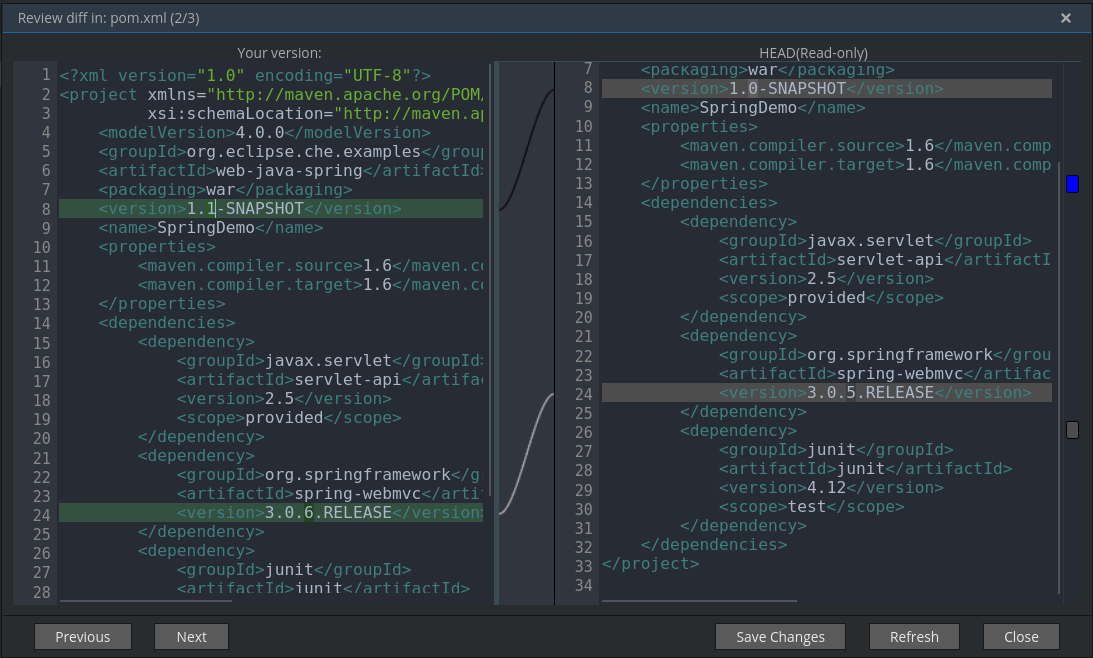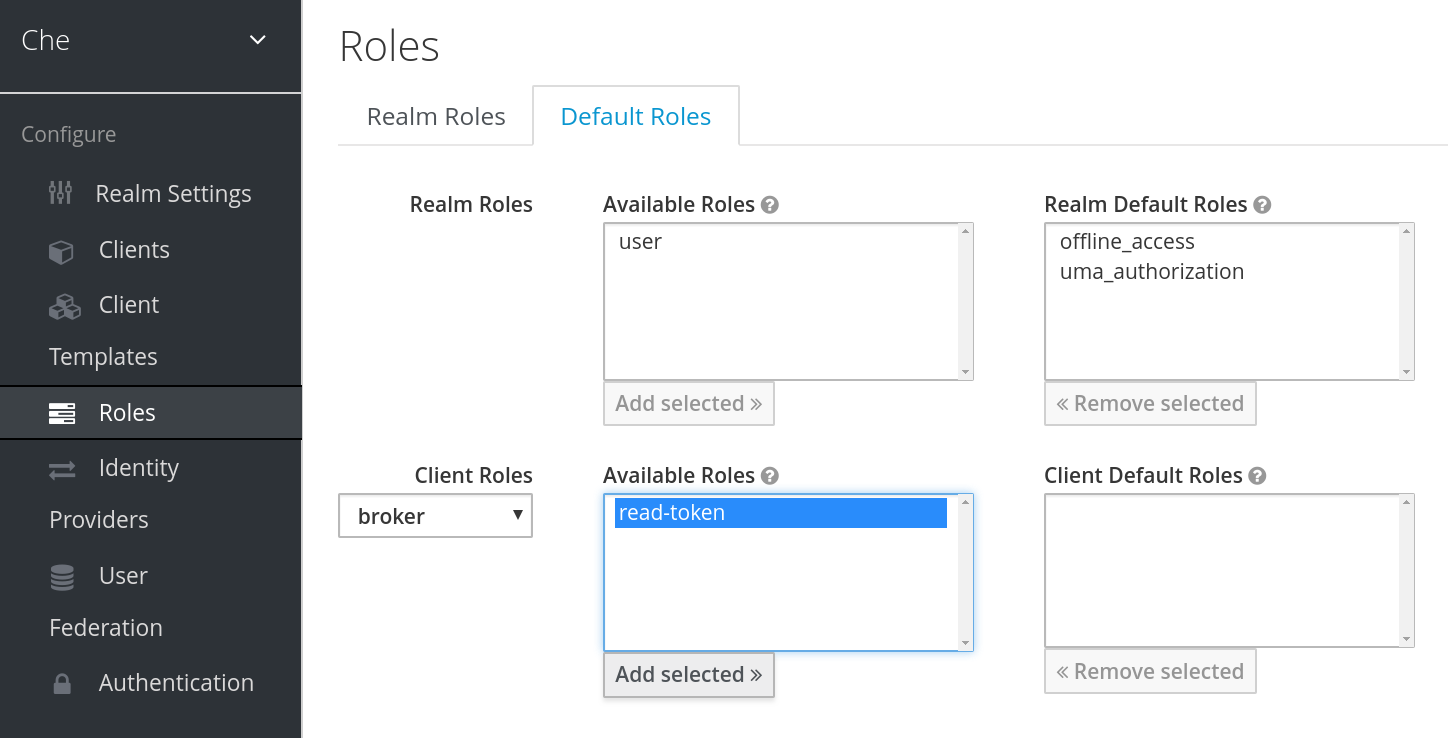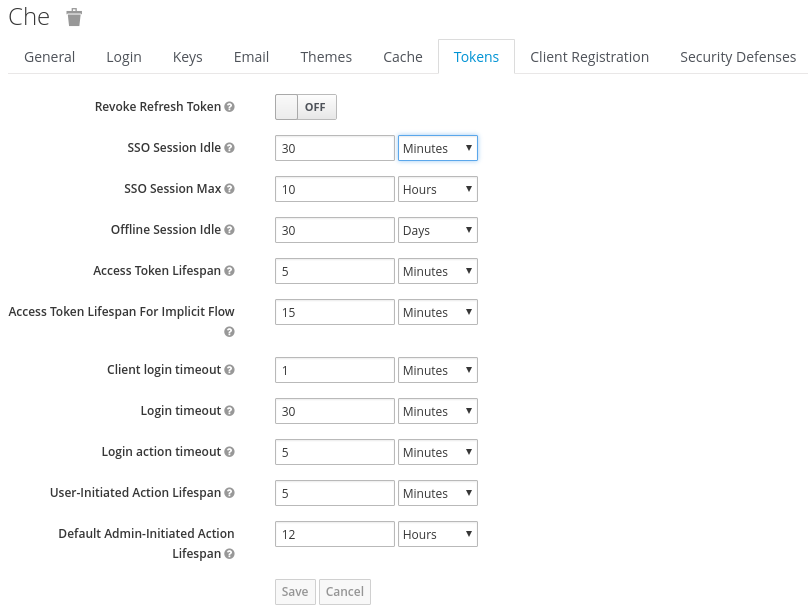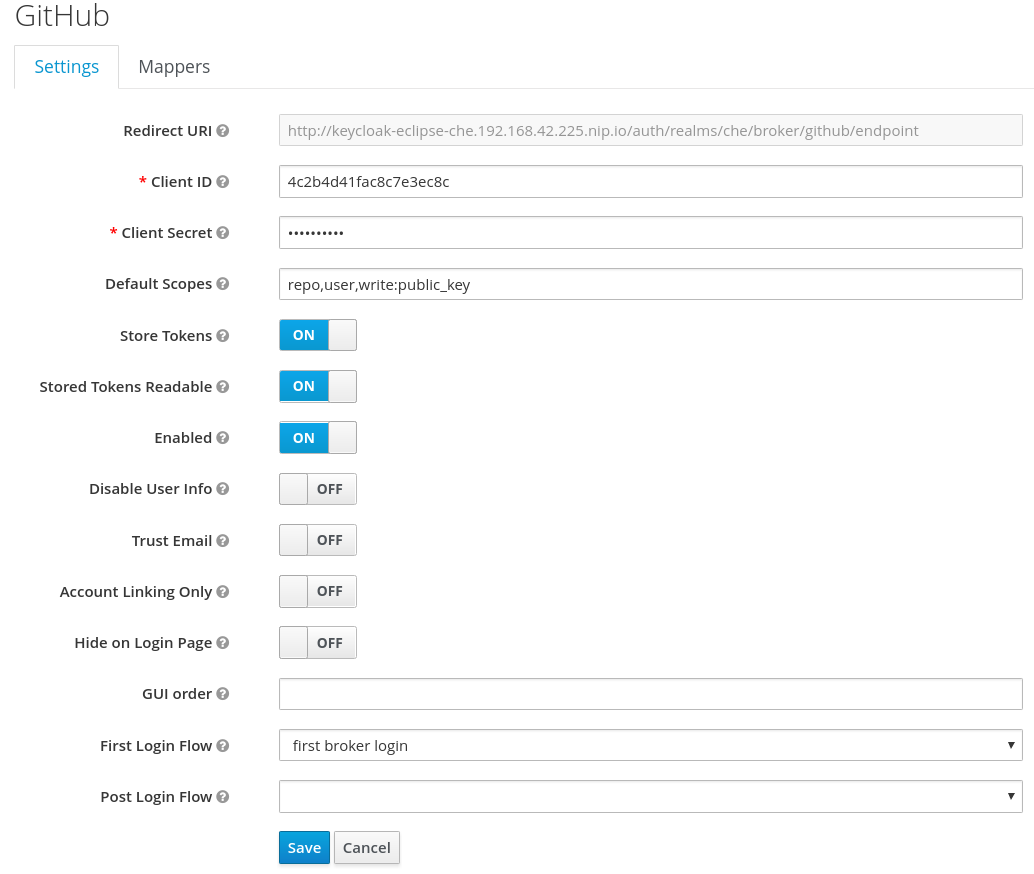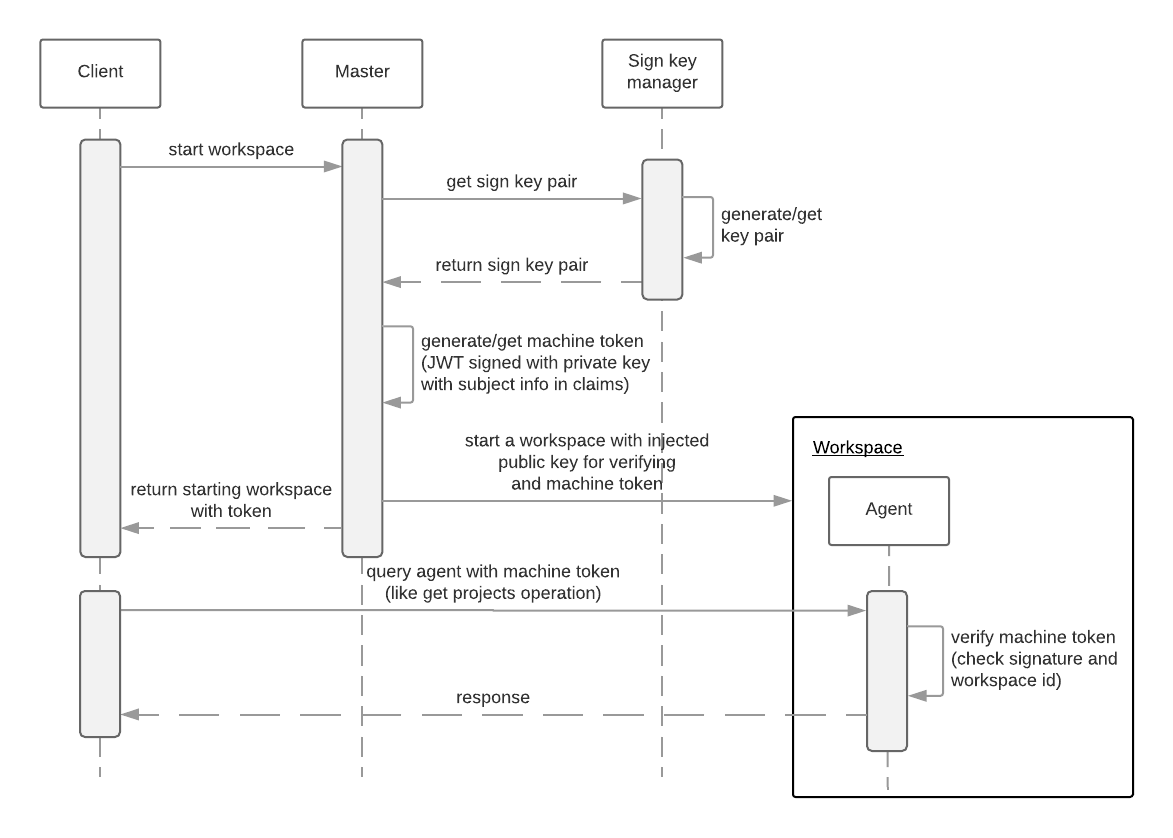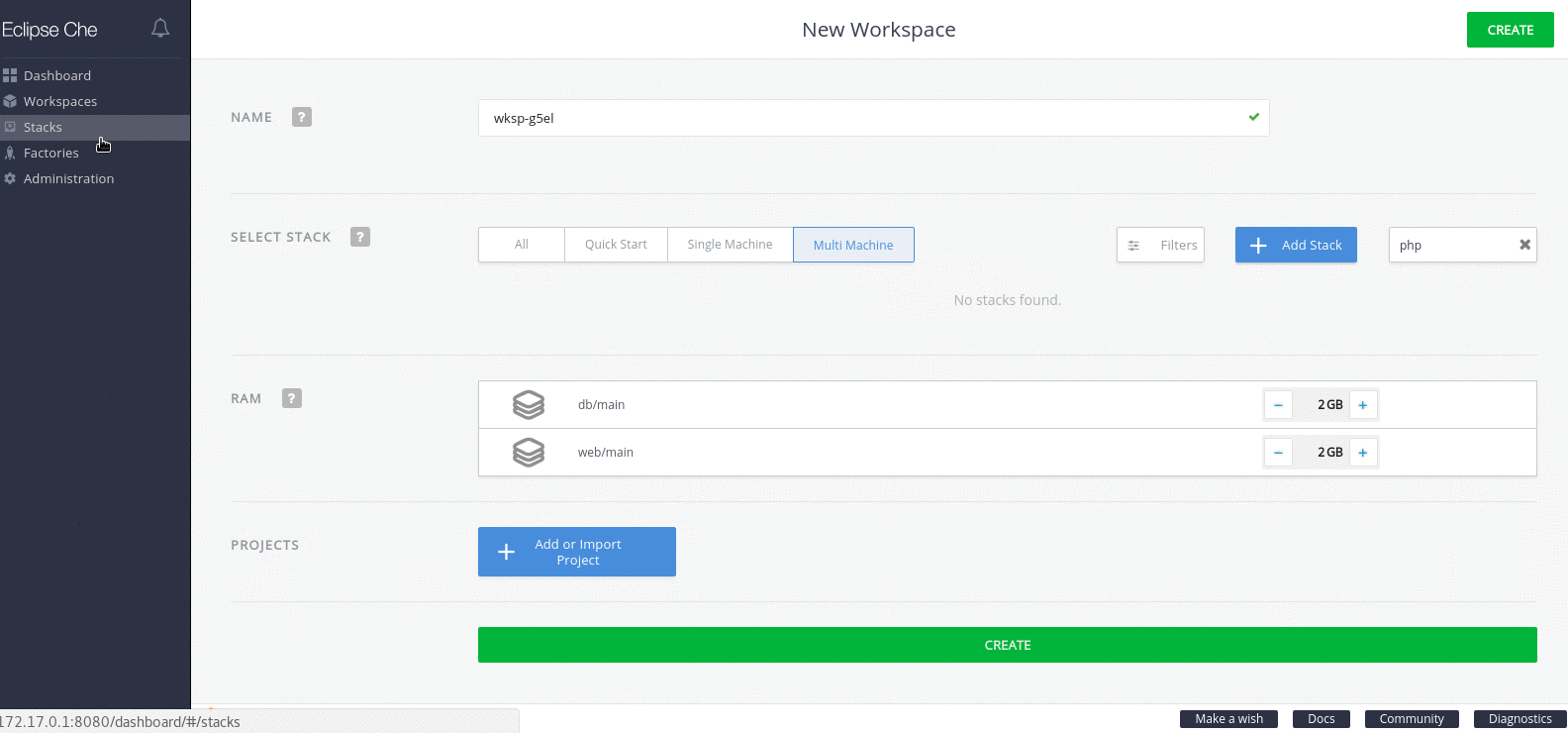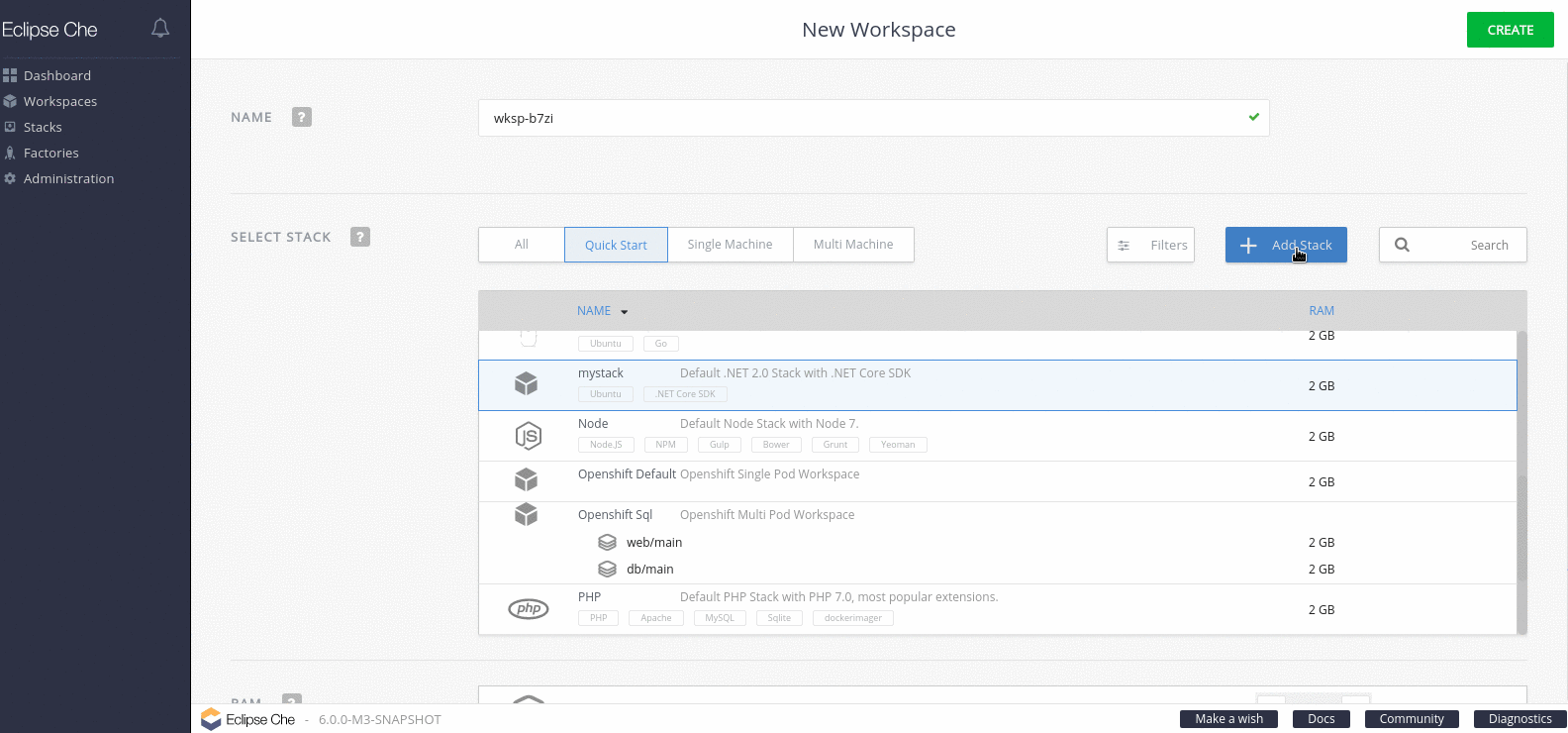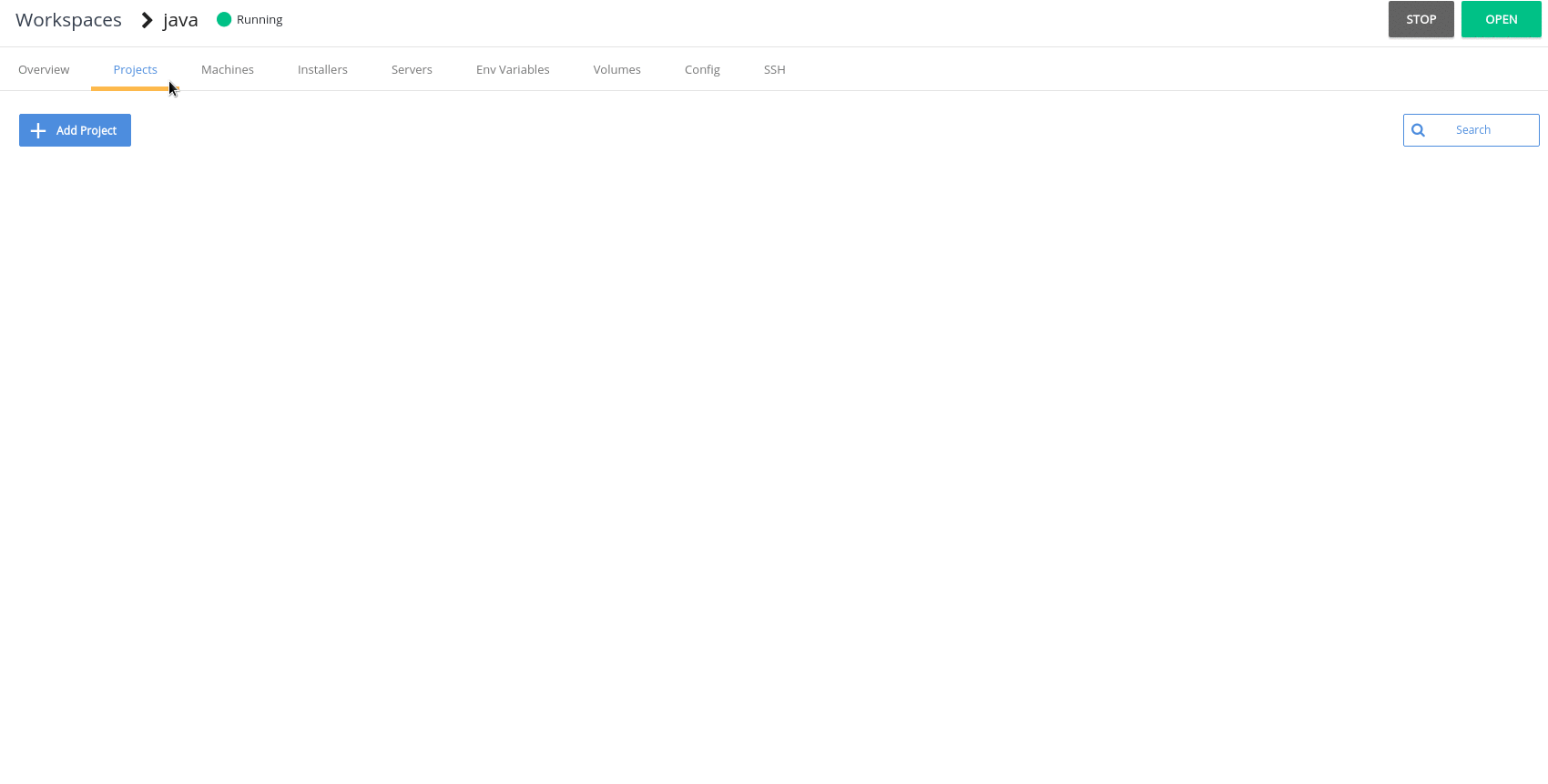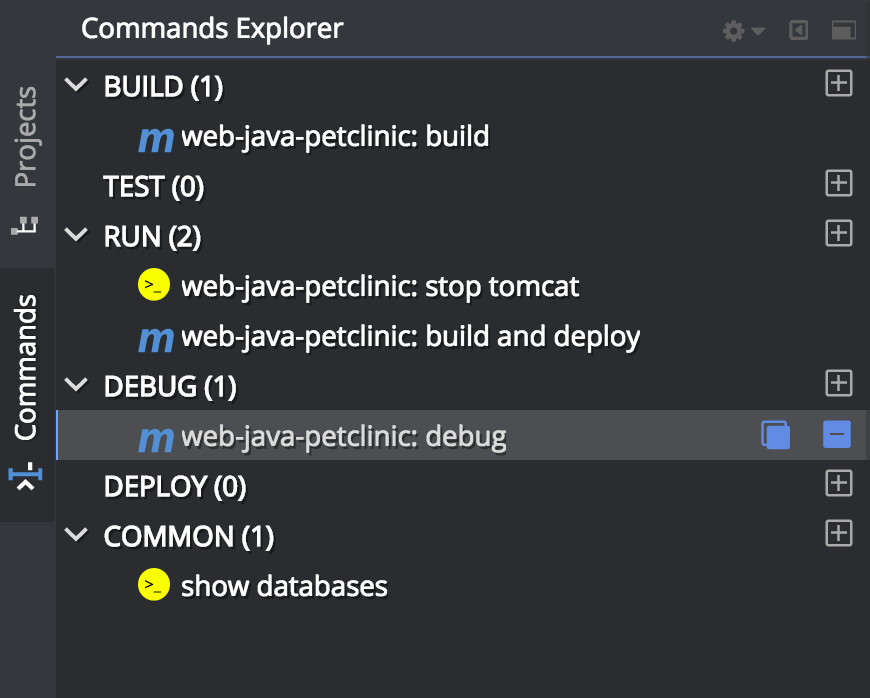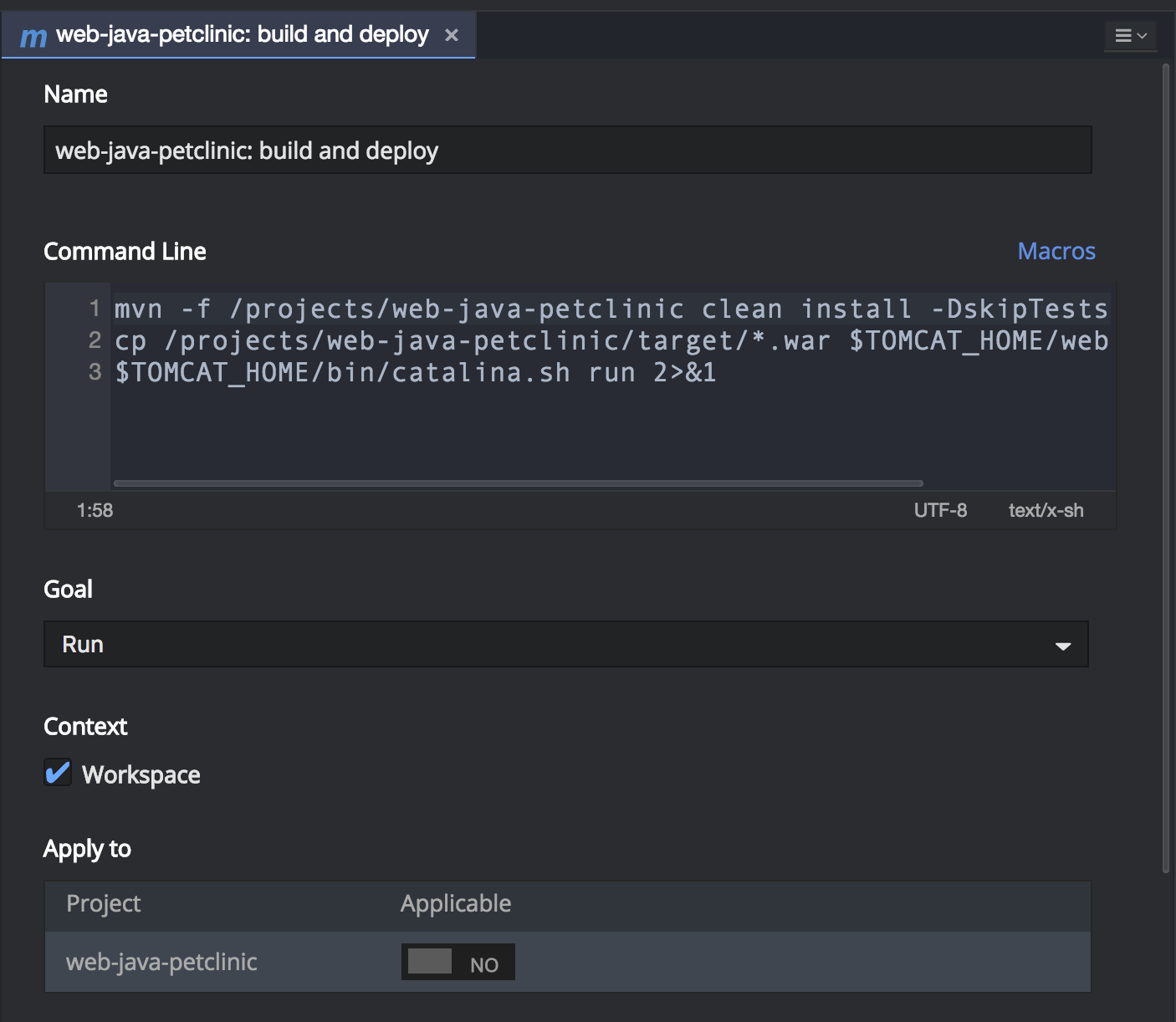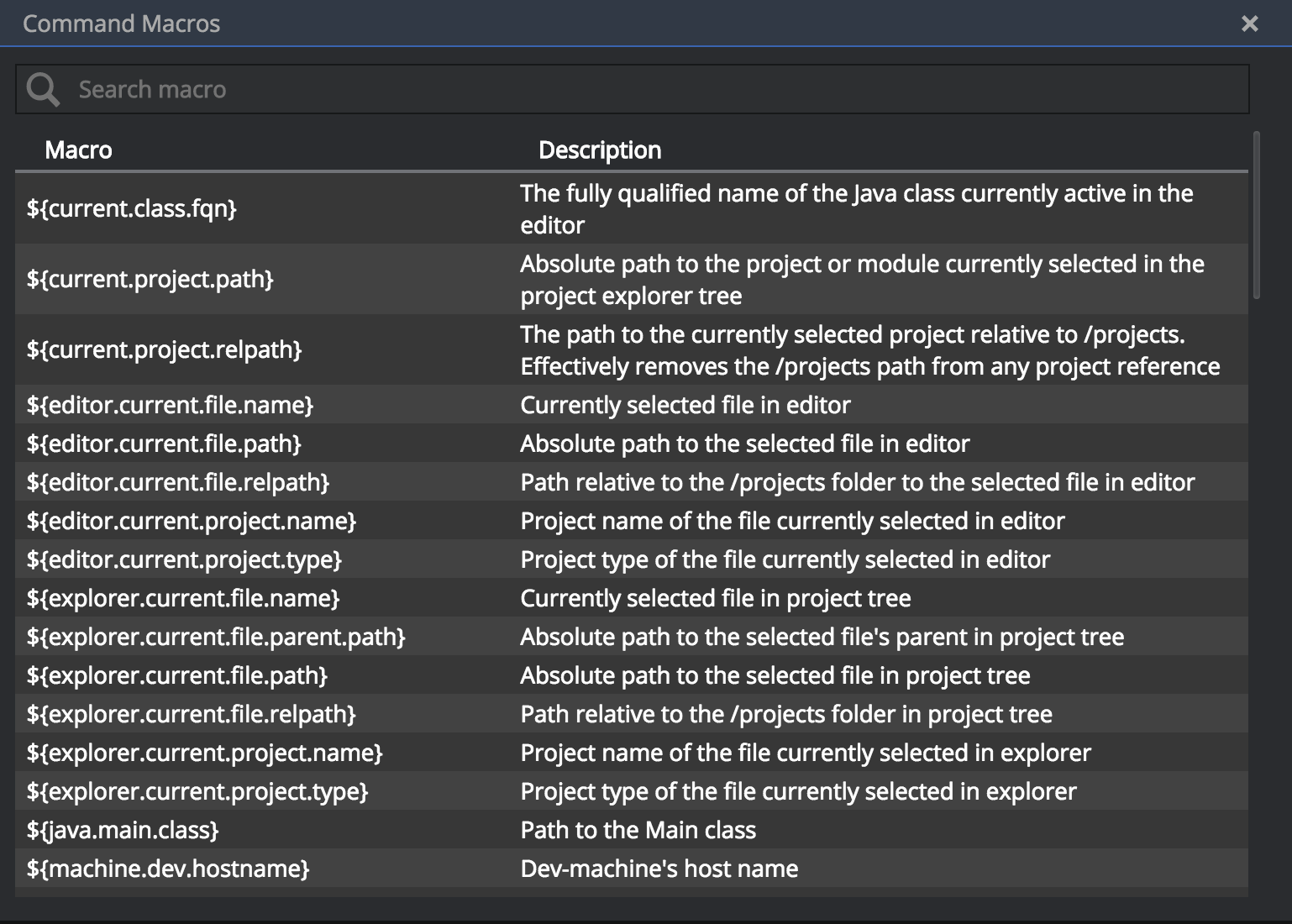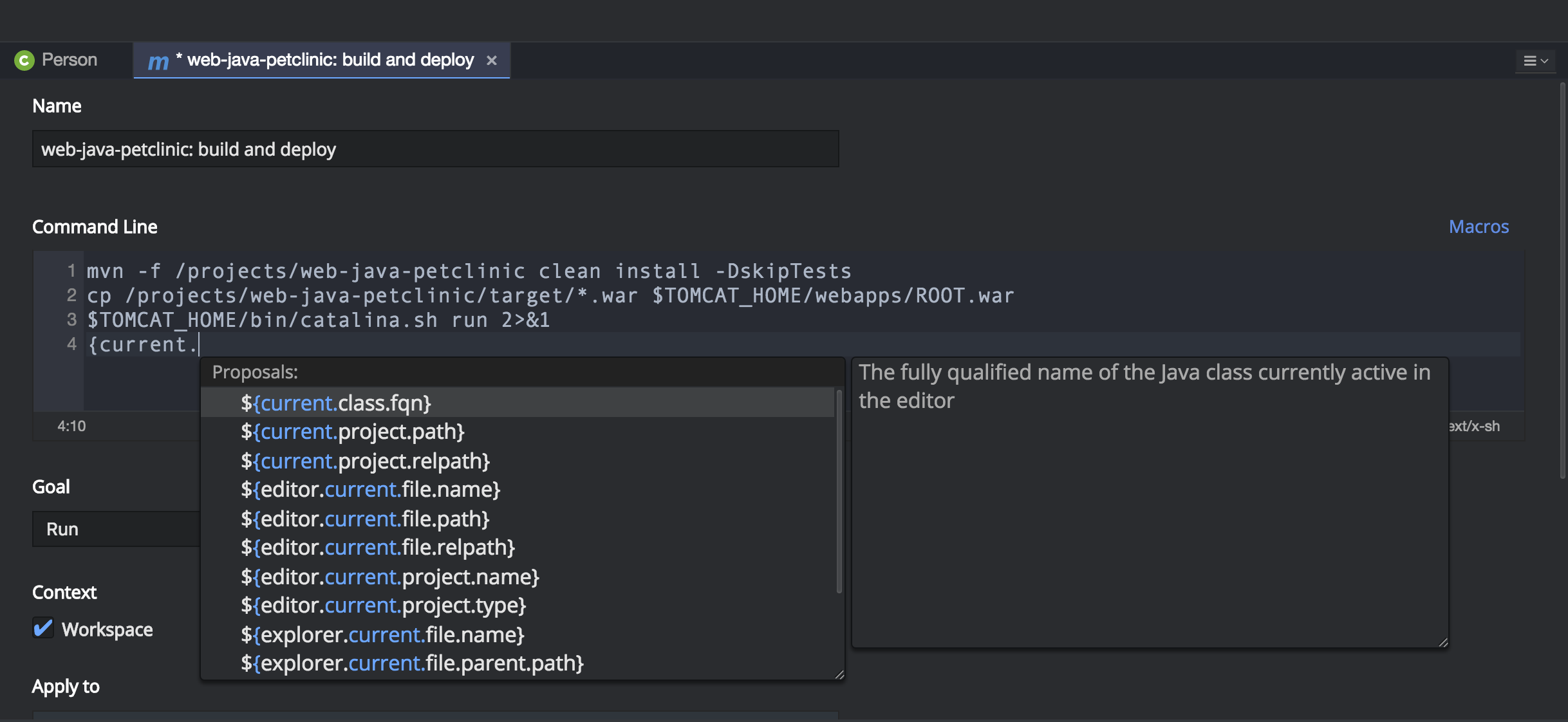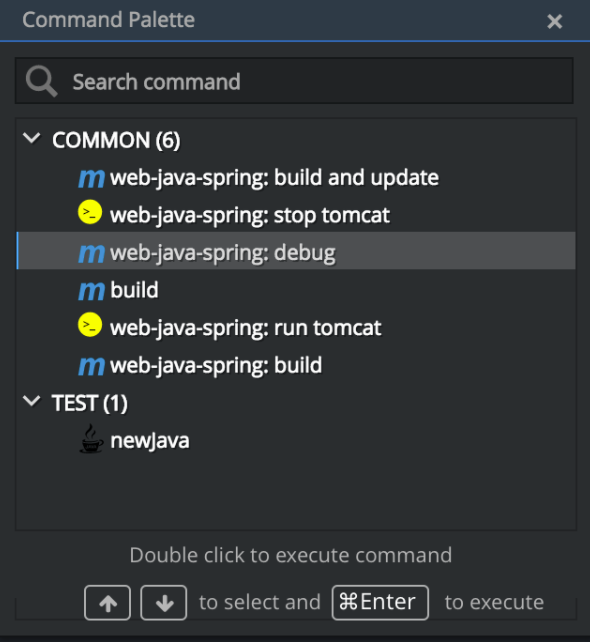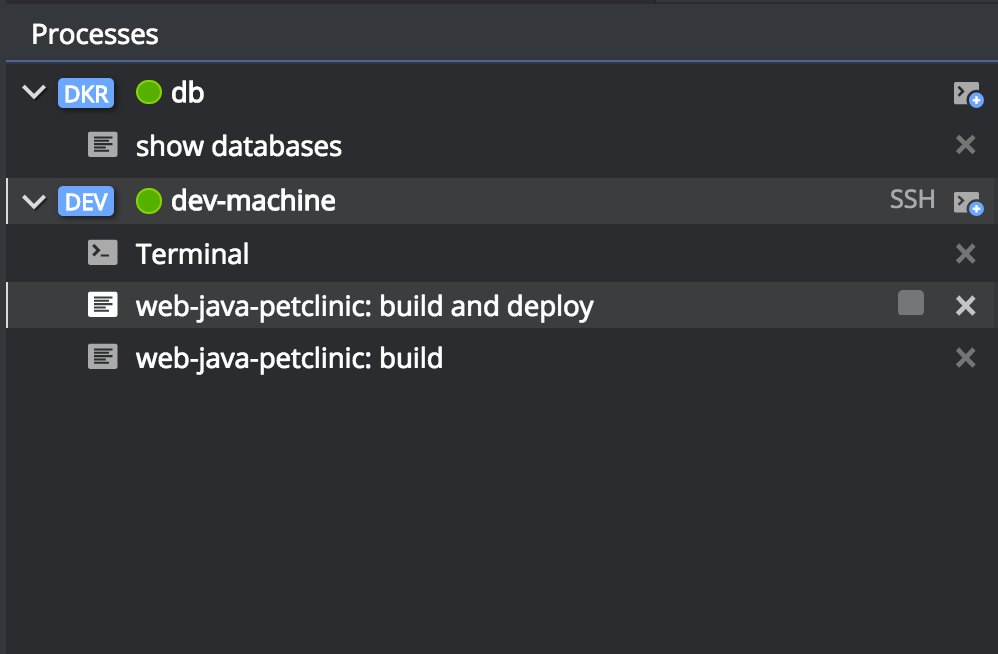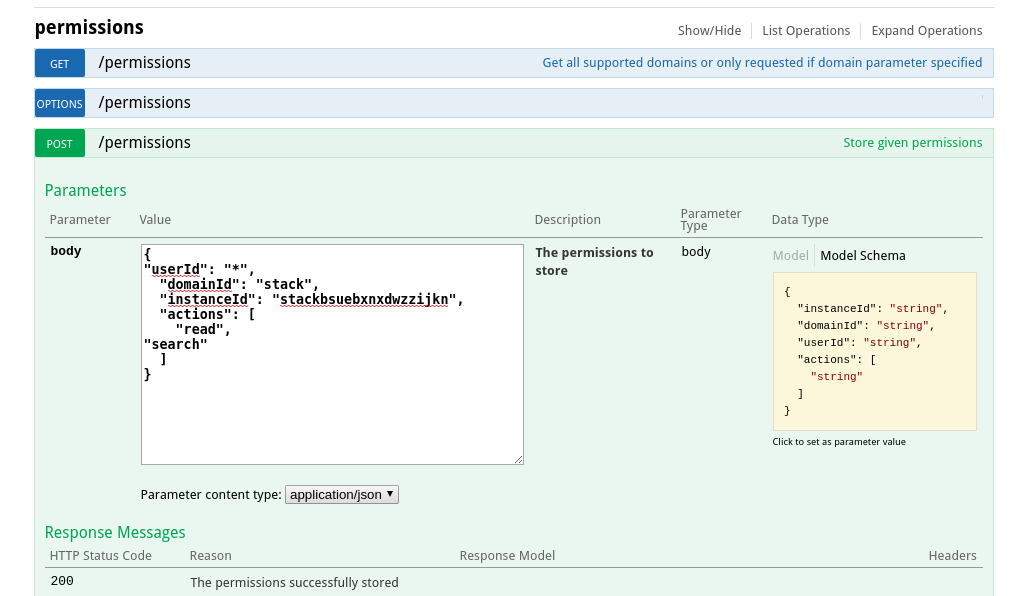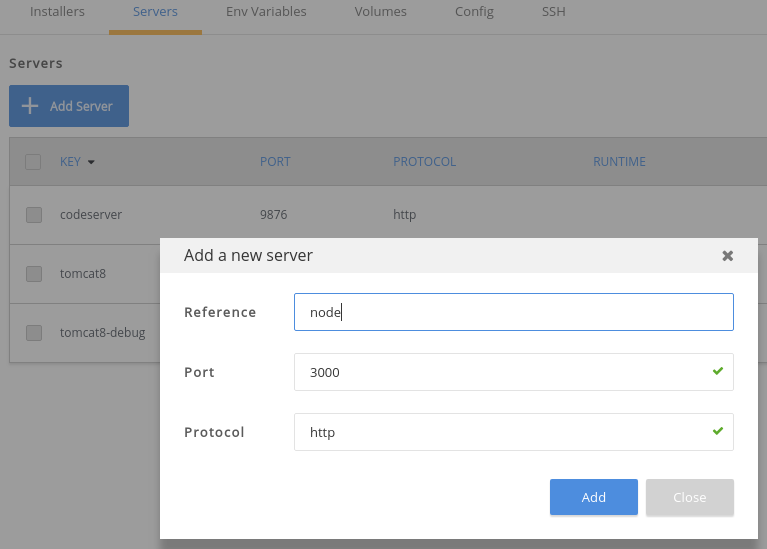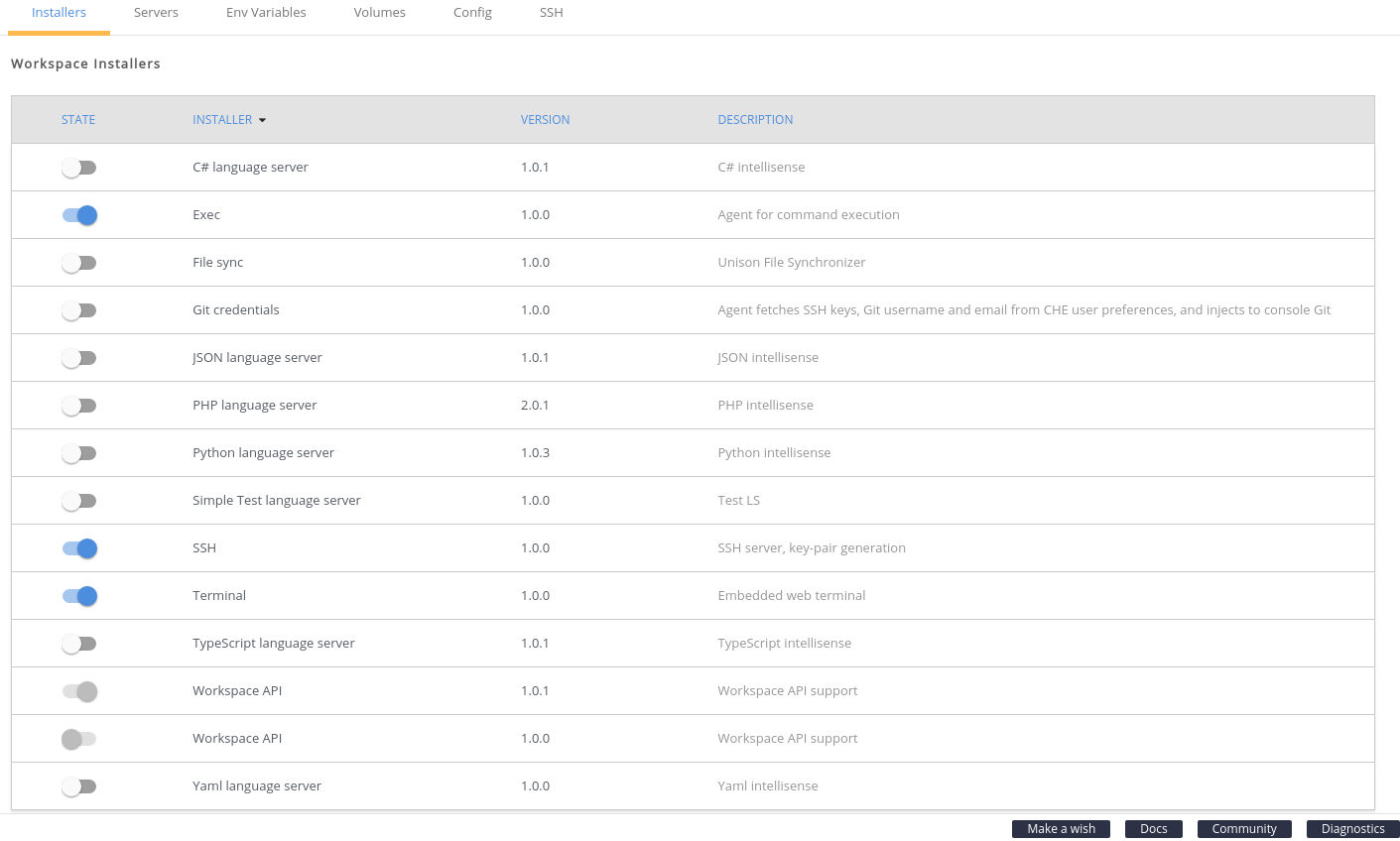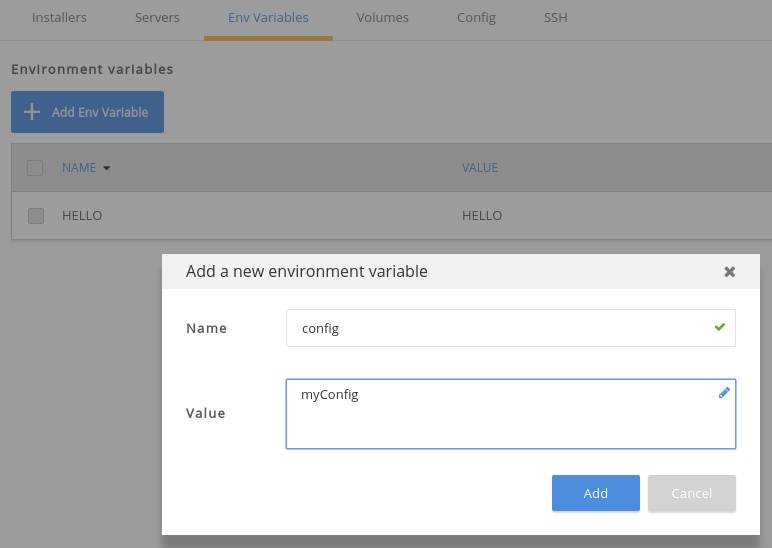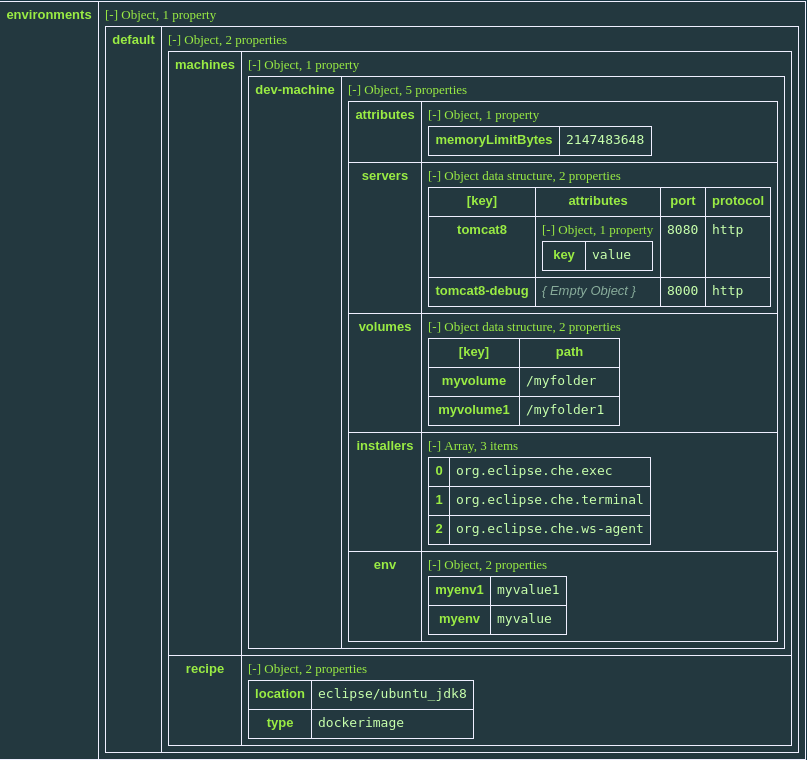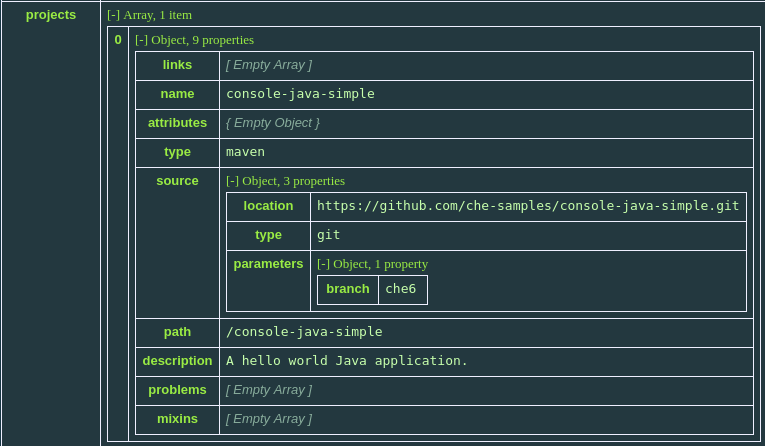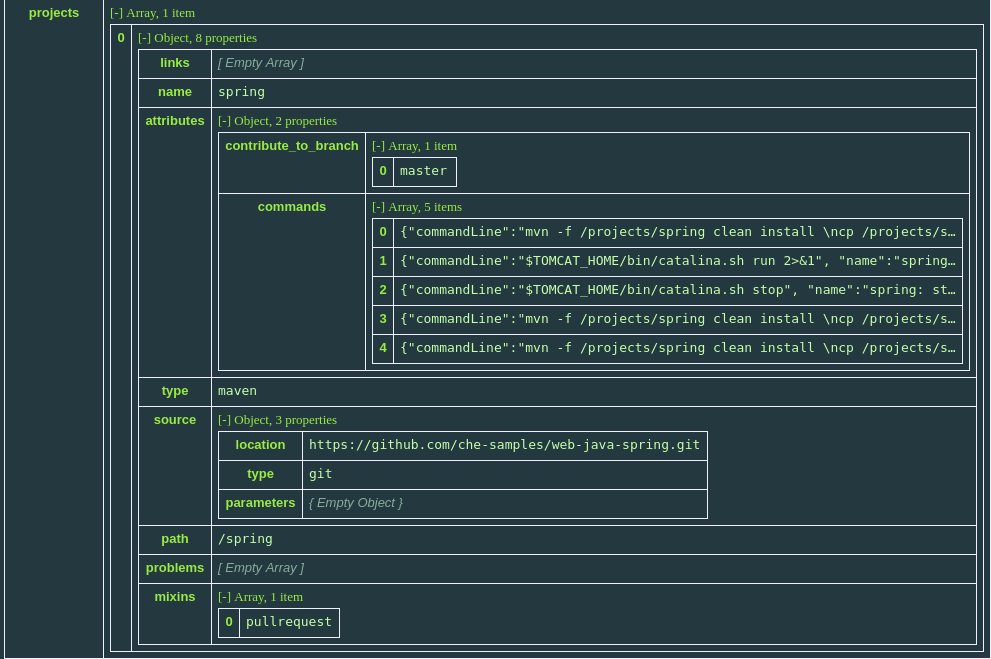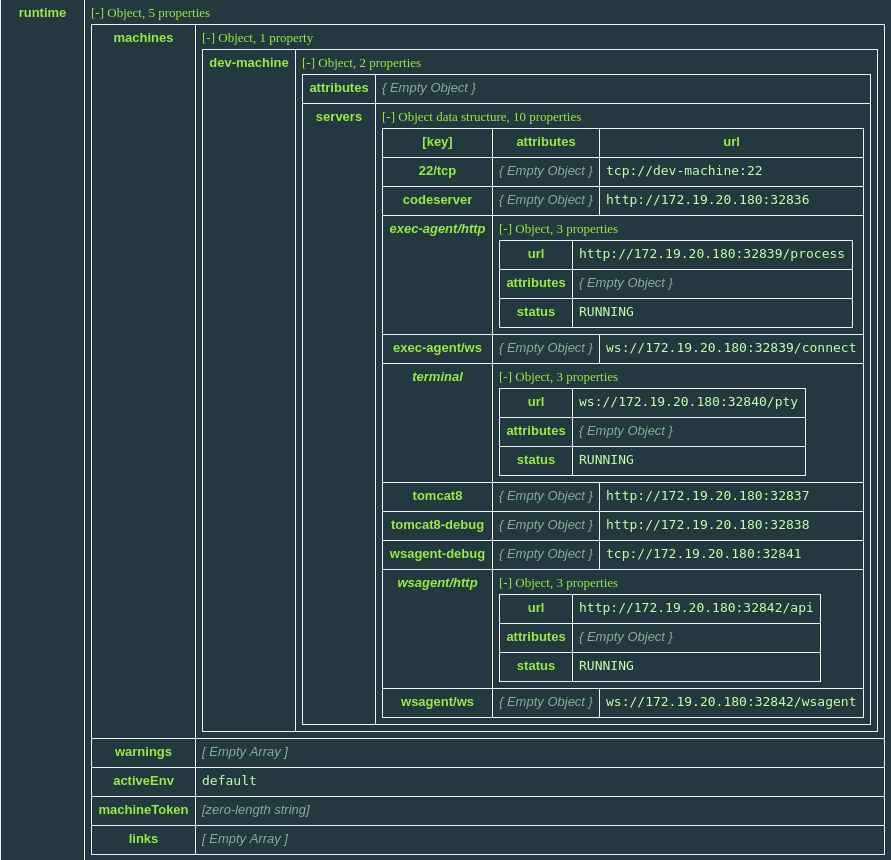Administration Guide
Installing and administering Red Hat CodeReady Workspaces 1.2
Abstract
Chapter 1. Understanding Red Hat CodeReady Workspaces
Red Hat CodeReady Workspaces is a developer workspace server and cloud IDE. Workspaces are defined as project code files and all of their dependencies neccessary to edit, build, run, and debug them. Each workspace has its own private IDE hosted within it. The IDE is accessible through a browser. The browser downloads the IDE as a single-page web application.
Red Hat CodeReady Workspaces provides:
- Workspaces that include runtimes and IDEs
- RESTful workspace server
- A browser-based IDE
- Plugins for languages, framework, and tools
- An SDK for creating plugins and assemblies
Additional resources
See Red Hat CodeReady Workspaces CodeReady Workspaces 1.2 Release Notes and Known Issues for more details about the current version.
Chapter 2. Installing CodeReady Workspaces on OpenShift v3
This section describes how to obtain installation files for Red Hat CodeReady Workspaces and how to use them to deploy the product on an instance of OpenShift (such as Red Hat OpenShift Container Platform) v3.
Prerequisites
Minimum hardware requirements
Minimum 5 GB RAM to run CodeReady Workspaces. The Red Hat Single Sign-On (Red Hat SSO) authorization server and the PostgreSQL database require extra RAM. CodeReady Workspaces uses RAM in the following distribution:
- The CodeReady Workspaces server: Approximately 750 MB
- Red Hat SSO: Approximately 1 GB
- PostgreSQL: Approximately 515 MB
- Workspaces: 2 GB of RAM per workspace. The total workspace RAM depends on the size of the workspace runtime(s) and the number of concurrent workspace pods.
Software requirements
- CodeReady Workspaces deployment script and configuration file
Container images required for deployment:
Important- The container images are now published on the registry.redhat.io registry and will only be available from registry.redhat.io. For details, see Red Hat Container Registry Authentication.
To use this registry you must be logged into it.
- To authorize from the local Docker daemon, see Using Authentication.
- To authorize from an OpenShift cluster, see Allowing Pods to Reference Images from Other Secured Registries.
It is not necessary to download any of the referenced images manually.
- All container images required for deployment are automatically downloaded by the CodeReady Workspaces deployment script.
- Stack images are automatically downloaded by CodeReady Workspaces when new workspaces are created.
-
registry.redhat.io/codeready-workspaces/server-rhel8:1.2 -
registry.redhat.io/codeready-workspaces/server-operator-rhel8:1.2 -
registry.redhat.io/rhscl/postgresql-96-rhel7:1-40 -
registry.redhat.io/redhat-sso-7/sso73-openshift:1.0-11 -
registry.redhat.io/ubi8-minimal:8.0-127
Container images with preconfigured stacks for creating workspaces:
-
registry.redhat.io/codeready-workspaces/stacks-java-rhel8:1.2 -
registry.redhat.io/codeready-workspaces/stacks-node-rhel8:1.2 -
registry.redhat.io/codeready-workspaces/stacks-php-rhel8:1.2 -
registry.redhat.io/codeready-workspaces/stacks-python-rhel8:1.2 -
registry.redhat.io/codeready-workspaces/stacks-dotnet-rhel8:1.2 -
registry.redhat.io/codeready-workspaces/stacks-golang-rhel8:1.2 -
registry.redhat.io/codeready-workspaces/stacks-java-rhel8:1.2 -
registry.redhat.io/codeready-workspaces/stacks-cpp-rhel8:1.2 -
registry.redhat.io/codeready-workspaces/stacks-node:1.2
-
Other
To be able to download the CodeReady Workspaces deployment script, Red Hat asks that you register for the free Red Hat Developer Program. This allows you to agree to license conditions of the product. For instructions on how to obtain the deployment script, see Section 2.2, “Downloading the CodeReady Workspaces deployment script”.
2.1. Downloading the Red Hat OpenShift Origin Client Tools
This procedure describes steps to obtain and unpack the archive with the Red Hat OpenShift Origin Client Tools.
The CodeReady Workspaces deployment and migration scripts require the use of OpenShift Origin Client Tools 3.11. Later versions may be supported in future but as deployment of CodeReady Workspaces to OpenShift Container Platform and OpenShift Dedicated 4 can be done via the embedded OperatorHub, using a deployment script is no longer necessary.
Procedure
Change to a temporary directory. Create it if necessary. For example:
mkdir ~/tmp cd ~/tmp
$ mkdir ~/tmp $ cd ~/tmpCopy to Clipboard Copied! Toggle word wrap Toggle overflow -
Download the archive with the
ocfile from: oc.tar.gz. Unpack the downloaded archive. The
ocexecutable file is unpacked in your current directory:tar xf oc.tar.gz && ./oc version
$ tar xf oc.tar.gz && ./oc versionCopy to Clipboard Copied! Toggle word wrap Toggle overflow -
Add the
ocfile to your path.
2.2. Downloading the CodeReady Workspaces deployment script
This procedure describes how to obtain and unpack the archive with the CodeReady Workspaces deployment shell script.
The CodeReady Workspaces deployment script uses the OpenShift Operator to deploy Red Hat Single Sign-On, the PostgreSQL database, and the CodeReady Workspaces server container images on an instance of Red Hat OpenShift Container Platform. The images are available in the Red Hat Container Catalog.
Procedure
Change to a temporary directory. Create it if necessary. For example:
mkdir ~/tmp cd ~/tmp
$ mkdir ~/tmp $ cd ~/tmpCopy to Clipboard Copied! Toggle word wrap Toggle overflow -
Download the archive with the deployment script and the
custom-resource.yamlfile using the browser with which you logged into the Red Hat Developer Portal: codeready-workspaces-1.2.2.GA-operator-installer.tar.gz. Unpack the downloaded archive and change to the created directory:
tar xvf codeready-workspaces-1.2.2.GA-operator-installer.tar.gz \ && cd codeready-workspaces-operator-installer/
$ tar xvf codeready-workspaces-1.2.2.GA-operator-installer.tar.gz \ && cd codeready-workspaces-operator-installer/Copy to Clipboard Copied! Toggle word wrap Toggle overflow
Next steps
Continue by configuring and running the deployment script. See Section 2.3, “Running the CodeReady Workspaces deployment script”.
2.3. Running the CodeReady Workspaces deployment script
The CodeReady Workspaces deployment script uses command-line arguments and the custom-resource.yaml file to populate a set of configuration environment variables for the OpenShift Operator used for the actual deployment.
Prerequisites
- Downloaded and unpacked deployment script and the configuration file. See Section 2.2, “Downloading the CodeReady Workspaces deployment script”.
- A running instance of Red Hat OpenShift Container Platform 3.11 or OpenShift Dedicated 3.11. To install OpenShift Container Platform, see the Getting Started with OpenShift Container Platform guide.
-
The OpenShift Origin Client Tools 3.11,
oc, is in the path. See Section 2.1, “Downloading the Red Hat OpenShift Origin Client Tools”. -
The user is logged in to the OpenShift instance (using, for example,
oc login). - CodeReady Workspaces is supported for use with Google Chrome 70.0.3538.110 (Official Build) (64bit).
cluster-adminrights to successfully deploy CodeReady Workspaces using the deploy script. The following table lists the objects and the required permissions:Expand Type of object Name of the object that the installer creates Description Permission required CRD
-
Custom Resource Definition - CheCluster
cluster-adminCR
codereadyCustom Resource of the CheCluster type of object
cluster-admin. Alternatively, you can create aclusterrole.ServiceAccount
codeready-operatorOperator uses this service account to reconcile CodeReady Workspaces objects
The edit role in a target namespace.
Role
codeready-operatorScope of permissions for the operator-service account
cluster-adminRoleBinding
codeready-operatorAssignment of a role to the service account
The edit role in a target namespace.
Deployment
codeready-operatorDeployment with operator image in the template specification
The edit role in a target namespace.
ClusterRole
codeready-operatorClusterRoleallows you to create, update, delete oAuthClientscluster-adminClusterRoleBinding
${NAMESPACE}-codeready-operatorClusterRoleBindingallows you to create, update, delete oAuthClientscluster-adminRole
secret-readerRoleallows you to read secrets in the router namespacecluster-adminRoleBinding
${NAMESPACE}-codeready-operatorRoleBindingallows you to read secrets in router namespacecluster-admin
By default, the operator-service account gets privileges to list, get, watch, create, update, and delete ingresses, routes, service accounts, roles, rolebindings, PVCs, deployments, configMaps, secrets. It also has privileges to run execs into pods, watch events, and read pod logs in a target namespace.
With self-signed certificates support enabled, the operator-service account gets privileges to read secrets in an OpenShift router namespace.
With OpenShift OAuth enabled, the operator-service account gets privileges to get, list, create, update, and delete oAuthclients at a cluster scope.
2.3.1. Deploying CodeReady Workspaces with default settings
Run the following command:
./deploy.sh --deploy
$ ./deploy.sh --deployCopy to Clipboard Copied! Toggle word wrap Toggle overflow NoteRun the
./deploy.sh --helpcommand to get a list of all available arguments. For a description of all the options, see Section 2.6, “CodeReady Workspaces deployment script parameters”.The following messages indicates that CodeReady Workspaces is getting installed:
Copy to Clipboard Copied! Toggle word wrap Toggle overflow The CodeReady Workspaces successfully deployed and available at <URL> message confirms that the deployment is successful.
- Open the OpenShift web console.
- In the My Projects pane, click workspaces.
Click Applications > Pods. The pods are shown running.
Figure 2.1. Pods for codeready shown running
2.3.2. Deploying CodeReady Workspaces with a self-signed certificate and OpenShift OAuth
To deploy CodeReady Workspaces with a self-signed certificate, run the following command:
./deploy.sh --deploy --oauth
$ ./deploy.sh --deploy --oauthIf you use the TLS mode with a self-signed certificate, ensure that your browser trusts the certificate. If it does not trust the certificate, the Authorization token is missed error is displayed on the login page and the running workspace may not work as intended.
2.3.3. Deploying CodeReady Workspaces with a public certificate
To deploy CodeReady Workspaces to a cluster configured with public certificates, run the following command:
./deploy.sh --deploy --public-certs
$ ./deploy.sh --deploy --public-certs2.3.4. Deploying CodeReady Workspaces with external Red Hat Single Sign-On
To deploy with an external Red Hat Single Sign-On (Red Hat SSO) and enable a Red Hat SSO instance, take the following steps:
Update the following values in the
custom-resource.yamlfile:auth: externalIdentityProvider: 'true' identityProviderURL: 'https://my-red-hat-sso.com' identityProviderRealm: 'myrealm' identityProviderClientId: 'myClient'
auth: externalIdentityProvider: 'true'1 identityProviderURL: 'https://my-red-hat-sso.com'2 identityProviderRealm: 'myrealm'3 identityProviderClientId: 'myClient'4 Copy to Clipboard Copied! Toggle word wrap Toggle overflow - 1
- Instructs the operator on whether or not to deploy the Red Hat SSO instance. When set to
true, provisions the connection details. - 2
- Retrieved from the respective route or ingress unless explicitly specified in CR (when the
externalIdentityProvidervariable istrue). - 3
- Name of a Red Hat SSO realm. This realm is created when the
externalIdentityProvidervariable istrue. Otherwise, it is passed to the CodeReady Workspaces server. - 4
- The ID of a Red Hat SSO client. This client is created when the
externalIdentityProvidervariable isfalse. Otherwise, it is passed to the CodeReady Workspaces server.
Run the deploy script:
./deploy.sh --deploy
$ ./deploy.sh --deployCopy to Clipboard Copied! Toggle word wrap Toggle overflow
2.3.5. Deploying CodeReady Workspaces with external Red Hat SSO and PostgreSQL
The deploy script supports the following combinations of external Red Hat SSO and PostgreSQL:
- PostgreSQL and Red Hat SSO
- Red Hat SSO only
The deploy script does not support the external database and bundled Red Hat SSO combination currently. Provisioning of the database and the Red Hat SSO realm with the client happens only with bundled resources. If you are connecting your own database or Red Hat SSO, you should pre-create resources.
To deploy with the external PostgreSQL database and Red Hat SSO, take the following steps:
Update the following PostgreSQL database-related values in the
custom-resource.yamlfile:Copy to Clipboard Copied! Toggle word wrap Toggle overflow - 1
- When set to
truethe operator skips deploying PostgreSQL and passes the connection details of the existing database to the CodeReady Workspaces server. Otherwise, a PostgreSQL deployment is created. - 2
- The PostgreSQL database hostname that the CodeReady Workspaces server uses to connect to. Defaults to
postgres. - 3
- The PostgreSQL database port that the CodeReady Workspaces server uses to connect to. Defaults to
5432. - 4
- The PostgreSQL user that the CodeReady Workspaces server when making a database connection. Defaults to
pgche. - 5
- The password of a PostgreSQL user. Auto-generated when left blank.
- 6
- The PostgreSQL database name that the CodeReady Workspaces server uses to connect to. Defaults to
dbche.
Update the following Red Hat SSO-related values in the
custom-resource.yamlfile:auth: externalIdentityProvider: 'true' identityProviderURL: 'https://my-red-hat-sso.com' identityProviderRealm: 'myrealm' identityProviderClientId: 'myClient'
auth: externalIdentityProvider: 'true'1 identityProviderURL: 'https://my-red-hat-sso.com'2 identityProviderRealm: 'myrealm'3 identityProviderClientId: 'myClient'4 Copy to Clipboard Copied! Toggle word wrap Toggle overflow - 1
- Instructs the operator on whether or not to deploy Red Hat SSO instance. When set to
true, provisions the connection details. - 2
- Retrieved from the respective route or ingress unless explicitly specified in CodeReady Workspaces (when
externalIdentityProvideristrue). - 3
- Name of a Red Hat SSO realm. This realm is created when
externalIdentityProvideristrue. Otherwise, passed to the CodeReady Workspaces server. - 4
- ID of a Red Hat SSO client. This client is created when
externalIdentityProviderisfalse. Otherwise, passed to the CodeReady Workspaces server.
Run the deploy script:
./deploy.sh --deploy
$ ./deploy.sh --deployCopy to Clipboard Copied! Toggle word wrap Toggle overflow
Additional resources
- See Section 2.6, “CodeReady Workspaces deployment script parameters” for definitions of the deployment script parameters.
2.4. Viewing CodeReady Workspaces installation logs
You can view the installation logs in the terminal or from the OpenShift console.
2.4.1. Viewing CodeReady Workspaces installation logs in the terminal
To view the installation logs on the terminal, take the following steps:
To obtain the names of the pods you must switch to project where CodeReady Workspaces is installed:
oc get pods -n=<OpenShift-project-name>
$ oc get pods -n=<OpenShift-project-name>Copy to Clipboard Copied! Toggle word wrap Toggle overflow Following is an example output.
NAME READY STATUS RESTARTS AGE codeready-76d985c5d8-4sqmm 1/1 Running 2 1d codeready-operator-54b58f8ff7-fc88p 1/1 Running 3 1d keycloak-7668cdb5f5-ss29s 1/1 Running 2 1d postgres-7d94b544dc-nmhwp 1/1 Running 1 1d
NAME READY STATUS RESTARTS AGE codeready-76d985c5d8-4sqmm 1/1 Running 2 1d codeready-operator-54b58f8ff7-fc88p 1/1 Running 3 1d keycloak-7668cdb5f5-ss29s 1/1 Running 2 1d postgres-7d94b544dc-nmhwp 1/1 Running 1 1dCopy to Clipboard Copied! Toggle word wrap Toggle overflow To view the logs for the pod, run:
oc logs <log-name>
$ oc logs <log-name>Copy to Clipboard Copied! Toggle word wrap Toggle overflow The following is an example output:
Copy to Clipboard Copied! Toggle word wrap Toggle overflow
2.4.2. Viewing CodeReady Workspaces installation logs in the OpenShift console
To view installation logs in OpenShift console, take the following steps:
- Navigate to the OpenShift web console`.
- In the My Projects pane, click workspaces.
- Click Applications > Pods. Click the name of the pod for which you want to view the logs.
Click Logs and click Follow.
Copy to Clipboard Copied! Toggle word wrap Toggle overflow
2.5. Configuring CodeReady Workspaces to work behind a proxy server
This procedure describes how to configure CodeReady Workspaces for use in a deployment behind a proxy server. To access external resources (for example, to download Maven artifacts to build Java projects), change the workspace configuration.
Prerequisites
-
OpenShift with a logged in
occlient. - Deployment script. See Section 2.2, “Downloading the CodeReady Workspaces deployment script”.
Procedure
Update the following values in the
custom-resource.yamlfile:Copy to Clipboard Copied! Toggle word wrap Toggle overflow - 1
- Substitute
http://172.19.20.128for the protocol and hostname of your proxy server. - 2
- Substitute
3128for the port of your proxy server. - 3
- Substitute
172.30.0.1for the value of the$KUBERNETES_SERVICE_HOSTenvironment variable (runecho $KUBERNETES_SERVICE_HOSTin any container running in the cluster to obtain this value).
You may also have to add a customnonProxyHostsvalue as required by your network. In this example, this value is*.172.19.20.240.nip.io(the routing suffix of the OpenShift Container Platform installation).
Important- Use correct indentation as shown above.
-
Use the bar sign (
|) as the delimiter for multiplenonProxyHostsvalues. You may need to list the same wildcard and abbreviated
nonProxyHostsvalues more than once. For example:nonProxyHosts: 'localhost | 127.0.0.1 | *.nip.io | .nip.io | *.example.com | .example.com'
nonProxyHosts: 'localhost | 127.0.0.1 | *.nip.io | .nip.io | *.example.com | .example.com'Copy to Clipboard Copied! Toggle word wrap Toggle overflow
Run the following command:
./deploy.sh --deploy
$ ./deploy.sh --deployCopy to Clipboard Copied! Toggle word wrap Toggle overflow
Additional resources
2.6. CodeReady Workspaces deployment script parameters
The custom-resource.yaml file contains default values for the installation parameters. Those parameters that take environment variables as values can be overridden from a command line. Not all installation parameters are available as flags.
Before running the deployment script in a fast mode, review the custom-resource.yaml file. Run the ./deploy.sh --help command to get a list of all available arguments.
The following is an annotated example of the custom-resource.yaml file with all available parameters:
Server settings:
- 1
- Defaults to
che. When set tocodeready, CodeReady Workspaces is deployed. The difference is in images, labels, and in exec commands. - 2
- The server image used in the Che deployment.
- 3
- The tag of an image used in the Che deployment.
- 4
- TLS mode for Che. Ensure that you either have public certificate or set the
selfSignedCertenvironment variable totrue. If you use the TLS mode with a self-signed certificate, ensure that your browser trusts the certificate. If it does not trust the certificate, the Authorization token is missed error is displayed on the login page and the running workspace may not work as intended. - 5
- When set to
true, the operator attempts to get a secret in the OpenShift router namespace to add it to the ava trust store of the CodeReady Workspaces server. Requires cluster-administrator privileges for the operator service account. - 6
- The protocol and hostname of a proxy server. Automatically added as
JAVA_OPTSvariable andhttps(s)_proxyto the CodeReady Workspaces server and workspaces containers. - 7
- The port of a proxy server.
- 8
- A list of non-proxy hosts. Use | as a delimiter. Example:
localhost|my.host.com|123.42.12.32. - 9
- The username for a proxy server.
- 10
- The password for a proxy user.
Storage settings:
storage:
pvcStrategy: 'common'
pvcClaimSize: '1Gi'
storage:
pvcStrategy: 'common'
pvcClaimSize: '1Gi' - 1
- The persistent volume claim strategy for the CodeReady Workspaces server. Can be common (all workspaces PVCs in one volume), per-workspace (one PVC per workspace for all the declared volumes), or unique (one PVC per declared volume). Defaults to
common. - 2
- The size of a persistent volume claim for workspaces. Defaults to
1Gi.
Database settings:
- 1
- When set to
true, the operator skips deploying PostgreSQL and passes the connection details of the existing database to the CodeReady Workspaces server. Otherwise, a PostgreSQL deployment is created. - 2
- The PostgreSQL database hostname that the CodeReady Workspaces server uses to connect to. Defaults to
postgres. - 3
- The PostgreSQL database port that the CodeReady Workspaces server uses to connect to. Defaults to
5432. - 4
- The Postgres user that the CodeReady Workspaces server when making a databse connection. Defaults to
pgche. - 5
- The password of a PostgreSQL user. Auto-generated when left blank.
- 6
- The PostgreSQL database name that the CodeReady Workspaces server uses to connect to. Defaults to
dbche.
auth settings:
- 1
- Instructs an operator to enable the OpenShift v3 identity provider in Red Hat SSO and create the respective oAuthClient and configure the Che configMap accordingly.
- 2
- Instructs the operator on whether or not to deploy the RH SSO instance. When set to
true, it provisions the connection details. - 3
- The desired administrator username of the Red Hat SSO administrator (applicable only when the
externalIdentityProvidervariable isfalse). - 4
- The desired password of the Red Hat SSO administrator (applicable only when the
externalIdentityProvidervariable isfalse). - 5
- Retrieved from the respective route or ingress unless explicitly specified in CR (when the
externalIdentityProvidervariable istrue). - 6
- The name of a Red Hat SSO realm. This realm is created when the
externalIdentityProvidervariable istrue. Otherwise, it is passed to the CodeReady Workspaces server. - 7
- The ID of a Red Hat SSO client. This client is created when the
externalIdentityProvidervariable isfalse. Otherwise, it is passed to the CodeReady Workspaces server.
Chapter 3. Installing CodeReady Workspaces on OpenShift 4 from OperatorHub
CodeReady Workspaces is now compatible with OpenShift 4.1 and has a dedicated operator compatible with the Operator Lifecycle Manager (OLM), which allows for easy installation and automated updates.
OLM is a management framework for extending Kubernetes with Operators. The OLM project is a component of the Operator Framework, which is an open-source toolkit to manage Kubernetes-native applications, called operators, in an effective, automated, and scalable way.
When using CodeReady Workspaces on OpenShift 4, updates are performed explicitly via OperatorHub. This is different from CodeReady Workspaces on OpenShift 3.11, where updates are performed using the migrate*.sh script or manual steps.
Procedure
To install CodeReady Workspaces 1.2 from OperatorHub:
- Launch the OpenShift Web Console.
In the console, click CodeReady Workspaces in the OperatorHub tab. The CodeReady Workspaces 1.2 window is shown.
Figure 3.1. CodeReady Workspaces 1.2 listed on OperatorHub
Click Install.
Figure 3.2. Install button on the CodeReady Workspaces 1.2 window
In the Create Operator Subscription window:
- From the A specific namespace in the cluster drop-down list, select the openshift-codeready-workspaces namespace to install the Operator to.
- Choose the appropriate approval strategy in the Approval Strategy field.
Click Subscribe.
Figure 3.3. Selections in the Create Operator Subscription window
A subscription is created in the Operator Lifecycle Manager (OLM), and the operator is installed in the chosen namespace. Successful installation implies that the following requirements in the Cluster Service Version (CSV) are created:
- Service account (SA)
- Role-based access control (RBAC)
Deployment
By default, a deployment creates only one instance of an application, scaled to 1. After the operator installation completes, the operator is marked as installed in the OperatorHub window.
Navigate to Catalog > Installed Operators. The CodeReady Workspaces operator with an InstallSucceded message is displayed.
Figure 3.4. Installed Operators on OperatorHub
To deploy CodeReady Workspaces 1.2 on the operator:
- In the selected namespace, create a custom resource Che Cluster that the operator will watch. To do so, click Operator > CodeReady Workspaces Cluster.
Click Create Che Cluster.
Figure 3.5. Clicking Create Che Cluster
A template for creating a Che-cluster type custom resource is available. When using OpenShift OAuth or a self-signed certificate, grant cluster administrator privileges to the codeready-operator service account. For instructions, see the operator description when you initially install the operator.
Click Create.
Figure 3.6. Clicking Create to create the Che cluster
After the custom resource is created, the operator starts executing the following controller business logic:
- Creates the Kubernetes and OpenShift resources
- Provisions the database and Red Hat SSO resources
- Updates the resource status while the installation is in progress
To track the progress in the OLM UI, navigate to the resource details window.
Figure 3.7. Display of route for CodeReady Workspaces
- Wait for the status to become Available. The CodeReady Workspaces route is displayed.
To track the installation progress, follow the operator logs.
Notice that the coderedy-operator pod is the same namespace. Follow the logs and wait until the operator updates the resource status to Available and sets the URLs.
Figure 3.8. CodeReady Operator pod shown running
Additional resources
Chapter 4. Installing CodeReady Workspaces in restricted environments
To install CodeReady Workspaces in a restricted environment that has no direct connection to the Internet available, all requisite container images must be downloaded prior to the deployment of the application and then used from a local container registry.
The installation of CodeReady Workspaces consists of the following three deployments:
- PostgreSQL (database)
- Red Hat Single Sign-On (Red Hat SSO)
- CodeReady Workspaces
Each of these deployments uses a container image in the container specification. Normally, the images are pulled from the Red Hat Container Catalog at Red Hat CodeReady Workspaces. When the OpenShift Container Platform cluster used for the CodeReady Workspaces deployment does not have access to the Internet, the installation fails. To allow the installation to proceed, override the default image specification to point to your local registry.
Prerequisites
- The CodeReady Workspaces deployment script. See Section 2.2, “Downloading the CodeReady Workspaces deployment script” for detailed instructions on how to obtain the script.
- A local (internal) container registry that can be accessed by the OpenShift instance where CodeReady Workspaces is to be deployed.
- Container images required for CodeReady Workspaces deployment imported to the local registry.
- The following images downloaded from registry.redhat.io:
See Section 4.1, “Preparing CodeReady Workspaces deployment from a local registry” for detailed instructions.
4.1. Preparing CodeReady Workspaces deployment from a local registry
To install CodeReady Workspaces in a restricted environment without access to the Internet, the product deployment container images need to be imported from an external container registry into a local (internal) registry.
CodeReady Workspaces deployment requires the following images from the Red Hat Container Catalog at registry.redhat.io:
-
codeready-workspaces/server-rhel8:1.2: CodeReady Workspaces server -
codeready-workspaces/server-operator-rhel8:1.2: operator that installs and manages CodeReady Workspaces -
rhscl/postgresql-96-rhel7:1-40: PostgreSQL database for persisting data -
redhat-sso-7/sso73-openshift:1.0-11: Red Hat SSO for authentication -
ubi8-minimal:8.0-127: utility image used in preparing the PVCs (Persistant Volume Claims)
Prerequisites
To import container images (create image streams) in your OpenShift Container Platform cluster, you need:
-
cluster-adminrights
Procedure
- Import the required images from an external registry to a local registry that your OpenShift Container Platform cluster can reach. See Section 4.4, “Making CodeReady Workspaces images available from a local registry” for example instructions on how to do this.
Edit the
custom-resource.yamlconfiguration file to specify that the CodeReady Workspaces deployment script should use images from your internal registry. Add the following specification fields to the respective blocks. Use the address of your internal registry and the name of the OpenShift project into which you imported the images. For example:Copy to Clipboard Copied! Toggle word wrap Toggle overflow Important- Make sure to use correct indentation as shown above.
-
Substitute
172.0.0.30:5000for the actual address of your local registry. -
Substitute
openshiftfor the name of the OpenShift project into which you imported the images.
Additional resources
- See Section 4.4, “Making CodeReady Workspaces images available from a local registry” for example instructions on how to transfer container images required for CodeReady Workspaces deployment to a restricted environment.
-
See Section 2.6, “CodeReady Workspaces deployment script parameters” for an overview of all available configuration options in the
custom-resource.yamlconfiguration file.
4.2. Running the CodeReady Workspaces deployment script in a restricted environment
To deploy CodeReady Workspaces in a restricted environment with access to the Internet, it is necessary to use container images from a local (internal) registry. The deployment script (deploy.sh) allows to specify a custom image to be used for installation.
Specification fields from the custom-resource.yaml configuration file and arguments supplied to the deploy.sh script are passed to the operator. The operator then constructs the deployment of CodeReady Workspaces with the images in the container specification.
Prerequisites
- Imported container images required by CodeReady Workspaces to a local registry.
-
Local addresses of imported images specified in the
custom-resource.yamlfile.
See Section 4.1, “Preparing CodeReady Workspaces deployment from a local registry” for detailed instructions.
Procedure
To deploy CodeReady Workspaces from an internal registry, run the ./deploy.sh --deploy command and specify custom (locally available) server and operator images.
Use the
--server-imageand--versionparameters to specify the server image and the--operator-imageparameter to specify the operator image. For example:./deploy.sh --deploy \ --server-image=172.0.0.30:5000/openshift/codeready-workspaces/server-rhel8 \ --version=1.2 \ --operator-image=172.0.0.30:5000/openshift/codeready-workspaces/server-operator-rhel8:1.2
$ ./deploy.sh --deploy \ --server-image=172.0.0.30:5000/openshift/codeready-workspaces/server-rhel8 \ --version=1.2 \ --operator-image=172.0.0.30:5000/openshift/codeready-workspaces/server-operator-rhel8:1.2Copy to Clipboard Copied! Toggle word wrap Toggle overflow Important-
Substitute
172.0.0.30:5000for the actual address of your local registry. -
Substitute
openshiftfor the name of the OpenShift project into which you imported the images.
-
Substitute
Additional resources
-
See Section 2.3, “Running the CodeReady Workspaces deployment script” for instructions on how to run the
deploy.shscript in other situations.
4.3. Starting workspaces in restricted environments
Starting a workspace in CodeReady Workspaces implies creating a new deployment. Different stacks use different images. All of these stacks are from the Red Hat Container Catalog at Red Hat CodeReady Workspaces. For more information on stacks, see the Stacks chapter in this guide.
It is not possible to override stack images during the installation of CodeReady Workspaces. You need to manually edit preconfigured stacks. See Creating stacks.
Procedure
To start a workspace in a restricted environment:
Import all of the following images you need to an internal registry:
-
registry.redhat.io/codeready-workspaces/stacks-java-rhel8:1.2 -
registry.redhat.io/codeready-workspaces/stacks-node-rhel8:1.2 -
registry.redhat.io/codeready-workspaces/stacks-node:1.2 -
registry.redhat.io/codeready-workspaces/stacks-php-rhel8:1.2 -
registry.redhat.io/codeready-workspaces/stacks-python-rhel8:1.2 -
registry.redhat.io/codeready-workspaces/stacks-dotnet-rhel8:1.2 -
registry.redhat.io/codeready-workspaces/stacks-golang-rhel8:1.2 -
registry.redhat.io/codeready-workspaces/stacks-java-rhel8:1.2 registry.redhat.io/codeready-workspaces/stacks-cpp-rhel8:1.2See Section 4.4, “Making CodeReady Workspaces images available from a local registry” for example instructions on how to transfer container images required for CodeReady Workspaces deployment to a restricted environment.
-
Modify the preconfigured stacks:
-
Log in to CodeReady Workspaces as an administrator. (The default login credentials are username:
adminand password:admin.) - In the left pane, click Stacks.
From the list of stacks, select a stack to edit.
Figure 4.1. Selecting a stack to edit
- Click and expand DEV-MACHINE.
In the Source field, replace the default Red Hat Container Catalog image with a local image that you pushed to an internal registry.
Figure 4.2. Editing a stack
Click Save.
Repeat step 2 for all the stacks that you want to use.
-
Log in to CodeReady Workspaces as an administrator. (The default login credentials are username:
By default, the CodeReady Workspaces server is configured to overwrite default stacks on application start. To ensure that the changes persist between restarts, edit the custom config map:
In the OpenShist Web Console, navigate to the Resources > Config Maps tab, and select the custom config map:
Figure 4.3. Navigate to the custom Config Map
- From the Actions drop-down menu in the top-right corner, select Edit.
Scroll to the
CHE_PREDEFINED_STACKS_RELOAD__ON__STARTkey, and enterfalse:Figure 4.4. Set the
CHE_PREDEFINED_STACKS_RELOAD__ON__STARTkey tofalse- Save the config map.
Forcibly start a new CodeReady Workspaces deployment, either by scaling the current deployment to
0and then back to1, or deleting the CodeReady Workspaces server pod:In the OpenShist Web Console, navigate to the Applications > Deployments tab, and select the codeready deployment:
Figure 4.5. Select the codeready deployment
- Click the name of the running codeready pod.
Click the down arrow next to the number of pods, and confirm by clicking the Scale Down button:
Figure 4.6. Scale down the codeready deployment
- Scale the deployment back up by clicking the up arrow.
4.4. Making CodeReady Workspaces images available from a local registry
This procedure is one of the possible ways for making CodeReady Workspaces container images that are required for deployment available from a local (internal) registry. First download the images using a machine connected to the Internet, then use some other method than network connection to transfer them to the restricted environment where you intend to deploy the application. Finally, upload (push) the images to the local registry that will be accessible during the deployment phase.
Prerequisites
- Machine with access to the Internet that can be used to pull and save container images from registry.redhat.io.
- Means of transferring the downloaded images to the restricted environment where you intend to deploy CodeReady Workspaces.
- An account with the rights to push to a local registry within the restricted environment. The local registry must be accessible for the deployment.
At minimum, the following images need to be made locally available:
-
registry.redhat.io/codeready-workspaces/server-rhel8:1.2 -
registry.redhat.io/codeready-workspaces/server-operator-rhel8:1.2 -
registry.redhat.io/rhscl/postgresql-96-rhel7:1-40 -
registry.redhat.io/redhat-sso-7/sso73-openshift:1.0-11 -
registry.redhat.io/ubi8-minimal:8.0-127
You also need to follow the steps for image import for all stack images that you will want to use within CodeReady Workspaces.
Procedure
Use a tool for container management, such as Podman, to both download the container images and subsequently push them to a local registry within the restricted environment.
The podman tool is available from the podman package in Red Hat Enterprise Linux starting with version 7.6. On earlier versions of Red Hat Enterprise Linux, the docker tool can be used with the same command syntax as suggested below for podman.
Steps to perform on a machine with connection to the Internet
Pull the required images from the registry.redhat.io. For example, for the
codeready-workspaces/server-rhel8image, run:podman pull registry.redhat.io/codeready-workspaces/server-rhel8:1.2
# podman pull registry.redhat.io/codeready-workspaces/server-rhel8:1.2Copy to Clipboard Copied! Toggle word wrap Toggle overflow Repeat the command for all the images you need.
Save all the pulled images to a
tarfile in your current directory on the disk. For example, for thecodeready-workspaces/server-rhel8image, run:podman save --output codeready-server.tar \ registry.redhat.io/codeready-workspaces/server-rhel8:1.2
# podman save --output codeready-server.tar \ registry.redhat.io/codeready-workspaces/server-rhel8:1.2Copy to Clipboard Copied! Toggle word wrap Toggle overflow Repeat the command for all the images you need.
Transfer the saved tar image files to a machine connected to the restricted environment.
Steps to perform on a machine within the restricted environment
Load all the required images to the local container repository from which they can uploaded to OpenShift. For example, for the
codeready-workspaces/server-rhel8image, run:podman load --input codeready-server.tar
# podman load --input codeready-server.tarCopy to Clipboard Copied! Toggle word wrap Toggle overflow Repeat the command for all the images you need.
Optionally, check that the images have been successfully loaded to your local container repository. For example, to check for the
codereadyimages, run:podman images */codeready/* REPOSITORY TAG registry.redhat.io/codeready-workspaces/server-rhel8 1.2 registry.redhat.io/codeready-workspaces/server-operator-rhel8 1.2
# podman images */codeready/* REPOSITORY TAG registry.redhat.io/codeready-workspaces/server-rhel8 1.2 registry.redhat.io/codeready-workspaces/server-operator-rhel8 1.2Copy to Clipboard Copied! Toggle word wrap Toggle overflow Log in to the instance of OpenShift Container Platform where you intend to deploy CodeReady Workspaces as a user with the
cluster-adminrole. For example, to log in as the user admin, run:oc login --username <admin> --password <password>
$ oc login --username <admin> --password <password>Copy to Clipboard Copied! Toggle word wrap Toggle overflow In the above command, substitute
<admin>for the username of the account you intend to use to deploy CodeReady Workspaces and<password>for the associated password.Log in with
podmanto the local OpenShift registry that CodeReady Workspaces will be deployed from:podman login --username <admin> \ --password $(oc whoami --show-token) 172.0.0.30:5000
# podman login --username <admin> \ --password $(oc whoami --show-token) 172.0.0.30:5000Copy to Clipboard Copied! Toggle word wrap Toggle overflow In the above command:
-
Substitute
<admin>for the username of the account you used to log in to OpenShift. -
Substitute
172.0.0.30:5000for the URL of the local OpenShift registry to which you are logging in.
-
Substitute
Tag the required images to prepare them to be pushed to the local OpenShift registry. For example, for the
codeready-workspaces/server-rhel8image, run:podman tag registry.redhat.io/codeready-workspaces/server-rhel8:1.2 \ 172.0.0.30:5000/openshift/codeready-server:1.2
# podman tag registry.redhat.io/codeready-workspaces/server-rhel8:1.2 \ 172.0.0.30:5000/openshift/codeready-server:1.2Copy to Clipboard Copied! Toggle word wrap Toggle overflow Repeat the command for all the images you need.
In the above command, substitute
172.0.0.30:5000for the URL of the local OpenShift registry to which you will be pushing the images.Optionally, check that the images have been successfully tagged for pushing to the local OpenShift registry. For example, to check for the
codereadyimages, run:podman images */openshift/codeready-* REPOSITORY TAG 172.0.0.30:5000/openshift/codeready-operator 1.2 172.0.0.30:5000/openshift/codeready-server 1.2
# podman images */openshift/codeready-* REPOSITORY TAG 172.0.0.30:5000/openshift/codeready-operator 1.2 172.0.0.30:5000/openshift/codeready-server 1.2Copy to Clipboard Copied! Toggle word wrap Toggle overflow Push the required images to the local OpenShift registry. For example, for the
codeready-workspaces/server-rhel8image, run:podman push 172.0.0.30:5000/openshift/codeready-server:1.2
# podman push 172.0.0.30:5000/openshift/codeready-server:1.2Copy to Clipboard Copied! Toggle word wrap Toggle overflow Repeat the command for all the images you need.
In the above command, substitute
172.0.0.30:5000for the URL of the local OpenShift registry to which you will be pushing the images.Switch to the
openshiftproject:oc project openshift
$ oc project openshiftCopy to Clipboard Copied! Toggle word wrap Toggle overflow Optionally, check that the images have been successfully pushed to the local OpenShift registry. For example, to check for the
codereadyimages, run:oc get imagestream codeready-* NAME DOCKER REPO TAGS codeready-operator 172.0.0.30:5000/openshift/codeready-operator 1.2 codeready-server 172.0.0.30:5000/openshift/codeready-server 1.2
$ oc get imagestream codeready-* NAME DOCKER REPO TAGS codeready-operator 172.0.0.30:5000/openshift/codeready-operator 1.2 codeready-server 172.0.0.30:5000/openshift/codeready-server 1.2Copy to Clipboard Copied! Toggle word wrap Toggle overflow You can also verify that the images have been successfully pushed in the OpenShift Console. Navigate to the Builds > Images tab, and look for image streams available in the
openshiftproject:Figure 4.7. Confirming images have been pushed to the
openshiftproject
The required CodeReady Workspaces container images are now available for use in your restricted environment.
Additional resources
- Continue by Section 4.2, “Running the CodeReady Workspaces deployment script in a restricted environment”
- See Importing Tag and Image Metadata in the OpenShift Container Platform Developer Guide for detailed information about importing images.
Chapter 5. Installing CodeReady Workspaces on OpenShift Dedicated
CodeReady Workspaces deployment requires cluster-admin OpenShift privileges. To install CodeReady Workspaces on OpenShift Dedicated cluster, a special procedure needs to be followed.
- It is not possible to use OpenShift OAuth for CodeReady Workspaces authentication when deployed on OpenShift Dedicated using the method described in this section.
-
If your OpenShift Dedicated cluster is compatible with 4.1, the installation of CodeReady Workspaces 1.2 will be handled from the Operator Hub. This installation will not require the
cluster-adminrights. For detailed steps to install CodeReady Workspaces from the Operator Hub, see Chapter 3, Installing CodeReady Workspaces on OpenShift 4 from OperatorHub.
Prerequisites
- OpenShift Dedicated cluster with recommended resources. See Chapter 2, Installing CodeReady Workspaces on OpenShift v3 for detailed information about cluster sizing.
Procedure
To install CodeReady Workspaces on OpenShift Dedicated, you need to use the deployment script distributed with CodeReady Workspaces 1.0.2 and manually specify CodeReady Workspaces container images from version 1.2.
-
Download and unpack the deployment script from CodeReady Workspaces 1.0.2 from developers.redhat.com. See Section 2.2, “Downloading the CodeReady Workspaces deployment script” for detailed instructions. Ensure that you are downloading the 1.0.2 version (direct link:
codeready-workspaces-1.0.2.GA-operator-installer.tar.gz). Run the deployment script and specify:
-
1.2
codeready-workspaces/server-rhel8image 1.0
codeready-workspaces/server-operatorimage./deploy.sh --deploy \ --operator-image=registry.redhat.io/codeready-workspaces/server-operator:1.0 \ --server-image=registry.redhat.io/codeready-workspaces/server-rhel8:1.2
$ ./deploy.sh --deploy \ --operator-image=registry.redhat.io/codeready-workspaces/server-operator:1.0 \ --server-image=registry.redhat.io/codeready-workspaces/server-rhel8:1.2Copy to Clipboard Copied! Toggle word wrap Toggle overflow See Running the CodeReady Workspaces deployment script for a description of other available parameters that can be used with the deployment script to customize the CodeReady Workspaces deployment.
-
1.2
Chapter 6. Upgrading CodeReady Workspaces
CodeReady Workspaces 1.2 introduces an operator that uses a controller to watch custom resources. This chapter lists steps to upgrade CodeReady Workspaces 1.1 to CodeReady Workspaces 1.2. For steps to upgrade from CodeReady Workspaces 1.0 to CodeReady Workspaces 1.1, see https://access.redhat.com/documentation/en-us/red_hat_codeready_workspaces/1.1/html/administration_guide/upgrading-codeready-workspaces.
6.1. Upgrading CodeReady Workspaces using a migration script
The upgrade process using the migrate_*.sh scripts is an automation of the manual steps listed in the following manual section. The downloaded codeready-workspaces-operator-installer archive contains the following two migrate_*.sh scripts:
-
migrate_1.0_to_1.1.sh: Use to upgrade from CodeReady Workspaces 1.0 to CodeReady Workspaces 1.1 -
migrate_1.1_to_1.2.sh: Use to upgrade from CodeReady Workspaces 1.1 to CodeReady Workspaces 1.2
Prerequisites
- You must have a running instance of Red Hat OpenShift Container Platform 3.11 or OpenShift Dedicated 3.11.
-
The OpenShift Origin Client Tools 3.11,
oc, is in the path. See Section 2.1, “Downloading the Red Hat OpenShift Origin Client Tools”. You must be logged in to the OpenShift instance using the following command:
oc login https://<your-IP-address>:8443 --username <your-username> --password <your-password>
$ oc login https://<your-IP-address>:8443 --username <your-username> --password <your-password>Copy to Clipboard Copied! Toggle word wrap Toggle overflow - You must have obtained the Red Hat login credentials. For details, see https://access.redhat.com/RegistryAuthentication#getting-a-red-hat-login-2.
Procedure
To upgrade from CodeReady Workspaces 1.1 to CodeReady Workspaces 1.2, run the following command (the default project namespace is workspaces):
./migrate_1.1_to_1.2.sh -n=<OpenShift-project-name>
$ ./migrate_1.1_to_1.2.sh -n=<OpenShift-project-name>Copy to Clipboard Copied! Toggle word wrap Toggle overflow ImportantSubstitute <OpenShift-project-name> for the project namespace that you are using.
6.2. Running the CodeReady Workspaces migration script in restricted environments
The upgrade process using the migrate_*.sh scripts is an automation of the manual steps listed in the following manual section. The downloaded codeready-workspaces-operator-installer archive contains the following two migrate_*.sh scripts:
-
migrate_1.0_to_1.1.sh: Use to upgrade from CodeReady Workspaces 1.0 to CodeReady Workspaces 1.1 -
migrate_1.1_to_1.2.sh: Use to upgrade from CodeReady Workspaces 1.1 to CodeReady Workspaces 1.2
Prerequisites
- A local (internal) container registry that can be accessed by the OpenShift instance where CodeReady Workspaces is to be deployed.
The following images downloaded from registry.redhat.io:
-
registry.redhat.io/codeready-workspaces/server-rhel8:1.2 -
registry.redhat.io/codeready-workspaces/server-operator-rhel8:1.2 -
registry.redhat.io/rhscl/postgresql-96-rhel7:1-40 -
registry.redhat.io/redhat-sso-7/sso73-openshift:1.0-11 registry.redhat.io/ubi8-minimal:8.0-127Download any of the following container images, with pre-configured stacks for creating workspaces, as required. Note that for most of the images the container name now contains a
-rhel8suffix, but the Node.js 8 container continues to be based on RHEL 7.-
registry.redhat.io/codeready-workspaces/stacks-java-rhel8:1.2 -
registry.redhat.io/codeready-workspaces/stacks-node-rhel8:1.2 -
registry.redhat.io/codeready-workspaces/stacks-php-rhel8:1.2 -
registry.redhat.io/codeready-workspaces/stacks-python-rhel8:1.2 -
registry.redhat.io/codeready-workspaces/stacks-dotnet-rhel8:1.2 -
registry.redhat.io/codeready-workspaces/stacks-golang-rhel8:1.2 -
registry.redhat.io/codeready-workspaces/stacks-java-rhel8:1.2 -
registry.redhat.io/codeready-workspaces/stacks-cpp-rhel8:1.2 -
registry.redhat.io/codeready-workspaces/stacks-node:1.2
-
- To obtain the above images, you must have Red Hat login credentials. For details, see https://access.redhat.com/RegistryAuthentication#getting-a-red-hat-login-2.
-
The OpenShift Origin Client Tools 3.11,
oc, is in the path. See Section 2.1, “Downloading the Red Hat OpenShift Origin Client Tools”. To peform the upgrade procedure, you must have a running instance of Red Hat OpenShift Container Platform 3.11 or OpenShift Dedicated 3.11, and must be logged in to the OpenShift instance using the following command:
oc login https://<your-IP-address>:8443 --username <your-username> --password <your-password>
$ oc login https://<your-IP-address>:8443 --username <your-username> --password <your-password>Copy to Clipboard Copied! Toggle word wrap Toggle overflow
Procedure
Use a tool for container management, such as Podman, to push the images to a local registry within the restricted environment.
The podman tool is available from the podman package in Red Hat Enterprise Linux starting with version 7.6. On earlier versions of Red Hat Enterprise Linux, the docker tool can be used with the same command syntax as suggested below for podman.
Pull the required images from registry.redhat.io. For example, to pull the
codeready-workspaces/server-rhel8image, run:podman pull registry.redhat.io/codeready-workspaces/server-rhel8:1.2
# podman pull registry.redhat.io/codeready-workspaces/server-rhel8:1.2Copy to Clipboard Copied! Toggle word wrap Toggle overflow Repeat the command for all the images that you want to pull.
After pulling images, it may be necessary to re-name and re-tag them so they are accessible from your local registry. For example:
podman tag registry.redhat.io/codeready-workspaces/server-rhel8:1.2 registry.yourcompany.com:5000/crw-server-rhel8:1.2
# podman tag registry.redhat.io/codeready-workspaces/server-rhel8:1.2 registry.yourcompany.com:5000/crw-server-rhel8:1.2To upgrade from CodeReady Workspaces 1.1 to CodeReady Workspaces 1.2, run a command like the following, using the correct registry and image names used in the previous steps (The default project namespace is workspaces. Your registry, container names, and tag versions may vary.)
Copy to Clipboard Copied! Toggle word wrap Toggle overflow
6.3. Upgrading CodeReady Workspaces manually
This section walks you through the manual upgrade steps from CodeReady Workspaces 1.1 to CodeReady Workspaces 1.2. For steps to manually upgrade from CodeReady Workspaces 1.0 to CodeReady Workspaces 1.1, see https://access.redhat.com/documentation/en-us/red_hat_codeready_workspaces/1.1/html/administration_guide/upgrading-codeready-workspaces#upgrading-codeready-workspaces-manually.
Prerequisites
- You must have a running instance of Red Hat OpenShift Container Platform 3.11 or OpenShift Dedicated 3.11.
-
The OpenShift Origin Client Tools 3.11,
oc, is in the path. See Section 2.1, “Downloading the Red Hat OpenShift Origin Client Tools”. You must be logged in to the OpenShift instance using the following command:
oc login https://<your-IP-address>:8443 --username <your-username> --password <your-password>
$ oc login https://<your-IP-address>:8443 --username <your-username> --password <your-password>Copy to Clipboard Copied! Toggle word wrap Toggle overflow - You must have obtained the Red Hat login credentials. For details, see https://access.redhat.com/RegistryAuthentication#getting-a-red-hat-login-2.
Procedure
- Log in to the registry.redhat.io registry. For details, see https://access.redhat.com/RegistryAuthentication#using-authentication-3.
To keep your login secret for the registry.redhat.io registry in a separate file, run the following command:
docker --config /tmp/CRW.docker.config.json login https://registry.redhat.io
$ docker --config /tmp/CRW.docker.config.json login https://registry.redhat.ioCopy to Clipboard Copied! Toggle word wrap Toggle overflow If you do not keep the secret in a seperate file, the secret is stored in the
~/.docker/config.jsonfile and all your secrets are imported to OpenShift in the following step.To add your secret to OpenShift, run the following commands:
oc create secret generic registryredhatio --type=kubernetes.io/dockerconfigjson --from-file=.dockerconfigjson=/tmp/CRW.docker.config.json && \ oc secrets link default registryredhatio --for=pull && \ oc secrets link builder registryredhatio
$ oc create secret generic registryredhatio --type=kubernetes.io/dockerconfigjson --from-file=.dockerconfigjson=/tmp/CRW.docker.config.json && \ oc secrets link default registryredhatio --for=pull && \ oc secrets link builder registryredhatioCopy to Clipboard Copied! Toggle word wrap Toggle overflow If the secret is added successfully, the following query shows your new secret:
oc get secret registryredhatio
$ oc get secret registryredhatioCopy to Clipboard Copied! Toggle word wrap Toggle overflow If unsuccessful, see https://access.redhat.com/RegistryAuthentication#allowing-pods-to-reference-images-from-other-secured-registries-9.
Select your CodeReady Workspaces deployment (the default project namespace is workspaces):
oc project -n=<OpenShift-project-name>
$ oc project -n=<OpenShift-project-name>Copy to Clipboard Copied! Toggle word wrap Toggle overflow ImportantSubstitute <OpenShift-project-name> for the project namespace that you are using.
Obtain the
DB_PASSWORDfrom the running CodeReady Workspaces instance:DB_PASSWORD=$(oc get deployment keycloak -o=jsonpath={'.spec.template.spec.containers[0].env[?(@.name=="DB_PASSWORD")].value'})$ DB_PASSWORD=$(oc get deployment keycloak -o=jsonpath={'.spec.template.spec.containers[0].env[?(@.name=="DB_PASSWORD")].value'})Copy to Clipboard Copied! Toggle word wrap Toggle overflow Create the JSON patch:
Copy to Clipboard Copied! Toggle word wrap Toggle overflow Patch the running cluster:
oc patch checluster codeready -p "${PATCH_JSON}" --type merge$ oc patch checluster codeready -p "${PATCH_JSON}" --type mergeCopy to Clipboard Copied! Toggle word wrap Toggle overflow Scale down the running deployments:
oc scale deployment/codeready --replicas=0 && \ oc scale deployment/keycloak --replicas=0
$ oc scale deployment/codeready --replicas=0 && \ oc scale deployment/keycloak --replicas=0Copy to Clipboard Copied! Toggle word wrap Toggle overflow Update the operator image and wait until the update is complete:
oc set image deployment/codeready-operator *=registry.redhat.io/codeready-workspaces/server-operator-rhel8:1.2
$ oc set image deployment/codeready-operator *=registry.redhat.io/codeready-workspaces/server-operator-rhel8:1.2Copy to Clipboard Copied! Toggle word wrap Toggle overflow After the operator is redeployed, scale up the keycloak deployment (RH SSO) and wait until the update is complete:
oc scale deployment/keycloak --replicas=1
$ oc scale deployment/keycloak --replicas=1Copy to Clipboard Copied! Toggle word wrap Toggle overflow After keycloak is redeployed, scale up the CodeReady Workspaces deployment (Che Server) and wait until the update is complete:
oc scale deployment/codeready --replicas=1
$ oc scale deployment/codeready --replicas=1Copy to Clipboard Copied! Toggle word wrap Toggle overflow After CodeReady Workspaces is redeployed, set the new image for PostgreSQL:
oc set image deployment/postgres "*=registry.redhat.io/rhscl/postgresql-96-rhel7:1-40"
$ oc set image deployment/postgres "*=registry.redhat.io/rhscl/postgresql-96-rhel7:1-40"Copy to Clipboard Copied! Toggle word wrap Toggle overflow Scale down the PostgreSQL deployment and then scale it back up. Wait until the update is complete:
oc scale deployment/postgres --replicas=0 && \ oc scale deployment/postgres --replicas=1
$ oc scale deployment/postgres --replicas=0 && \ oc scale deployment/postgres --replicas=1Copy to Clipboard Copied! Toggle word wrap Toggle overflow
Chapter 7. Uninstalling CodeReady Workspaces
There is no dedicated function in the deploy.sh script to uninstall CodeReady Workspaces.
However, you can delete a custom resource, which deletes all the associated objects.
Note that in all the commands in this section, <OpenShift-project-name> is an OpenShift project with deployed CodeReady Workspaces (workspaces is the OpenShift project by default).
Procedure
To delete CodeReady Workspaces and its components:
oc delete checluster/codeready -n=<OpenShift-project-name> oc delete namespace -n=<OpenShift-project-name>
$ oc delete checluster/codeready -n=<OpenShift-project-name> $ oc delete namespace -n=<OpenShift-project-name>Copy to Clipboard Copied! Toggle word wrap Toggle overflow Use selectors to delete particular deployments and associated objects.
To remove all CodeReady Workspaces server-related objects:
oc delete all -l=app=che -n=<OpenShift-project-name>
$ oc delete all -l=app=che -n=<OpenShift-project-name>Copy to Clipboard Copied! Toggle word wrap Toggle overflow To remove all Keycloak-related objects:
oc delete all -l=app=keycloak -n=<OpenShift-project-name>
$ oc delete all -l=app=keycloak -n=<OpenShift-project-name>Copy to Clipboard Copied! Toggle word wrap Toggle overflow To remove all PostgreSQL-related objects:
oc delete all -l=app=postgres -n=<OpenShift-project-name>
$ oc delete all -l=app=postgres -n=<OpenShift-project-name>Copy to Clipboard Copied! Toggle word wrap Toggle overflow PVCs, service accounts, and role bindings should be deleted separately because the
oc delete allcommand does not delete them.To delete CodeReady Workspaces server PVC, ServiceAccount, and RoleBinding:
oc delete sa -l=app=che -n=<OpenShift-project-name> oc delete rolebinding -l=app=che -n=<OpenShift-project-name> oc delete pvc -l=app=che -n=<OpenShift-project-name>
$ oc delete sa -l=app=che -n=<OpenShift-project-name> $ oc delete rolebinding -l=app=che -n=<OpenShift-project-name> $ oc delete pvc -l=app=che -n=<OpenShift-project-name>Copy to Clipboard Copied! Toggle word wrap Toggle overflow To delete Keycloak and PostgreSQL PVCs:
oc delete pvc -l=app=keycloak -n=<OpenShift-project-name> oc delete pvc -l=app=postgres -n=<OpenShift-project-name>
$ oc delete pvc -l=app=keycloak -n=<OpenShift-project-name> $ oc delete pvc -l=app=postgres -n=<OpenShift-project-name>Copy to Clipboard Copied! Toggle word wrap Toggle overflow
Chapter 8. Viewing CodeReady Workspaces operation logs
After the CodeReady Workspaces pods are created, you can view the operation logs of the application in the terminal or through the OpenShift console.
8.1. Viewing CodeReady Workspaces operation logs in the terminal
To view the operation logs on the terminal, run the following commands:
To obtain the names of the pods you must switch to project where CodeReady Workspaces is installed:
oc get pods -n=<OpenShift-project-name>
$ oc get pods -n=<OpenShift-project-name>Copy to Clipboard Copied! Toggle word wrap Toggle overflow This command shows the pods that have been created:
NAME READY STATUS RESTARTS AGE codeready-6b4876f56c-qdlll 1/1 Running 0 24m codeready-operator-56bc9599cc-pkqkn 1/1 Running 0 25m keycloak-666c5f9f4b-zz88z 1/1 Running 0 24m postgres-96875bcbd-tfxr4 1/1 Running 0 25m
NAME READY STATUS RESTARTS AGE codeready-6b4876f56c-qdlll 1/1 Running 0 24m codeready-operator-56bc9599cc-pkqkn 1/1 Running 0 25m keycloak-666c5f9f4b-zz88z 1/1 Running 0 24m postgres-96875bcbd-tfxr4 1/1 Running 0 25mCopy to Clipboard Copied! Toggle word wrap Toggle overflow To view the operation log for a specific pod, run:
oc logs <log-name>
$ oc logs <log-name>Copy to Clipboard Copied! Toggle word wrap Toggle overflow The output of this command for the codeready-6b4876f56c-qdll pod (as an example) is as follows:
Copy to Clipboard Copied! Toggle word wrap Toggle overflow For operation logs of the other pods, run:
-
For the codeready-operator-56bc9599cc-pkqkn pod:
oc logs codeready-operator-56bc9599cc-pkqkn -
For the keycloak-666c5f9f4b-zz88z pod:
oc logs keycloak-666c5f9f4b-zz88z -
For the postgres-96875bcbd-tfxr4 pod:
oc logs postgres-96875bcbd-tfxr4
-
For the codeready-operator-56bc9599cc-pkqkn pod:
8.2. Viewing CodeReady Workspaces operation logs in the OpenShift console
To view the operation logs in the OpenShift console, take the following steps:
- Navigate to the OpenShift web console.
- In the My Projects pane, click workspaces.
- In the Overview tab, click the application that you want to view the logs for (example: codeready-operator, #1).
- In the Deployments > <application-name> window, click the name of the pod.
- Scroll down to the Pods section and click the <pod-name>.
Click Logs
Figure 8.1. Clicking View Log
Click Follow to follow the log.
Copy to Clipboard Copied! Toggle word wrap Toggle overflow
Chapter 9. Using the Che 7 IDE in CodeReady Workspaces
CodeReady Workspaces 1.2 is based on upstream Che 6. The next version of Che, Che 7, is being worked on. To try this upcoming version of Che 7 in CodeReady Workspaces, follow the instructions in this section.
Che 7-based stacks are not included by default in CodeReady Workspaces. However, you can use a Che 7-based workspace configuration in CodeReady Workspaces. To use the Che 7-based stacks in CodeReady Workspaces, take the following steps:
- In the Dashboard, click Workspaces and then click Add Workspace.
- Select any stack from the list and click the dropdown icon next to CREATE & OPEN.
- Click Create & Proceed Editing.
Click the Config tab and replace the default configuration content with the following content:
Copy to Clipboard Copied! Toggle word wrap Toggle overflow - To add additional Che plugins (for example to add support for a particular language), add them in the workspace configuration attributes#plugins list. For a list of available plugins, see https://github.com/eclipse/che-plugin-registry/.
To add a runtime environment (for example Java runtime environment), add the following content in the Config tab:
Copy to Clipboard Copied! Toggle word wrap Toggle overflow To define it as the default environment, add the following content:
"defaultEnv": "default" "environments": { "default": {...} }"defaultEnv": "default" "environments": { "default": {...} }Copy to Clipboard Copied! Toggle word wrap Toggle overflow - Click the Open button and run the Che 7-based workspace that you just created.
Chapter 10. Using the Analytics plug-in in CodeReady Workspaces
The Analytics plug-in provides insights about application dependencies: security vulnerabilities, license compatibility, and AI-based guidance for additional, alternative dependencies.
The Analytics plug-in is enabled by default in the Java and Node.js stacks in CodeReady Workspaces. When a user opens the pom.xml or the package.json files, the dependencies are analyzed. The editor shows warnings for available CVEs or issues with any dependency.
Chapter 11. Using version control
CodeReady Workspaces natively supports the Git version control system (VCS), which is provided by the JGit library. Versioning functionality is available in the IDE and in the terminal.
The following sections describe how to connect and authenticate users to a remote Git repository. Any operations that involve authentication on the remote repository need to be done via the IDE interface unless authentication is configured separately for the workspace machine (terminal, commands).
Private repositories require a secure SSH connection. In order to connect to Git repositories over SSH, an SSH key pair needs to be generated. SSH keys are saved in user preferences, so the same key can be used in all workspaces.
HTTPS Git URLs can only be used to push changes when OAuth authentication is enabled. See Enabling authentication with social accounts and brokering.
11.1. Generating and uploading SSH keys
SSH keys can be generated in the CodeReady Workspaces user interface.
- Go to Profile > Preferences > SSH > VCS, and click the button.
-
When prompted to provide the host name for your repository, use the bare host name (do not include
wwworhttps) as in the example below. - Save the resulting key to your Git-hosting provider account.
The host name is an actual host name of a VCS provider. Examples: github.com, bitbucket.org.
11.1.1. Using existing SSH keys
You can upload an existing public key instead of creating a new SSH key. When uploading a key, add the host name (using no www or https - as in the example below). Note that the Public key > View button is not be available when using this option because the public file should be generated already.
The following examples are specific to GitHub and GitLab, but a similar procedure can be used with all Git or SVN repository providers that use SSH authentication. See documentation provided by other providers for additional assistance.
The default type of SSH key does not work in CodeReady Workspaces. The git pull command fails on authorization. To work around the issue, you need a different type of an SSH key.
To convert an existing SSH key to the PEM format, run the following command and substitute <your_key_file> for the path to your key file.
ssh-keygen -p -f <your_key_file> -m PEM
$ ssh-keygen -p -f <your_key_file> -m PEM
Or, to generate a new PEM SSH key instead of the default RFC 4716/SSH2 key, omit the -p flag. Substitute <new_key_file> for the path to the new file.
ssh-keygen -f <new_key_file> -m PEM
$ ssh-keygen -f <new_key_file> -m PEMExample 11.1. GitHub example
When not using GitHub OAuth, you can manually upload a key. To add the associated public key to a repository or account on github.com:
- Click your user icon (top right).
- Go to Settings > SSH and GPG keys and click the New SSH key button.
- Enter a title and paste the public key copied from CodeReady Workspaces to the Key text field.
Example 11.2. GitLab example
To add the associated public key to a Git repository or account on gitlab.com:
- Click your user icon (top right).
- Go to Settings > SSH Keys.
- Enter a title and paste the public key copied from CodeReady Workspaces to the Key text field.
11.2. Configuring GitHub OAuth
OAuth for Github allows users to import projects using SSH addresses (git@), push to repositories, and use the pull request panel. To enable automatic SSH key upload to GitHub for users:
- On github.com, click your user icon (top right).
- Go to Settings > Developer settings > OAuth Apps.
- Click the button.
-
In the Application name field, enter, for example,
CodeReady Workspaces. -
In the Homepage URL field, enter
http://${CHE_HOST}:${CHE_PORT}. In the Authorization callback URL field, enter
http://${CHE_HOST}:${CHE_PORT}/api/oauth/callback.On OpenShift, update the deployment configuration.
CHE_OAUTH_GITHUB_CLIENTID=<your-github-client-id> CHE_OAUTH_GITHUB_CLIENTSECRET=<your-github-secret> CHE_OAUTH_GITHUB_AUTHURI=https://github.com/login/oauth/authorize CHE_OAUTH_GITHUB_TOKENURI=https://github.com/login/oauth/access_token CHE_OAUTH_GITHUB_REDIRECTURIS=http://${CHE_HOST}:${CHE_PORT}/api/oauth/callbackCHE_OAUTH_GITHUB_CLIENTID=<your-github-client-id> CHE_OAUTH_GITHUB_CLIENTSECRET=<your-github-secret> CHE_OAUTH_GITHUB_AUTHURI=https://github.com/login/oauth/authorize CHE_OAUTH_GITHUB_TOKENURI=https://github.com/login/oauth/access_token CHE_OAUTH_GITHUB_REDIRECTURIS=http://${CHE_HOST}:${CHE_PORT}/api/oauth/callbackCopy to Clipboard Copied! Toggle word wrap Toggle overflow
-
Substitute all occurrences of
${CHE_HOST}and${CHE_PORT}with the URL and port of your CodeReady Workspaces installation. -
Substitute
<your-github-client-id>and<your-github-secret>with your GitHub client ID and secret.
Once OAuth is configured, SSH keys are generated and uploaded automatically to GitHub by a user in the IDE in Profile > Preferences > SSH > VCS by clicking the Octocat icon. You can connect to your GitHub account and choose repositories to clone, rather than having to manually type (or paste) GitHub project URLs.
11.3. Configuring GitLab OAuth
OAuth integration with GitLab is not supported. Although GitLab supports OAuth for clone operations, pushes are not supported. A feature request to add support exists in the GitLab issue management system: Allow runners to push via their CI token.
11.4. Submitting pull requests using the built-in Pull Request panel
CodeReady Workspaces provides a Pull Request panel to simplify the creation of pull requests for GitHub, BitBucket, and Microsoft VSTS (with Git) repositories.
11.5. Saving committer name and email
Committer name and email are set in Profile > Preferences > Git > Committer. Once set, every commit will include this information.
11.6. Interacting with Git from a workspace
After importing a repository, you can perform the most common Git operations using interactive menus or as terminal commands.
Terminal Git commands require their own authentication setup. This means that keys generated in the IDE work only when Git is used through the IDE menus. Git installed in a terminal is a different Git system. You can generate keys in ~/.ssh there as well.
Use keyboard shortcuts to access the most frequently used Git functionality faster:
| Commit | Alt+C |
| Push to remote | Alt+Shift+C |
| Pull from remote | Alt+P |
| Work with branches | Ctrl+B |
| Compare current changes with the latest repository version | Ctrl+Alt+D |
11.7. Git status highlighting in the project tree and editor
Files in project explorer and editor tabs can be colored according to their Git status:
- Green: new files that are staged in index
- Blue: files that contain changes
- Yellow: files that are not staged in index
The editor displays change markers according to file edits:
- Yellow marker: modified line(s)
- Green marker: new line(s)
- White triangle: removed line(s)
11.8. Performing Git operations
11.8.1. Commiting
Commit your changes by navigating to Git > Commit… in the main menu, or use the Alt+C shortcut.
- Select files that will be added to index and committed. All files in the selected package or folder in the project explorer are checked by default.
- Type your commit message. Optionally, you can select Amend previous commit to modify the previous commit (for more details, see Git commit documentation).
- To push your commit to a remote repository by checking the Push committed changes to check-box and select a remote branch.
- Click to proceed (the button is active when at least one file is selected and a commit message is present, or Amend previous commit is checked).
Behavior for files in the list view is the same as in the Compare window (see Reviewing changed files section). Double-clicking a file opens diff window with it.
11.8.2. Pushing and pulling
Push your commits by navigating to Git > Remotes… > Push in the main menu, or use the Alt+Shift+C shortcut.
- Choose the remote repository.
- Choose the local and remote branch.
- Optionally, you can force select Force push.
Get changes from a remote repository by navigating to Git > Remotes… > Pull in the main menu, or use the Alt+P shortcut.
You can use Rebase instead of merge to keep your local commits on top (for more information, see Git pull documentation).
11.8.3. Managing branches
Manage your git branches by navigating to Git > Branches… in the main menu, or use the Ctrl+B shortcut.
You can filter the branches view by choosing to see only local or remote branches.
11.9. Reviewing changed files
The Git Compare window is used to show files that have changed.
To compare the current state of code to the latest local commit, navigate to Git > Compare > Select-to-what in the main menu, or use the Ctrl+Alt+D shortcut. Another way is to select an object in the project tree and choose Git > Select-to-what from the context menu of an item.
Listing changed files
The Git Compare window shows changed files in the selected object in the project explorer. To see all changes, select a project folder. If only one file has changed, a diff window is shown instead of the compare window.
By default, affected files are listed as a tree.
The Expand all directories and Collapse all directories options help to get a better view. The button switches the view of changed files to a list, where each file is shown with its full path. To return to the tree view, click .
Viewing diffs
To view a diff for a file, select the file and click Compare, or double-click the file name.
You can review changes between two states of code. To view the diff, go to Git > Compare > Select-to-what in main menu. If more than one file has changed, a list of the changed files is opened first. To select a file to compare, double-click it, or select a file, and then click Compare. Another way to open a diff is to select a file in the Projects Explorer and choose Git > Select-to-what from its context menu or directly from the context menu in the editor.
Your changes are shown on the left, and the file being compared to is on the right. The left pane can be used for editing and fixing your changes.
To review multiple files, you can navigate between them using the (or Alt+.) and (or Alt+,) buttons. The number of files for review is displayed in the title of the diff window.
The button updates the difference links between the two panes.
Chapter 12. CodeReady Workspaces Administration Guide
12.1. RAM prerequisites
You must have at least 5 GB of RAM to run CodeReady Workspaces. The Keycloak authorization server and PostgreSQL database require the extra RAM. CodeReady Workspaces uses RAM in this distribution:
- CodeReady Workspaces server: approximately 750 MB
- Keycloak: approximately 1 GB
- PostgreSQL: approximately 515 MB
- Workspaces: 2 GB of RAM per workspace. The total workspace RAM depends on the size of the workspace runtime(s) and the number of concurrent workspace pods.
12.1.1. Setting default workspace RAM limits
The default workspace RAM limit and the RAM allocation request can be configured by passing the CHE_WORKSPACE_DEFAULT__MEMORY__LIMIT__MB and CHE_WORKSPACE_DEFAULT__MEMORY__REQUEST__MB parameters to a CodeReady Workspaces deployment.
For example, use the following configuration to limit the amount of RAM used by workspaces to 2048 MB and to request the allocation of 1024 MB of RAM:
oc set env dc/che CHE_WORKSPACE_DEFAULT__MEMORY__LIMIT__MB=2048 \
CHE_WORKSPACE_DEFAULT__MEMORY__REQUEST__MB=1024
$ oc set env dc/che CHE_WORKSPACE_DEFAULT__MEMORY__LIMIT__MB=2048 \
CHE_WORKSPACE_DEFAULT__MEMORY__REQUEST__MB=1024- The user can override the default values when creating a workspace.
- A RAM request greater than the RAM limit is ignored.
12.2. Requirements for resource allocation and quotas
Workspace pods are created in the account of the user who deploys CodeReady Workspaces. The user needs enough quota for RAM, CPU, and storage to create the pods.
12.3. Setting up the project workspace
Workspace objects are created differently depending on the configuration. CodeReady Workspaces currently supports two different configurations:
- Single OpenShift project
- Multi OpenShift project
12.3.1. Setting up a single OpenShift project
To setup a single OpenShift project:
-
Define the service account used to create workspace objects with the
CHE_OPENSHIFT_SERVICEACCOUNTNAMEvariable. - To ensure this service account is visible to the CodeReady Workspaces server, put the service and the CodeReady Workspaces server in the same namespace.
- Give the service account permissions to create and edit OpenShift resources.
If the developer needs to create an object outside of the service accounts bound namespace, give the service account cluster-admin rights by running this command:
oc adm policy add-cluster-role-to-user self-provisioner system:serviceaccount:eclipse-che:che
$ oc adm policy add-cluster-role-to-user self-provisioner system:serviceaccount:eclipse-che:cheCopy to Clipboard Copied! Toggle word wrap Toggle overflow
In the command above, eclipse-che is the CodeReady Workspaces namespace.
12.3.2. Setting up a multi OpenShift project
-
To create workspace objects in different namespaces for each user, set the
NULL_CHE_INFRA_OPENSHIFT_PROJECTvariable toNULL. - To create resources on behalf of the currently logged-in user, use the user’s OpenShift tokens.
12.4. How the CodeReady Workspaces server uses PVCs and PVs for storage
CodeReady Workspaces server, Keycloak and PostgreSQL pods, and workspace pods use Persistent Volume Claims (PVCs), which are bound to the physical Persistent Volumes (PVs) with ReadWriteOnce access mode. When the deployment YAML files run, they define the CodeReady Workspaces PVCs. You can configure workspace PVC access mode and claim size with CodeReady Workspaces deployment environment variables.
When the StorageClass resource object in OpenShift is configured with volumeBindingMode=WaitForFirstConsumer, the workspaces in CodeReady Workspaces fail to start. To work around this issue, see Workspaces fail to start with certain configurations of StorageClass in the CodeReady Workspaces Known Issues document.
12.4.1. Storage requirements for CodeReady Workspaces infrastructure
- CodeReady Workspaces server: 1 GB to store logs and initial workspace stacks.
- Keycloak: 2 PVCs, 1 GB each to store logs and Keycloak data.
- PostgreSQL: 1 GB PVC to store database.
12.4.2. Storage strategies for workspaces
The workspace PVC strategy is configurable:
| strategy | details | pros | cons |
|---|---|---|---|
| unique (default) | One PVC per workspace volume | Storage isolation | An undefined number of PVs is required |
| common | One PVC for all workspaces in one OpenShift Project Sub-paths pre-created | Easy to manage and control storage | Workspaces must be in a separate OpenShift Project if PV does not support ReadWriteMany (RWX) access mode |
| per-workspace | One PVC for one workspace Sub-paths pre-created | Easy to manage and control storage | Workspace containers must all be in one pod if PV does not support ReadWriteMany (RWX) access mode |
12.4.3. Unique PVC strategy
To define the unique strategy, set CHE_INFRA_KUBERNETES_PVC_STRATEGY to unique.
Every workspace gets its own PVC, which means a workspace PVC is created when a workspace starts for the first time. A workspace PVC is deleted when a corresponding workspace is deleted.
12.4.4. Common PVC Strategy
12.4.4.1. How the common PVC strategy works
All workspaces (within one OpenShift Project) use the same PVC to store data declared in their volumes (projects and workspace logs by default and whatever additional volumes that a user can define.)
A PV that is bound to PVC che-claim-workspace has the following structure:
pv0001
workspaceid1
workspaceid2
workspaceidn
che-logs projects <volume1> <volume2>
pv0001
workspaceid1
workspaceid2
workspaceidn
che-logs projects <volume1> <volume2>
Volumes can be anything that a user defines as volumes for workspace machines. The volume name is equal to the directory name in ${PV}/${ws-id}.
When a workspace is deleted, a corresponding subdirectory (${ws-id}) is deleted in the PV directory.
12.4.4.2. Enabling the common strategy
If you have already deployed CodeReady Workspaces with the unique strategy, set the CHE_INFRA_KUBERNETES_PVC_STRATEGY variable to common in dc/che.
If applying the che-server-template.yaml configuration, pass -p CHE_INFRA_KUBERNETES_PVC_STRATEGY=common to the oc new-app command.
12.4.4.3. Restrictions on using the common PVC strategy
When the common strategy is used and a workspace PVC access mode is ReadWriteOnce (RWO), only one OpenShift node can simultaneously use the PVC. If there are several nodes, you can use the common strategy, but the workspace PVC access mode is ReadWriteMany (RWM). Multiple nodes can use this PVC simultaneously.
To change the access mode for workspace PVCs, pass the CHE_INFRA_KUBERNETES_PVC_ACCESS_MODE=ReadWriteMany environment variable to CodeReady Workspaces deployment either when initially deploying CodeReady Workspaces or through the CodeReady Workspaces deployment update.
Another restriction is that only pods in the same namespace can use the same PVC. The CHE_INFRA_KUBERNETES_PROJECT environment variable should not be empty. It should be either the CodeReady Workspaces server namespace where objects can be created with the CodeReady Workspaces service account (SA) or a dedicated namespace where a token or a user name and password need to be used.
12.4.5. Per workspace PVC strategy
To define the unique strategy, set CHE_INFRA_KUBERNETES_PVC_STRATEGY to per-workspace.
12.4.5.1. How the per-workspace PVC strategy works
The per-workspace strategy works similarly to the common PVC strategy. The only difference is that all workspace volumes (but not all workspaces) use the same PVC to store data (projects and workspace logs by default and any additional volumes that a user can define).
12.5. Updating your CodeReady Workspaces deployment
To update a CodeReady Workspaces deployment:
Change the image tag:
You can change the image tag in one of the following ways:
On the command line, edit the image tag by running:
oc edit dc/che
$ oc edit dc/cheCopy to Clipboard Copied! Toggle word wrap Toggle overflow -
In the OpenShift web console, edit the
image:tagline in the YAML file in Deployments Using the Docker service:
oc set image dc/che che=eclipse/che-server:${VERSION} --source=docker$ oc set image dc/che che=eclipse/che-server:${VERSION} --source=dockerCopy to Clipboard Copied! Toggle word wrap Toggle overflow
Update Keycloak and PostgreSQL deployments (optional):
-
Run the
eclipse/che-keycloakcommand. Run the
eclipse/che-postgrescommand.You can get the list of available versions at CodeReady Workspaces GitHub page.
-
Run the
Change the pull policy (optional):
To change the pull policy, do one of the following:
-
Add
--set cheImagePullPolicy=IfNotPresentto the CodeReady Workspaces deployment. -
Manually edit
dc/cheafter deployment.
-
Add
The default pull policy is Always. The default tag is nightly. This tag sets the image pull policy to Always and triggers a new deployment with a newer image, if available.
12.6. Scalability
To run more workspaces, add more nodes to your OpenShift cluster. An error message is returned when the system is out of resources.
12.7. GDPR
To delete data or request the administrator to delete data, run this command with the user or administrator token:
curl -X DELETE http://che-server/api/user/{id}
$ curl -X DELETE http://che-server/api/user/{id}12.8. Debug mode
To run CodeReady Workspaces Server in debug mode, set the following environment variable in the CodeReady Workspaces deployment to true (default is false):
CHE_DEBUG_SERVER=true
12.9. Private Docker registries
12.10. CodeReady Workspaces server logs
Logs are persisted in a PV .The PVC che-data-volume is created and bound to a PV after CodeReady Workspaces deploys to OpenShift.
To retrieve logs, do one of the following:
-
Run the
oc get log dc/checommand. -
Run the
oc describe pvc che-data-claimcommand to find the PV. Next, run theoc describe pv $pvNamecommand with the PV to get a local path with the logs directory. Be careful with permissions for that directory, since once changed, CodeReady Workspaces server will not be able to write to a file. - In the OpenShift web console, select Pods > che-pod > Logs.
It is also possible to configure CodeReady Workspaces master not to store logs, but produce JSON encoded logs to output instead. It may be used to collect logs by systems such as Logstash. To configure JSON logging instead of plain text environment variable CHE_LOGS_APPENDERS_IMPL should have value json.
12.11. Workspace logs
Workspace logs are stored in an PV bound to che-claim-workspace PVC. Workspace logs include logs from workspace agent, bootstrapper and other agents if applicable.
12.12. CodeReady Workspaces master states
The CodeReady Workspaces master has three possible states:
-
RUNNING -
PREPARING_TO_SHUTDOWN -
READY_TO_SHUTDOWN
The PREPARING_TO_SHUTDOWN state means that no new workspace startups are allowed. This situation can cause two different results:
- If your infrastructure does not support workspace recovery, all running workspaces are forcibly stopped.
- If your infrastructure does support workspace recovery, any workspaces that are currently starting or stopping is allowed to finish that process. Running workspaces do not stop.
For those that did not stop, automatic fallback to the shutdown with full workspaces stopping will be performed.
If you want a full shutdown with workspaces stopped, you can request this by using the shutdown=true parameter. When preparation process is finished, the READY_TO_SHUTDOWN state is set which allows to stop current CodeReady Workspaces master instance.
12.13. workspace termination grace period
The default grace termination period of OpenShift workspace pods is 0. This setting terminates pods almost instantly and significantly decreases the time required for stopping a workspace.
To increase the grace termination period, use the following environment variable: CHE_INFRA_KUBERNETES_POD_TERMINATION__GRACE__PERIOD__SEC.
If the terminationGracePeriodSeconds variable is explicitly set in the OpenShift recipe, the CHE_INFRA_KUBERNETES_POD_TERMINATION__GRACE__PERIOD__SEC environment variable does not override the recipe.
12.14. Auto-stopping a workspace when its pods are removed
CodeReady Workspaces Server includes a job that automatically stops workspace runtimes if their pods have been terminated. Pods are terminated when, for example, users remove them from the OpenShift console, administrators terminate them to prevent misuse, or an infrastructure node crashes.
The job is disabled by default to avoid problems in configurations where CodeReady Workspaces Server cannot interact with the Kubernetes API without user intervention.
The job cannot function with the following CodeReady Workspaces Server configuration:
- CodeReady Workspaces Server communicates with the Kubernetes API using a token from the OAuth provider.
The job can function with the following CodeReady Workspaces Server configurations:
- Workspaces objects are created in the same namespace where CodeReady Workspaces Server is located.
- The cluster-admin service account token is mounted to the CodeReady Workspaces Server pod.
To enable the job, set the CHE_INFRA_KUBERNETES_RUNTIMES__CONSISTENCY__CHECK__PERIOD__MIN environment variable to contain a value greater than 0. The value is the time period in minutes between checks for runtimes without pods.
12.15. Updating CodeReady Workspaces without stopping active workspaces
The differences between a Recreate update and a Rolling update:
| Recreate update | Rolling update |
|---|---|
| CodeReady Workspaces downtime | No CodeReady Workspaces downtime |
| - | New deployment starts in parallel and traffic is hot-switched |
12.15.1. Performing a recreate update
To perform a recreate update:
- Ensure that the new master version is fully API compatible with the old workspace agent version.
- Set the deployment update strategy to Recreate
-
Make POST request to the
/api/system/stopapi to start WS master suspend. This means that all new attempts to start workspaces will be refused, and all current starts and stops will be finished. Note that this method requires system admin credentials. -
Make periodical
GETrequests to the/api/system/stateAPI, until it returns theREADY_TO_SHUTDOWNstate. Also, you can check for "System is ready to shutdown" in the server logs. - Perform new deploy.
12.15.2. Performing a rolling update
To perform a rolling update:
- Ensure that the new master is fully API compatible with the old ws agent versions, as well as database compatibility. It is impossible to use database migrations on this update mode.
- Set the deployment update strategy set to Rolling.
-
Ensure
terminationGracePeriodSecondsdeployment parameter has enough value (see details below). -
Press Deploy button or execute
oc rollout latest chefrom cli client.
12.15.2.1. Known issues
-
Workspaces may fallback to the stopped state when they are started five to thirty seconds before the network traffic are switched to the new pod. This happens when the bootstrappers use the CodeReady Workspaces server route URL for notifying the CodeReady Workspaces Server that bootstrapping is done. Since traffic is already switched to the new CodeReady Workspaces server, the old CodeReady Workspaces server cannot get the bootstrapper’s report and fails to start after the waiting timeout is reached. If the old CodeReady Workspaces server is killed before this timeout, the workspaces can be stuck in the
STARTINGstate. TheterminationGracePeriodSecondsparameter must define enough time to cover the workspace start timeout, which is eight minutes plus some additional time. Typically, settingterminationGracePeriodSecondsto 540 sec is enough to cover all timeouts. -
Users may experience problems with websocket reconnections or missed events published by WebSocket connection when a workspace is
STARTEDbut dashboard displays that it isSTARTING. In this case, you need to reload the page to restore connections and the actual workspace states.
12.15.3. Updating with database migrations or API incompatibility
If new version of CodeReady Workspaces server contains some DB migrations, but there is still API compatibility between old and new version, recreate update type may be used, without stopping running workspaces.
API incompatible versions should be updated with full workspaces stop. It means that /api/system/stop?shutdown=true must be called prior to update.
12.16. Deleting deployments
The fastest way to completely delete CodeReady Workspaces and its infrastructure components is to delete the project and namespace.
To delete CodeReady Workspaces and components:
oc delete namespace che
$ oc delete namespace cheYou can use selectors to delete particular deployments and associated objects.
To remove all CodeReady Workspaces server related objects:
oc delete all -l=app=che
$ oc delete all -l=app=cheTo remove all Keycloak related objects:
oc delete all -l=app=keycloak
$ oc delete all -l=app=keycloakTo remove all PostgreSQL-related objects:
oc delete all -l=app=postgres
$ oc delete all -l=app=postgres
PVCs, service accounts and role bindings should be deleted separately because oc delete all does not delete them.
To delete CodeReady Workspaces server PVC, ServiceAccount and RoleBinding:
oc delete sa -l=app=che oc delete rolebinding -l=app=che
$ oc delete sa -l=app=che
$ oc delete rolebinding -l=app=cheTo delete Keycloak and PostgreSQL PVCs:
oc delete pvc -l=app=keycloak oc delete pvc -l=app=postgres
$ oc delete pvc -l=app=keycloak
$ oc delete pvc -l=app=postgres12.17. Monitoring CodeReady Workspaces Master Server
Master server emits metrics in Prometheus format by default on port 8087 of the CodeReady Workspaces server host (this can be customized by the che.metrics.portconfiguration property).
You can configure your own Prometheus deployment to scrape the metrics (as per convention, the metrics are published on the <CHE_HOST>:8087/metrics endpoint).
The CodeReady Workspaces’s Helm chart can optionally install Prometheus and Grafana servers preconfigured to collect the metrics of the CodeReady Workspaces server. When you set the global.metricsEnabled value to true when installing CodeReady Workspaces’s Helm chart, Prometheus and Grafana servers are automatically deployed. The servers are accessible on prometheus-<CHE_NAMESPACE>.domain or grafana-<CHE_NAMESPACE>.domain domains respectively. The Grafana server is preconfigured with a sample dashboard showing the memory usage of the CodeReady Workspaces server. You can log in to the Grafana server using the predefined username admin with the default password admin.
12.18. Creating workspace objects in personal namespaces
You can register the OpenShift server as an identity provider when CodeReady Workspaces is installed in multi-user mode. This allows you to create workspace objects in the OpenShift namespace of the user that is logged in CodeReady Workspaces through Keycloak.
To create a workspace object in the namespace of the user that is logged into CodeReady Workspaces:
- Register, inside Keycloak, an OpenShift identity provider that points to the OpenShift console of the cluster.
- Configure CodeReady Workspaces to use the Keycloak identity provider to retrieve the OpenShift tokens of the CodeReady Workspaces users.
Every workspace action such as start or stop creates an OpenShift resource in the OpenShift user account. A notification message displays which allows you to link the Keycloak account to your OpenShift user account.
But for non-interactive workspace actions, such as workspace stop on idling or CodeReady Workspaces server shutdown, the dedicated OpenShift account configured for the Kubernetes infrastructure is used. See Setting up the project workspace for more information.
To install CodeReady Workspaces on OpenShift with this feature enabled, see Section 2.3.2, “Deploying CodeReady Workspaces with a self-signed certificate and OpenShift OAuth”.
12.19. OpenShift identity provider registration
Cluster-wide administrator rights are required to add an OAuth client.
To add the OpenShift identity provider:
Use the following settings in the Keycloak administration console:
The
Base URLis the URL of the OpenShift console.Add a default read-token role.
Declare the identity provider as an OAuth client inside OpenShift with the following commands:
Copy to Clipboard Copied! Toggle word wrap Toggle overflow
See Keycloak documentation for more information on the Keycloak OpenShift identity provider.
12.20. Configuring CodeReady Workspaces
To configure CodeReady Workspaces deployment:
-
Set the
CHE_INFRA_OPENSHIFT_PROJECTvariable toNULLto ensure a new distinct OpenShift namespace is created for every workspace that is started. -
Set the
CHE_INFRA_OPENSHIFT_OAUTH__IDENTITY__PROVIDERvariable to the alias of the OpenShift identity provider specified in step 1 of its registration in Keycloak. The default value isopenshift-v3.
12.21. Providing the OpenShift certificate to Keycloak
If the certificate used by the OpenShift console is self-signed or is not trusted, then by default the Keycloak will not be able to contact the OpenShift console to retrieve linked tokens.
Keycloak cannot contact the OpenShift console to retrieve linked tokens when the certificate used by the OpenShift console is self-signed or is not trusted.
When the certificate is self-signed or is not trusted, use the OPENSHIFT_IDENTITY_PROVIDER_CERTIFICATE variable to pass the OpenShift console certificate to the Keycloak deployment. This will enable the Keycloak server to add the certificate to the list of trusted certificates. The environment variable refers to a secret that contains the certificate.
Chapter 13. Managing users
13.1. Authorization and user management
CodeReady Workspaces uses Keycloak to create, import, manage, delete, and authenticate users. Keycloak uses built-in authentication mechanisms and user storage. It can use third-party identity management systems to create and authenticate users. CodeReady Workspaces requires a Keycloak token when you request access to CodeReady Workspaces resources.
Local users and imported federation users must have an email address in their profile.
The default Keycloak credentials are admin:admin. You can use the admin:admin credentials when logging into CodeReady Workspaces for the first time. It has system privileges.
To find your Keycloak URL:
If CodeReady Workspaces is deployed on OpenShift:
- Go to the OpenShift web console and navigate to the Keycloak namespace.
13.2. Configuring CodeReady Workspaces to work with Keycloak
The deployment script ensures that Keycloak is properly configured when CodeReady Workspaces is deployed on OpenShift or installed on Docker. When the che-public client is created, the following fields are populated:
- Valid Redirect URIs: Use this URL to access CodeReady Workspaces.
- Web Origins
The following are common errors when configuring CodeReady Workspaces to work with Keycloak:
Invalid redirectURI error: occurs when you access CodeReady Workspaces at myhost, which is an alias, and your original CHE_HOST is 1.1.1.1. If this error occurs, go to the Keycloak administration console and ensure that the valid redirect URIs are configured.
CORS error: occurs when you have an invalid web origin
13.3. Configuring Keycloak tokens
A user token expires after 30 minutes by default.
You can change the following Keycloak token settings:
13.4. Setting up user federation
Keycloak federates external user databases and supports LDAP and Active Directory. You can test the connection and authenticate users before choosing a storage provider.
See the User storage federation page in Keycloak documentation to learn how to add a provider.
See the LDAP and Active Directory page in Keycloak documentation to specify multiple LDAP servers.
13.5. Enabling authentication with social accounts and brokering
Keycloak provides built-in support for GitHub, OpenShift, and most common social networks such as Facebook and Twitter. See Instructions to enable Login with GitHub.
You can also enable the SSH key and upload it to the CodeReady Workspaces users’ GitHub accounts.
To enable this feature when you register a GitHub identity provider:
-
Set scope to
repo,user,write:public_key. - Set store tokens and stored tokens readable to ON.
- Add a default read-token role.
This is the default delegated OAuth service mode for CodeReady Workspaces. You can configure the OAuth service mode with the property che.oauth.service_mode.
To use CodeReady Workspaces’s OAuth Authenticator, set che.oauth.service_mode to embedded and use Instructions for single-user mode.
See SSH key management for more information.
13.6. Using protocol-based providers
Keycloak supports SAML v2.0 and OpenID Connect v1.0 protocols. You can connect your identity provider systems if they support these protocols.
13.7. Managing users
You can add, delete, and edit users in the user interface. See: Keycloak User Management for more information.
13.8. Configuring SMTP and email notifications
CodeReady Workspaces does not provide any pre-configured MTP servers.
To enable SMTP servers in Keycloak:
-
Go to
che realm settings > Email. - Specify the host, port, username, and password.
CodeReady Workspaces uses the default theme for email templates for registration, email confirmation, password recovery, and failed login.
13.9. CodeReady Workspaces Authentication
13.9.1. Authentication on CodeReady Workspaces Master
13.9.1.1. OpenId
OpenId authentication on CodeReady Workspaces master, implies presence of an external OpenId provider and has 2 main steps:
Authenticate the user through the JWT token he brought or redirect him to login;
(Authentication tokens should be send in a
Authorizationheader. Also, in limited cases when it’s not possible to useAuthorizationheader, token can be send intokenquery parameter. An example of such exceptional case can be: OAuth authentification initialization, IDE shows javadoc in iframe where authentication must be initialized.)- Compose internal "subject" object which represents the current user inside of the CodeReady Workspaces master code.
At the time of writing the only supported/tested OpenId provider is Keycloak, so all examples/links will refer to this implementation.
The flow starts from the settings service where clients can find all the necessary URLs and properties of the OpenId provider such as jwks.endpoint, token.endpoint, logout.endpoint, realm.name, client_id etc returned. in JSON format.
Service class is org.eclipse.che.multiuser.keycloak.server.KeycloakSettings, and it is bound only in multi-user version of CodeReady Workspaces, so by its presence it is possible to detect if authentication enabled in current deployment or not.
Example output:
Also, this service allows to download JS client library to interact with provider. Service URL is <che.host>:<che.port>/api/keycloak/settings for retrieving settings JSON and <che.host>:<che.port>/api/keycloak/OIDCKeycloak.js for JS adapter library.
Next step is redirection of user to the appropriate provider’s login page with all the necessary params like client_id, return redirection path etc. This can be basically done with any client library (JS or Java etc).
After user logged in on provider’s side and client side code obtained and passed the JWT token, validation of it and creation of subject begins.
Verification of tokens signature occurs in the two main filters chain:
-
org.eclipse.che.multiuser.keycloak.server.KeycloakAuthenticationFilter class. Token is extracted from
Authorizationheader ortokenquery param and tried to being parsed using public key retrieved from provider. In case of expired/invalid/malformed token, 403 error is sent to user. As noted above, usage of query parameter should be minimised as much as possible, since support of it may be limited/dropped at some point.
If validation was successful, token is passed to the
-
org.eclipse.che.multiuser.keycloak.server.KeycloakEnvironmentInitalizationFilter filter in the parsed form. This filter simply extracts data from JWT token claims, creates user in the local DB if it is not yet present, and constructs subject object and sets it into per-request
EnvironmentContextobject which is statically accessible everywhere.
If the request was made using machine token only (e.g. from ws agent) then it is only one auth filter in the chain:
- org.eclipse.che.multiuser.machine.authentication.server.MachineLoginFilter - finds userId given token belongs to, than retrieves user instance and sets principal to the session.
Master-to-master requests are performed using org.eclipse.che.multiuser.keycloak.server.KeycloakHttpJsonRequestFactory which signs every request with the current subject token obtained from EnvironmentContext.
13.9.1.1.1. User Profile
Since keycloak may store user specific information (first/last name, phone number, job title etc), there is special implementation of the ProfileDao which can provide this data to consumers inside CodeReady Workspaces. Implementation is read-only, so no create/update operations are possible. Class is org.eclipse.che.multiuser.keycloak.server.dao.KeycloakProfileDao.
13.9.1.1.2. Obtaining Token From Keycloak
For the clients which cannot run JS or other type clients (like CLI or selenium tests), auth token may be requested directly from Keycloak. The simplest way to obtain Keycloak auth token, is to perform request to the token endpoint with username and password credentials. This request can be schematically described as following cURL request:
curl
--data "grant_type=password&client_id=<client_name>&username=<username>&password=<password>"
http://<keyckloak_host>:5050/auth/realms/<realm_name>/protocol/openid-connect/token
curl
--data "grant_type=password&client_id=<client_name>&username=<username>&password=<password>"
http://<keyckloak_host>:5050/auth/realms/<realm_name>/protocol/openid-connect/token
Since the two main CodeReady Workspaces clients (IDE and Dashboard) utilizes native Keycloak js library, they’re using a customized Keycloak login page and somewhat more complicated authentication mechanism using grant_type=authorization_code. It’s a two step authentication: first step is login and obtaining authorization code, and second step is obtaining token using this code.
Example of correct token response:
13.9.1.2. Other authentication implementations
If you want to adapt authentication implementation other than Keycloak, the following steps must be done:
- Write own or refactor existing info service which will provide list of configured provider endpoints to the clients;
- Write single or chain of filters to validate tokens, create user in CodeReady Workspaces DB and compose the Subject object;
- If the new auth provider supports OpenId protocol, OIDC JS client available at settings endpoint can be used as well since it is maximally decoupled of specific implementations.
- If the selected provider stores some additional data about user (first/last name, job title etc), it is a good idea to write an provider-specific ProfileDao implementation which will provide such kind of information.
13.9.1.3. OAuth
OAuth authentication part has 2 main flows - internal and external based on Keycloak brokering mechanism. So, there are 2 main OAuth API implementations - org.eclipse.che.security.oauth.EmbeddedOAuthAPI and org.eclipse.che.multiuser.keycloak.server.oauth2.DelegatedOAuthAPI.
They can be switched using che.oauth.service_mode=<embedded|delegated> configuration property.
Also, there is support of OAuth1 protocol can be found at org.eclipse.che.security.oauth1 package.
The main REST endpoint in tha OAuth API is org.eclipse.che.security.oauth.OAuthAuthenticationService, which contains authenticate method to start OAuth authentication flow, callback method to process callbacks from provider, token to retrieve current user’s oauth token, etc.
Those methods refer to the currently activated embedded/delegated OAuthAPI which is doing all the undercover stuff (finds appropriate authenticator, initializes the login process, user forwarding etc).
13.9.2. Authentication on CodeReady Workspaces Agents
Machines may contain services that must be protected with authentication, e.g. agents like workspace agent and terminal. For this purpose, machine authentication mechanism should be used. Machine tokens were introduced to avoid passing the Keycloak tokens to the machine side (which can be potentially insecure). Another reason is that Keycloak tokens may have relatively small lifetime and require periodical renewal/refresh which is hard to manage and keep in sync with same user session tokens on clients etc.
As agents cannot be queried using Keycloak token, there is only Machine Token option. Machine token can be also passed in header or query parameter.
13.9.2.1. Machine JWT Token
Machine token is JWT that contains the following information in its claim:
- uid - id of user who owns this token
- uname - name of user who owns this token
- wsid - id of a workspace which can be queried with this token
Each user is provided with unique personal token for each workspace.
The structure of token and the signature are different to Keycloak and have the following view:
The algorithm that is used for signing machine tokens is SHA-512 and it’s not configurable for now. Also, there is no public service that distributes the public part of the key pair with which the token was signed. But in each machine, there must be environment variables that contains key value. So, agents can verify machine JWT token using the following environment variables:
-
CHE_MACHINE_AUTH_SIGNATURE__ALGORITHM- contains information about the algorithm which the token was signed -
CHE_MACHINE_AUTH_SIGNATURE__PUBLIC__KEY- contains public key value encoded in Base64
It’s all that is needed for verifying machine token inside of machine. To make sure that specified token is related to current workspace, it is needed to fetch wsid from JWT token claims and compare it with CHE_WORKSPACE_ID environment variable.
Also, if agents need to query CodeReady Workspaces Master they can use machine token provided in CHE_MACHINE_TOKEN environment, actually it is token of user who starts a workspace.
13.9.2.2. Authentication schema
The way how CodeReady Workspaces master interacts with agents with enabled authentication mechanism is the following:
Machine token verification on agents is done by the following components:
- org.eclipse.che.multiuser.machine.authentication.agent.MachineLoginFilter - doing basically the same as the appropriate filter on a master, the only thing that is different it’s a way how agent obtains the public signature part. The public key for the signature check is placed in a machine environment, with algorithm description.
- auth.auth.go - the entry point for all request that is proceeding on go agents side, the logic of token verification is similar with MachineLoginFilter.
13.9.2.3. Obtaining Machine Token
A machine token is provided for users in runtime object. It can be fetched by using get workspace by key (id or namespace/name) method which path equals to /api/workspace/<workspace_key>. The machine token will be placed in runtime.machineToken field.
13.9.3. Using Swagger or REST Clients
User’s Keycloak token is used to execute queries to secured API on his behalf through REST clients. A valid token must be attached as request header or query parameter - ?token=$token. CodeReady Workspaces Swagger can be accessed from http://che_host:8080/swagger. A user must be signed-in through Keycloak so that access token is included in request headers.
By default, swagger loads swagger.json from CodeReady Workspaces master.
To work with WS Agent, a URL to its swagger.json should be provided. It can be retrieved from Workspace Runtime, by getting URL to WS Agent server endpoint and adding api/docs/swagger.json to it. Also, to authenticate on WS Agent API, user must include Machine Token, which can be found in Workspace Runtime as well.
To use Swagger for a workspace agent, user must do following steps:
-
get workspace object with runtimes fetched (using
/api/workspace/<workspace_key>service) -
get WS agent API endpoint URL, and add a path to its
swagger.json(e.g.http://<che_host>:<machine_port>/api/docs/swagger.jsonfor Docker orhttp://<ws-agent-route>/api/docs/swagger.jsonfor OpenShift ). Put it in the upper barURLfield:
"wsagent/http": {
"url": "http://172.19.20.180:32777/api",
"attributes": {},
"status": "RUNNING"
}
"wsagent/http": {
"url": "http://172.19.20.180:32777/api",
"attributes": {},
"status": "RUNNING"
}-
get machine token from
runtime.machineTokenfield, and put it in the upper bartokenfield
"machineToken": "eyJhbGciOiJSUzUxMiIsImtpbmQiOiJtYWNoaW5lX3Rva2VuIn0.eyJ3c2lkIjoid29ya3NwYWNlMzEiLCJ1aWQiOiJ1c2VyMTMiLCJ1bmFtZSI6InRlc3RVc2VyIiwianRpIjoiOTAwYTUwNWYtYWY4ZS00MWQxLWFhYzktMTFkOGI5OTA5Y2QxIn0.UwU7NDzqnHxTr4vu8UqjZ7-cjIfQBY4gP70Nqxkwfx8EsPfZMpoHGPt8bfqLWVWkpp3OacQVaswAOMOG9Uc9FtLnQWnup_6vvyMo6gchZ1lTZFJMVHIw9RnSJAGFl98adWe3NqE_DdM02PyHb23MoHqE_xd8z3eFhngyaMImhc4",
"machineToken": "eyJhbGciOiJSUzUxMiIsImtpbmQiOiJtYWNoaW5lX3Rva2VuIn0.eyJ3c2lkIjoid29ya3NwYWNlMzEiLCJ1aWQiOiJ1c2VyMTMiLCJ1bmFtZSI6InRlc3RVc2VyIiwianRpIjoiOTAwYTUwNWYtYWY4ZS00MWQxLWFhYzktMTFkOGI5OTA5Y2QxIn0.UwU7NDzqnHxTr4vu8UqjZ7-cjIfQBY4gP70Nqxkwfx8EsPfZMpoHGPt8bfqLWVWkpp3OacQVaswAOMOG9Uc9FtLnQWnup_6vvyMo6gchZ1lTZFJMVHIw9RnSJAGFl98adWe3NqE_DdM02PyHb23MoHqE_xd8z3eFhngyaMImhc4",- click Explore to load Swagger for WS Agent
13.10. Permissions
13.10.1. Overview
Permissions are used to control the actions of users and establish a security model. You can control resources managed by CodeReady Workspaces and allow certain actions by assigning permissions to users.
Permissions can be applied to the following:
- Workspace
- Organization
- Stack
- System
13.10.2. Workspace permissions
The user who creates a workspace is the workspace owner. The workspace owner has the following permissions by default: read, use, run, configure, setPermissions, and delete. Workspace owners invite users into the workspace and control workspace permissions for each user.
The following permissions are associated with workspaces:
| Permission | Description |
|---|---|
| read | Allows reading the workspace configuration. |
| use | Allows using a workspace and interacting with it. |
| run | Allows starting and stopping a workspace. |
| configure | Allows defining and changing the workspace configuration. |
| setPermissions | Allows updating the workspace permissions for other users. |
| delete | Allows deleting the workspace. |
13.10.3. Organization permissions
An organization is a named set of users.
The following permissions are applicable to organizations:
| Permission | Description |
|---|---|
| update | Allows editing of the organization settings and information. |
| delete | Allows deleting an organization. |
| manageSuborganizations | Allows creating and managing sub-organizations. |
| manageResources | Allows redistribution of an organization’s resources and defining the resource limits. |
| manageWorkspaces | Allows creating and managing all the organization’s workspaces. |
| setPermissions | Allows adding and removing users and updating their permissions. |
13.10.4. System permissions
System permissions control aspects of the whole CodeReady Workspaces installation.
The following permissions are applicable to the organization:
| Permission | Description |
|---|---|
| manageSystem | Allows control of the system, workspaces, and organizations. |
| setPermissions | Allows updating the permissions for users on the system. |
| manageUsers | Allows creating and managing users. |
| monitorSystem | Allows for accessing endpoints used for monitoring the state of the server. |
All system permissions will be granted to the administration user configured with the `CHE_SYSTEM_ADMIN__NAME` property (the default is admin). This happens at CodeReady Workspaces Server start. If the user is not present in the CodeReady Workspaces user database, it happens after the user’s login.
13.10.5. manageSystem permission
Users with the manageSystem permission have access to the following services:
| Path | HTTP Method | Description |
|---|---|---|
|
| GET | Get free resource limits |
|
| GET | Get free resource limits for given account |
|
| POST | Edit free resource limit for given account |
|
| DELETE | Remove free resource limit for given account |
|
| POST | Add installer to the registry |
|
| PUT | Update installer in the registry |
|
| DELETE | Remove installer from the registry |
|
| GET | Get logging configurations in CodeReady Workspaces Server |
|
| GET | Get configurations of logger by its name in CodeReady Workspaces Server |
|
| PUT | Create logging in CodeReady Workspaces Server |
|
| POST | Edit logging in CodeReady Workspaces Server |
|
| GET | Get detailed information about resources for given account |
|
| POST | Shutdown all system services, prepare CodeReady Workspaces to stop |
|
| All methods | All Stack service methods |
13.10.6. monitorSystem permission
Users with the monitorSystem permission have access to the following services:
| Path | HTTP Method | Description |
|---|---|---|
|
| GET | Get workspaces in certain state for a certain amount of time |
13.10.7. Super-privileged mode
The manageSystem permission can be extended to provide a super-privileged mode. This allows the user to perform advanced actions on any resources managed by the system. You can read and stop any workspaces with the manageSystem permission and assign permissions to users as needed.
The super-privileged mode is disabled by default. You can change to super-privileged mode by configuring the `CHE_SYSTEM_SUPER__PRIVILEGED__MODE` variable to true in the che.env file.
List of services that are enabled for users with manageSystems permissions and with super-privileged mode on:
| Path | HTTP Method | Description |
|---|---|---|
|
| GET | Get all workspaces for given namespace. |
|
| DELETE | Stop workspace |
|
| GET | Get workspace by key |
|
| GET | Get resource cap for given organization |
|
| POST | Set resource cap for given organization |
|
| GET | Get child organizations |
|
| GET | Get user’s organizations |
13.10.8. Stack permissions
A stack is a runtime configuration for a workspace. See stack definition for more information on stacks.
The following permissions are applicable to stacks:
| Permission | Description |
|---|---|
| search | Allows searching of the stacks. |
| read | Allows reading of the stack configuration. |
| update | Allows updating of the stack configuration. |
| delete | Allows deleting of the stack. |
| setPermissions | Allows managing permissions for the stack. |
13.10.9. Permissions API
All permissions can be managed using the provided REST API. The APIs are documented using Swagger at [{host}/swagger/#!/permissions].
13.10.10. Listing permissions
To list the permissions that apply to a specific resources, run this command:
GET /permissions
$ GET /permissions
The domain values are:
| Domain |
|---|
|
|
|
|
|
|
|
|
domain is optional. In this case, the API returns all possible permissions for all domains.
13.10.11. Listing permissions for a user
To list the permissions that apply to a user, run this command:
GET /permissions/{domain}
$ GET /permissions/{domain}
The domain values are:
| Domain |
|---|
|
|
|
|
|
|
|
|
13.10.12. Listing permissions for all users
You must have sufficient permissions to see this information.
To list the permissions that apply to all users, run this command:
GET /permissions/{domain}/all
GET /permissions/{domain}/all
The domain values are:
| Domain |
|---|
|
|
|
|
|
|
|
|
13.10.13. Assigning permissions
To assign permissions to a resource, run this command:
POST /permissions
The domain values are:
| Domain |
|---|
|
|
|
|
|
|
|
|
The following is a message body that requests permissions for a user with a userID to a workspace with a workspaceID:
The instanceId parameter corresponds to the ID of the resource that retrieves the permission for all users. The userId parameter corresponds to the ID of the user that has been granted certain permissions.
13.10.14. Sharing permissions
A user with setPermissions privileges can share a workspace and grant read, use, run, configure, or setPermissions privileges to other users.
To share workspace permissions:
- Select a workspace in the user dashboard, navigate to the Share tab and enter emails of users. Use commas or space as separators if there are multiple emails.
13.11. Organizations
13.11.1. Organizations in CodeReady Workspaces
Organizations allow administrators to group CodeReady Workspaces users and allocate resources. The system administrator controls and allocates resources and permissions within the administrator dashboard.
13.11.1.1. Roles in an organization
A user can have the following roles in an organization:
- Members
- Create workspaces, manage their own workspaces, and use any workspaces they have permissions for.
- Administrators
- Manage the organization, members, resources, and sub-organization, and can edit settings.
- System Administrators
- Create root organizations, manages resources, members and sub-organizations. System administrators have more permissions than the administrators and members.
13.11.1.2. Root organizations and sub-organizations
The top-level organizations are called root organizations. Multiple root organizations can be created. Any organization can have zero to a set number of sub-organizations. Only the system administrator can create root organizations and manage the resources of the root organization.
13.11.1.3. Creating an organization
Only the system administrator can create root organizations. An administrator can create sub-organizations.
To create an organization:
- Click the menu in the left sidebar. A new page displays all the organizations in your system.
- Click on the upper-left button to create a new organization.
13.11.1.4. Displaying the list of organizations
The Organization page displays a list of all the organizations. The list contains the following information for each organization: number of members, total RAM, available RAM, and number of sub-organizations.
13.11.1.5. Adding members to organizations
To add members to an organization:
- Click the Add button to add a member. A new pop-up window displays. You can change the role of a member or remove them from the organization at any time.
- Enter the new member name.
Users with the green checkmark beside their name already have an CodeReady Workspaces account and can be added to the organization. Users without a checkmark do not have an account and cannot be added into the organization.
13.11.1.6. Workspaces in organizations
A workspace is created inside of an organization and uses the resources of the organization. The workspace creator chooses the organization on the Workspace Creation page.
13.11.1.7. Setting email notifications
To send notifications from the CodeReady Workspaces server when a user joins or leaves an organization, you can do either of the following:
-
Configure the SMTP server in the
che.envfile. - For OpenShift, add environment variables to the deployment.
CodeReady Workspaces does not have a built-in SMTP server by default. You may use any mail server.
For example, to send a notification email to your Gmail account, set the following environment variables:
13.11.1.8. Creating sub-organizations
To create a sub-organization:
- On the Organization Details page, select the Sub-Organizations tab.
- Click the Add Sub-Organization button.
The steps to create a sub-organization are the same as that for creating an organization. Use them to create the organization.
13.11.1.9. Adding members to sub-organizations
You can only add members of the parent organization as members of the sub-organization.
13.11.1.10. Organization and sub-organization administration
The settings of the organization are visible to all members of the organization. Only the CodeReady Workspaces system administrator can modify the settings.
13.11.1.11. Renaming an organization or sub-organization
Only an CodeReady Workspaces system administrator and administrator of the organization can rename an organization or sub-organization.
To rename an organization:
- Click the Name field to edit the name of the organization. The save mode appears.
- Click the Save button to update the name.
The name of the organization or sub-organization must follow these rules:
- Only alphanumeric characters and a single dash (-) can be used.
- Spaces cannot be used.
- Each organization name must be unique within the CodeReady Workspaces installation.
- Each sub-organization name must be unique within an organization.
13.11.1.12. Leaving an organization or sub-organization
To leave an organization, members need to contact the administrator of the organization or the system administrator of CodeReady Workspaces.
13.11.1.13. Deleting an organization or sub-organization
- Only system administrators or administrators of the organization can delete an organization or sub-organization.
- This action cannot be reverted, and all workspaces created under the organization will be deleted.
- All members of the organization will receive an email notification to inform them about the deletion of the organization.
To delete an organization or a sub-organization:
- Click the Delete button.
13.11.1.14. Allocating resources for organizations
Workspaces use the resources of the organization that are allocated by the system administrator. The resources for sub-organizations are taken from the parent organization. Administrators control the portion of resources, of the parent organization, that are available to the sub-organization.
13.11.1.15. Managing limits
Managing limits is restricted to the CodeReady Workspaces system administrator and administrator of the organization.
The system configuration defines the default limits. The administrator of the organization manages only the limits of its sub-organizations. No resource limits apply to the organization by default. The following are the limits defined by the system administrator:
- Workspace Cap: The maximum number of workspaces that can exist in the organization.
-
Running Workspace Cap: The maximum number of workspaces that can run simultaneously in the organization.
- Workspace RAM Cap: The maximum amount of RAM that a workspace can use in GB.
13.11.1.16. Updating organization and sub-organization member roles
Updating the members of an organization or sub-organization is restricted to the CodeReady Workspaces system administrator and administrator of the organization.
To edit the role of an organization member:
- Click the Edit button in the Actions column. Update the role of the selected member in the pop-up window.
- Click Save to confirm the update.
13.11.1.17. Removing members from an organization and sub-organization
Removing the members of an organization or sub-organization is restricted to the CodeReady Workspaces system administrator and administrator of the organization.
To remove a member:
- Click the Delete button in the Actions column. In the confirmation pop-up window, confirm the deletion.
To remove multiple members:
- Select the check boxes to select multiple members from the organization.
- Click the Delete button that appears in the header of the table. The members that are removed from the organization will receive an email notification.
13.12. Resource Management
13.12.1. Overview
The Resource API manages the resources that are utilized by CodeReady Workspaces users. The CodeReady Workspaces administrators set the limits on the amount of resources available for each resource type and each user.
There are two kinds of accounts used in CodeReady Workspaces:
- personal - This account belongs to a user. Only one user can utilize resources provided to the account.
- organizational - This account belongs to an organization. This type of account allows each member of the organization to use resources. Resources are distributed between an organization and sub-organizations.
Resource usage mostly refers to resources used by workspaces and runtimes in the development flow.
CodeReady Workspaces supports the following types of resources:
- RAM - Amount of RAM which can be used by running workspaces at the same time.
- Timeout - Period of time that is used to control idling of user workspaces.
- Runtime - Number of workspaces that users can run at the same time.
- Workspace - Number of workspaces that users can have at the same time.
13.12.2. Resource API
Total resources
GET resource/${accountId}: Gets the list of total resources an account can use;
Used resources
GET resource/{accountId}/used: Gets the resources used by an account;
Available resources
GET resource/${accountId}/available: Gets the resources that are available and not used by an account. If no resources are used, the available resources equal total resources. If resources are used, the available resources equals total resources minus used resources.
Resource details
GET resource/{accountId}/details: Gets detailed information about the resources available for an account. The detailed information includes: resource providers, resource-usage start time, and resource-usage end time.
For more information about the response objects and required parameters, see the Swagger page at ${che-host}/swagger/#/resource.
13.12.3. Distributing resources
The following are ways to distribute resources to an account:
- CodeReady Workspaces administrator specifies default free resources limit for account by configuration.
- CodeReady Workspaces administrator overrides the default free resources limit for account by resource-free API.
13.12.4. Configuring workspaces and resources
The CodeReady Workspaces administrator can limit how workspaces are created and the resources that these workspaces consume. Detailed information about each property can be found in the che.env file.
| Property name | Default Value | Unit | Description |
|---|---|---|---|
|
| -1 | item | maximum number of workspaces that the CodeReady Workspaces user can create |
|
| -1 | item | maximum number of simultaneously running workspaces for a CodeReady Workspaces user |
|
| -1 | memory | maximum amount of RAM that workspaces use |
|
| -1 | item | maximum number of workspaces that members of an organization can create |
|
| -1 | item | maximum number of workspaces that members of an organization can simultaneously run |
|
| -1 | memory | maximum amount of RAM that workspaces from all organizations can simultaneously use |
|
| -1 | millisecond | maxium number of workspaces that can stay inactive before they are idled |
|
| 16gb | memory | maximum amount of RAM that workspace environment can use simultaneously |
13.12.5. Unit formats
The unit has the following formats:
-
-1: An unlimited value. Any operation, aggregation, and deduction of resources will return-1. memory: A plain or fixed-point integer measured in bytes.Memory uses one of the following suffixes:
Expand Suffix name Description k/kb/kibkilo bytes
1k=1024bm/mb/mibmega bytes
1m=1024kg/gb/gibgiga bytes
1g=1024mt/tb/tibterra bytes
1t=1024gp/pb/pibpeta bytes
1p=1024t-
item- An integer describing the number of objects. -
millisecond- An integer describing the time frame in milliseconds.
13.12.6. Resource-free API
The Resource-free API manages the free resources that are provided by the system configuration. You can override resources for an account.
Free Resources
GET resource/free: Gets the resources that are available.
GET resource/free/{accountId}: Gets the resources that are available for this account.
Set Free Resources
POST resource/free: Sets the maximum amount of resources available for the user organization account. This number overrides the Сhe configuration. It will be used in all further operations with resources.
Remove Free Resources
DELETE resource/free/{accountId}: Deletes the number of resources available for the user and organization account. The system configuration defines the amount of resources available.
For more information on response objects and required parameters, see the Swagger page at {che-host}/swagger/#/resource-free.
13.12.7. Organization Resource API
Distributed Organization Resources
GET organization/resource/{organizationId}: Gets the resources that the parent organization provides to the sub-organization.
Sub-Organization Resources Cap
GET organization/resource/{suborganizationId}/cap: Gets the maximum amount of resources that are available for a sub-organization; By default, sub-organizations can use all the resources of the parent organization.
Set Sub-Organization Resources Cap
POST organization/resource/{suborganizationId}/cap: Sets the maximum amount of resources for a sub-organization. This limits the usage of shared resources by the sub-organization.
See the Swagger page at {che-host}/swagger/#/organization-resource for more detailed specification of response objects and required parameters.
Chapter 14. Administering workspaces
14.1. Workspace
A workspace is usually termed as a local directory with projects and meta-information that the integrated development environment (IDE) uses to configure projects. In CodeReady Workspaces, a workspace is the developer environment. The developer environment contains Docker containers, Kubernetes pods, and a virtual machine or localhost. Environment variables and storage volumes are part of the workspace. The developer environment also contains projects, project commands, and resource allocation attributes.
14.2. Environment
The workspace runtime environment is a set of machines where each machine is defined by a recipe. The environment is healthy when all the machines successfully start and the installers execute jobs. The environment is defined by a recipe that can have different types. The environment and infrastructure validate a recipe.
14.3. Machine
The runtime environment has a minimum of one machine that can be a Docker-formatted container or a Kubernetes pod. You can create multi-machine environments with as many machines as your project infrastructure requires. Each machine has a configuration and start policy. Machine crashes and start failures are signs of an unhealthy environment. Machines communicate by using the internal network, service:port.
14.4. Recipe
A workspace environment is defined by a recipe. The recipe can be one of the following:
- single container image
- Dockerfile
- Docker Compose file
- Kubernetes list of objects with multiple pods and services
14.5. Bootstrapper
The bootstrapper starts the installer script after the first process is executed in the machine following the CMD or ENTRYPOINT. The role of the bootstrapper is to start the installer scripts with a set of parameters and a configuration file. The bootstrapper is a small binary compiled from Go code.
14.6. Installer
The purpose of the installer is to install software and services, start servers, and activate agents. The workspace agent, executive agent, and terminal servers are important to the IDE and workspace. The language servers, SSH installer, and other servers bring new functionality to a workspace. The bootstrapper executes installer scripts that prepare the environment and checks for dependencies. See an example of an installer script that prepares the environment and installs the C# language server.
14.7. Volume
A volume is a fixed amount of storage that is used to persist workspace data. Workspace projects are automatically mounted into a host file system by default. A user can define extra volumes for each machine in the environment. Docker volumes, Kubernetes persistent volumes (PVs), and persistent volumes claims (PVCs) are examples of volumes.
14.8. Environment variables
The environment variables are propagated into each individual machine. Depending on the infrastructure, environment variables are propagated to Docker containers or Kubernetes pods.
14.9. What is next?
- Create and start your first workspace.
- Learn how to define volumes and environment variables.
14.10. Managing workspaces
14.10.1. Creating workspaces
Use the stacks in the Dashboard to create a workspace. Images and configuration in these stacks are certified both for Docker and OpenShift. These stacks are used in daily functional testing.
14.10.1.1. Creating a workspace from stacks in the dashboard
To create a workspace from stacks in the Dashboard, take the following steps:
- In the Dashboard, in the left panel, click Stacks.
- Click the Duplicate stack icon for the stack that you want to create a clone of. A page titled after the selected stack opens.
- Edit the fields that you want to edit.
- Click Save.
14.10.1.2. Duplicating an existing stack
Create a stack and then use the resulting stack to create a workspace.
To create a copy of an existing stack, take the following steps:
- In the Dashboard, in the left panel, click Stacks.
- Click the Duplicate stack icon for the stack that you want to clone.
- Edit the Name field.
- In the Machines field, edit the Source field.
- Click Save. The Stack is successfully updated message confirms that the stack is updated.
- In the Dashboard, click Workspaces > Add Workspace.
- In the SELECT STACK section, scroll through the list to locate the stack that you created in the preceding steps.
- Click Create to create the workspace based on this stack.
14.10.1.3. Creating a custom stack from a custom recipe
Author a custom recipe and then create a stack. Use the resulting stack to create a workspace.
To create a custom stack from a custom recipe, take the following steps:
- In the Dashboard, click Workspaces > Add Workspace.
- From the SELECT STACK field, select the required stack.
- Click Add Stack.
- In the Create Stack dialog box, click Yes to confirm that you want to create the stack from a recipe.
-
In the Build stack from recipe window, type the recipe name from which you want to build this stack (example:
FROM: eclipse/new-stack). - Click OK.
- In the Name field, type a name for the stack.
- In the Runtimes > Machines > Recipe section, click Show to ensure that the stack is being created using the recipe that you set in the preceding steps (eclipse/new-stack, in this case).
- Click Save.
14.10.2. Starting workspaces
You can start a workspace in one of the following ways:
- The workspace starts automatically after it is created in the user’s Dashboard.
- In the user’s Dashboard, use the Run or Open buttons in the Workspace Details view.
- Click a workspace name from the recent workspaces displayed in the left panel.
- Use the REST API.
The workspace may take time to start depending on factors like network conditions, container image availability, and configured installers attempting to install additional tools and software in the runtime. Track the progress of the workspace start operation in the Workspace Start tab. The tabs for each machine in the workspace environment stream logs from the installers (terminal, exec agent, ws agent, and language servers if any).
14.10.3. Managing a workspace
After a workspace is created or started, you can modify it by adding projects, installers, environment variables, and volumes.
To edit a raw workspace configuration, back up the working configuration to avoid breaking your workspace.
Change the configuration of a running workspace and saving it restarts the workspace. To learn more about workspace configuration, see:
14.11. Commands and IDE Macros
A command is:
- A set of instructions that is injected into the workspace machine for execution
- A goal to organize commands for your workflow
- A context to scope the command to particular projects
- A preview URL to expose the URL of a running server
Commands are saved in the configuration storage of your workspace and are part of any workspace export operation.
14.11.1. Command goals
A developer executes a command to achieve a particular step in the development workflow. CodeReady Workspaces provides the ability to organize commands per goal:
- Build: Commands that build the projects in a workspace.
- Test: Commands related to test execution.
- Run: Commands that run projects in a workspace.
- Debug: Commands used to start a debugging session.
- Deploy: Commands that are used to deploy projects in a workspace on specific servers or services.
- Common: Commands used for general purpose.
14.11.2. Command context
The context of a command defines the projects that the command can be used with. For example: a maven build command is relevant only if the project uses Maven.
14.11.3. Managing commands
Workspace commands are available in the Commands Explorer view. This view is accessible from the left pane. The commands are organized in this view by goal.
To create new commands, use the + icon next to a goal. Alternatively, you can select a command from the tree to edit, duplicate, or delete it.
The command editor is a distinct tab in the existing editor pane. Double-click the tab to use the full-screen edit mode. The editor can be split vertically or horizontally to display multiple editors at once.
- Name: A unique command name in your workspace. The name is not restricted to CamelCase.
- Intructions: To learn more about instructions and macros, see the Macros section.
- Goal: Use the dropdown list to change the goal of the command.
- Context: By default, the command is available with all the workspace projects. You can scope the command to be available only for selected projects.
- Preview: To learn more about servers, see the Servers section.
CodeReady Workspaces provides macros that can be used within a command or preview URL to reference workspace objects. To learn more, see the Macros section.
14.11.4. Macros list
When editing a command, you can access all the macros that can be used in the command’s instructions or in the preview URL. To display a complete list of macros, click on the Macros link.
14.11.5. Auto-completing macros
You can auto-complete all macros used in the editor. To activate the auto-complete feature, press Ctrl+Space. This displays a menu listing all the possible macros based on what is typed.
14.11.6. Using commands
You can use commands from the following widgets:
- Command Palette
- Command toolbar
- Contextual menu in the Project Explorer view
14.11.6.1. Using the Command Palette
Use the Shift+F10 keys to open the Command Palette. Use the arrow keys to navigate through the list of commands. Use Enter to execute a selected command.
14.11.6.2. Using the command toolbar
Using the command toolbar, you can execute the most common Run and Debug goals. The toolbar provides access to all the executed commands and previews.
14.11.6.2.1. Using the Run and Debug buttons
To trigger commands directly from the Run and Debug buttons, you must define the commands for the Run and Debug goals.
You are asked to choose the default command associated with a button when you use this button for the first time and this button has multiple commands defined for a goal. Consecutive clicks of this button trigger the previously selected command.
To select a command to execute from a goal, click and hold the button. This command becomes the default command associated with the button.
14.11.6.2.2. Using the command controller
Use the command controller to view the state of the workspace and the last command that was executed. You can see the time span since a command was started and decide if it should be stopped or relaunched.
To view the list of all the previously executed commands when multiple commands are executed, click on the widget.
To clean the list, remove the process of the command from the list of processes.
14.11.6.2.3. Using the Preview button
For commands used to start servers, define the preview URL to access the running server. To learn more, see the Preview URLs section.
The Preview button provides quick access to all of fthe servers that are running in the machines of the workspace.
14.11.7. Authoring command instructions
A command may contain a single instruction or a succession of commands. For example:
cd /projects/spring mvn clean install
cd /projects/spring
mvn clean install- 1
- Each command starts on a new line
cd /projects/spring; mvn clean install
cd /projects/spring; mvn clean install - 1
- A succession of several commands where
;stands for a new line
cd /projects/spring && mvn clean install
cd /projects/spring && mvn clean install - 1
- A succession of several commands where execution of a subsequent command depends on the execution of the preceeding one. If the
/projects/springdirectory is absent, themvn clean installcommand is not executed.
To check for conditions, use loops and other bash syntax:
- 1
- Copy build artifact only if build is successful.
14.11.8. Macros
CodeReady Workspaces provides macros that can be used within a command or preview URL to reference workspace objects. Macros are translated into real values only when used in the IDE.
You cannot use macros in commands that are launched from the server side.
The following table lists the macros and their descriptions.
| Macro | Details |
|---|---|
|
| Absolute path to the project or module currently selected in the Project Explorer tree. |
|
| Absolute path to a project root (for example, in the Maven-multi-module project). |
|
|
The fully qualified |
|
|
The path to the currently selected project relative to |
|
| Currently selected file in the editor. |
|
| Currently selected file in the editor without extension. |
|
| Absolute path to the selected file in the editor. |
|
|
Path relative to the |
|
| Project name of the file currently selected in the editor. |
|
| Project type of the file currently selected in the editor. |
|
| Currently selected file in the project tree. |
|
| Currently selected file in the project tree without extension. |
|
| Absolute path to the selected file in the project tree. |
|
|
Path relative to the |
|
| Project name of the file currently selected in the explorer. |
|
| Path to the main class. |
|
| Current machine host name. |
|
| Project classpath. |
|
| Path to the Java project output directory. |
|
| Path to the Java project source directory. |
|
| Project type of the file currently selected in the explorer. |
|
|
Returns protocol, hostname, and port of an internal server. |
- Returns the hostname and port of a service or application you launch inside a machine.
- The hostname resolves to the hostname or the IP address of the workspace machine. This name varies depending on where Docker is running and whether it is embedded within a VM.
- The port returns the Docker ephemeral port that you can give to your external clients to connect to your internal service. Docker uses ephemeral port mapping to expose a range of ports that your clients may use to connect to your internal service. This port mapping is dynamic. In case of OpenShift, a route is returned.
| Macro | Details |
|
| Returns the name of the workspace. |
|
|
Workspace namespace (defaults to |
14.11.9. Environment variables
The workspace machine has a set of system environment variables that have been exported. They are reachable from your command scripts using the bash syntax.
export $TOMCAT_HOME/bin/catalina.sh run
export
$TOMCAT_HOME/bin/catalina.sh run 14.12. Stacks
14.12.1. Stack overview
A stack is a workspace configuration template. Stacks are used to create workspaces in the User Dashboard. The stack includes meta-information such as scope, tags, components, description, name, and identification. You can filter stacks by machine type and scope. The type is either single machine or multi machine. You can also search for a stack by keyword. Stacks are displayed in the User Dashboard on the Create a workspace page.
See the Creating and starting workspaces user guide for more information.
14.12.2. Importing community supported stacks and applications
CodeReady Workspaces includes some stacks and sample applications that are pre-configured and tested. Stacks that are contributed by the CodeReady Workspaces community are not tested. Community stacks are located in the community stacks GitHub repository.
Each directory has ${technology}-stack.json and ${technology}-samples.json.
To import a stack, follow these steps:
- Copy the content of the JSON files.
-
Go to
${CHE_HOST}/swagger/#!/stack/createStack. - Paste the content of the JSON file to the body field.
- Click the Try it out button.
You can choose a different name or ID when there is a conflict with the stack ID or name.
For a multi-user setup, you can make your stack available for a particular user or all users in the system. See stack sharing for more information.
To import sample applications, move *-stacks.json files to:
-
${LOCAL_STORAGE}/instance/data/templatesfor Docker infrastructure. -
${mount-path-of-che-data-volume}/templatesfor OpenShift and Kubernetes infrastructure. You need administrator privileges to get the host path and to access the host directory. Also, the new JSON files have the same permissions as the originalsamples.jsonfile.
You can find Dockerfiles for all stacks in the CodeReady Workspaces Dockerfiles repository.
14.12.3. Sharing stacks and system stacks
You can share stacks with selected users or with all users in the system if you have system privileges. You share stacks by making REST calls.
To share stacks with users:
- Log in as administrator
-
Go to
/swagger/#!/stack/searchStacksto get a list of all stacks. You may filter search by tags. - Find your stack by name and get its ID.
-
The next API to use is:
/swagger/#!/permissions - Find the below POST method:
-
Use the following JSON file and replace
${STACK_ID}with an actual ID:
If you get 204, all the users in the system see the stack. To share a stack with a particular user, get the user’s ID and use it instead of * in the JSON file.
The administrator can remove pre-configured stacks and replace them with custom stacks. The administrator can also remove permissions from stacks. You can create stacks either in the user dashboard or by using any REST client. You can use Swagger ($CHE_HOST:$CHE_PORT/swagger) to bundle with CodeReady Workspaces.
14.12.4. Loading stacks
Stacks are loaded from a JSON file that is packaged into resources of a special component that is deployed with the workspace master. This JSON file is not exposed to users. You can perform stack management using REST APIs in the User Dashboard.
When a user first starts CodeReady Workspaces, stacks are loaded from a JSON file only when the database is initialized. This is the default policy that can be changed. To keep getting stack updates with the new CodeReady Workspaces stacks, set CHE_PREDEFINED_STACKS_RELOADONSTART=true in che.env. When set to true, stacks.json is used to update CodeReady Workspaces database each time the CodeReady Workspaces server starts. This means CodeReady Workspaces gets all the stacks in stacks.json and uploads the stacks to a database. This allows you to keep existing custom stacks and get stack updates from new CodeReady Workspaces releases. New and edited stacks that have fixes in the stack definition are merged in with the other stacks.
Name conflicts are possible. A name conflict happens when a new CodeReady Workspaces version provides a stack with a name that already exists in the database.
14.12.5. Creating stacks in CodeReady Workspaces
Every stack is based on a container image. The image is used in an OpenShift deployment when a workspace is started. The resulting container in a pod is used both as build and runtime for a user application. It is also used in CodeReady Workspaces agents that are installers that activate the terminal, workspace agent, and language servers.
Because all agents have their dependencies, the underlying images must have those dependencies available.
A custom stack requires Java 8 and the
occlient.- For details to download Red Hat OpenJDK, see Red Hat OpenJDK download page.
-
For details to download the
occlient, see Section 2.1, “Downloading the Red Hat OpenShift Origin Client Tools”.
- If you want to add the Analytics language server to the stack, Node.js 10 and Python 3 are also required.
Agents are injected in the running containers. Therefore, the current container user must have write access to the ~/che directory. This is also a requirement for an image that can be used in a workspace stack definition.
14.12.5.1. Choosing a base image
For a base image of your custom stack, you can:
- Inherit an image from one of the certified images
- Use an existing Dockerfile or a container image
14.12.5.1.1. Using a certified CodeReady Workspaces image
To create a custom image and to satisfy all the CodeReady Workspaces agent dependencies, inherit the image from one of the certified CodeReady Workspaces images that are used in the provided stacks.
Example Dockerfile using a certified CodeReady Workspaces image
FROM registry.redhat.io/codeready-workspaces/stacks-java-rhel8 RUN sudo dnf install some-software
FROM registry.redhat.io/codeready-workspaces/stacks-java-rhel8
RUN sudo dnf install some-software| Language | Image |
|---|---|
| Java |
|
| C++ |
|
| .NET |
|
| Golang |
|
| Node.js |
|
| PHP |
|
| Python |
|
The images are available in the recipe blocks of the stacks.json file in the Red Hat CodeReady Workspaces repository.
14.12.5.1.2. Using a custom image
To use your own Dockerfile or a container image for a custom stack, ensure that you modify the Dockerfile, so that the image meets the following requirements:
- Includes OpenJDK 1.8 or newer: Even for Node.js or PHP images, Java is required (the workspace agent is a Tomcat server that needs Java).
- Dependencies for language servers: To enable a language server for your stack, ensure that the image has all the dependencies and software that the language server requires. To view the install scripts that agents use, see the particular page in the Eclipse Che repository. For example, a JSON language server requires Node.js.
Installed language servers: Use the following commands to install the language server:
curl -s ${AGENT_BINARIES_URI} | tar xzf - -C ${LS_DIR} touch ${LS_LAUNCHER} chmod +x ${LS_LAUNCHER} echo "nodejs ${LS_DIR}/vscode-json-server/out/jsonServerMain.js --stdio" > ${LS_LAUNCHER}curl -s ${AGENT_BINARIES_URI} | tar xzf - -C ${LS_DIR} touch ${LS_LAUNCHER} chmod +x ${LS_LAUNCHER} echo "nodejs ${LS_DIR}/vscode-json-server/out/jsonServerMain.js --stdio" > ${LS_LAUNCHER}Copy to Clipboard Copied! Toggle word wrap Toggle overflow -
Write access to the
/home/jboss/and/projects/directories and to the/etc/passwdand/etc/groupfiles: The user’s home directory must be writable for any user. By default, all containers in OpenShift are run with arbitrary users that do not have sudo privileges and write access to most of the directories in the container. To give users sudo privileges and write access, see, for example, lines 76 and 77 of the stacks-java-rhel8 Dockerfile (select the Dockerfile tab to see the code). Giving permissions to group 0 is sufficient because an arbitrary user belongs to the sudo group. -
Non-terminating
CMDinstruction: CodeReady Workspaces workspace master creates a deployment and waits for a pod to acquire a RUNNING state. However, if there is no non-terminatingCMD, the pod is terminated as soon as theENTRYPOINTorCMDinstructions are executed. Therefore, a non-terminatingCMDinstruction is added to all images (for example,CMD tail -f /dev/null).
Example Dockerfile using a custom image
FROM <myregistry/myimage> USER root RUN dnf install -y java-1.8.0-openjdk-devel [some-software] CMD tail -f /dev/null
FROM <myregistry/myimage>
USER root
RUN dnf install -y java-1.8.0-openjdk-devel [some-software]
CMD tail -f /dev/null14.12.5.2. Building a custom stack
14.12.5.2.1. Building a Docker image
Procedure
To build a Docker image, see the docker build documentation.
14.12.5.2.2. Uploading an image to the registry
Procedure
You can upload an image to a public Docker registry or to an internal OpenShift registry so that images are pulled only from within the cluster.
14.12.5.2.3. Creating a custom stack
Procedure
For detailed steps to create a custom stack, see the Duplicate an existing stack and the Creating a custom stack sections in the Eclipse Che documentation chapter on managing workspaces.
When duplicating an existing stack, ensure to use your custom image and add or remove the agents as required by your stack.
14.12.5.3. Sharing stacks
Procedure
To share the stack that you have created with the other system users, see the Sharing stacks and system stacks section.
14.13. Recipes
14.13.1. Supported Recipe Formats
Depending on the infrastructure, CodeReady Workspaces supports the following default recipe formats:
| Infrastructure | Docker-formatted container image | Dockerfile | Composefile | Kubernetes YAML |
|---|---|---|---|---|
| Docker | Supported | Supported | Supported | Not supported |
| OpenShift | Supported | Not supported | Not supported | Supported |
14.13.2. Docker-formatted container image requirements and limitations
The Docker-formatted container image recipe pulls an image from a Docker registry or uses the local image. The recipe then runs the image and creates a pod that references this image in the container specification. The following are Docker-formatted container image requirements and limitations for a workspace machine:
-
Use a non-terminating
CMDorENTRYPOINT. For a custom image, use, for example,tail -f /dev/nullas one of the main processes. For OpenShift only:
-
Do not use any processes and operations with
sudoinCMD. See Enable SSH andsudofor more information. - Use CodeReady Workspaces base stacks. You can also build your own image, but inherit from one of the base stacks.
-
Do not use any processes and operations with
14.13.3. Dockerfile definition and limitations
A Dockerfile is a set of instructions that Docker performs to build an image. After you provide a Dockerfile for your workspace machine, CodeReady Workspaces initiates a Docker build and runs the resulting image. The following are the limitations:
-
The
COPYandADDinstructions fail because there is no context indocker build. - To avoid long build times with long Dockerfiles, build your image locally, push it to DockerHub, and then use the pushed image as a Docker-formatted container image recipe type. The start timeout for a workspace is five minutes.
14.13.4. Running multi-container workspaces using Compose files
You can run multi-container workspaces using Compose files on Docker. The following syntax is not supported: Local "build.context" and "build.dockerfile".
Because workspaces can be distributed, you cannot have host-local build and Dockerfile contexts. You can remotely host these aspects in a Git repository. CodeReady Workspaces sources the Compose file from the remote system and uses it as the build context.
You can run into a failure when the Dockerfile or build context requires you to ADD or COPY other files into the image. The local workspace generator cannot access these remote files.
14.13.4.1. Accessing remote files
To ensure the local workspace generator can access remote files, take these steps:
- Pre-package the build context or Dockerfile into an image.
- Push that image into a registry.
- Reference the pre-built image in your Compose file.
The following is an example of a remote context that works:
14.13.4.2. Using private repositories
To use private repositories in a remote build context:
- Set up the SSH keys on your host machine.
- Add the remote repository hostname or IP to the list of known hosts.
The following is an example of a YAML file using a private repository:
## The following will use master branch and build in recipes/stack-base/ubuntu folder build: context: git@github.com:eclipse/che-dockerfiles.git#master:recipes/stack-base/ubuntu
## The following will use master branch and build in recipes/stack-base/ubuntu folder
build:
context: git@github.com:eclipse/che-dockerfiles.git#master:recipes/stack-base/ubuntu14.13.4.3. Configuring privileged access
The privileged Compose option does not support securing the underlying host system.
To configure the CodeReady Workspaces server to give all containers privileged access, set the CHE_PROPERTY_machine_docker_privilege__mode variable to true.
Setting the CHE_PROPERTY_machine_docker_privilege_mode variable to true makes the host system vulnerable and gives all containers access to the host system.
14.13.4.4. Special considerations when using Compose files
Build images
When a Compose file includes both build instructions and a build image, the build instructions override the build image, if it exists.
Container names
The container_name is skipped during execution. Instead, CodeReady Workspaces generates container names based on its own internal patterns. Avoid naming conflicts. Many developers can be running the same Compose file on the same workspace node at the same time.
The following is an example of a YAML file using a container name:
container_name: my_container
container_name: my_containerVolumes
To define volumes for workspace machines, see Volumes. Volume instructions in a Compose file are not supported.
Networks
CodeReady Workspaces does not support Compose networks. The use of aliases is supported by the links command.
The following is an example of a YAML file using networks:
Hostname
Hostname is not supported. The machine’s name is used for the hostname. You can use links aliases syntax to add additional hostnames to a machine.
Binding ports
Binding ports to the host system is not supported to ensure that containers do not use already assigned host ports. Users can work around this limitation by adding servers to machines.
Environment file
The env_file Compose option is not supported. Environment variables can be manually entered in the Compose file or machine configuration. See Environment variables for more information.
14.13.5. Kubernetes YAML limitations and restrictions
When a workspace is starting, CodeReady Workspaces creates various Kubernetes resources to support the IDE and development tools. Workspaces primarily consist of a Deployment which runs a Kubernetes pod. The following are limitatons and restrictions:
CodeReady Workspaces allows users specify Pods, Deployments, ConfigMaps, and Services in recipes
- If a Pod is specified, it will be wrapped in a simple Deployment when running the workspace
- Other object kinds will be ignored (PVC and route) or a workspace fails to start with an exception from Kubernetes.
- CodeReady Workspaces performs some minimal validation of Kubernetes YAML, but invalid yaml in a recipe can cause workspaces to fail to run (e.g. referring to a non-existent configmap)
- You cannot use volumes in the container and pod definition. See Volumes for information about persisting and sharing data between pods.
The following is an example of a custom recipe with two containers, a simple config map, one deployment, and a service that is bound to port 8081:
As a bare minimum, a Kubernetes YAML recipe must contain at least one Pod or Deployment, in which the main dev machine is run.
You can also specify multiple containers within the workspace pod. CodeReady Workspaces treats those containers as workspace machines. These containers can have machine names defined in annotations. PodName/Container Name is the default naming pattern for a machine.
The following is an example of using annotations:
14.14. Servers
14.14.1. What are servers?
A server defines the protocol port of a process that runs in a machine. It has a name, path, and attributes. The path defines the base path of the service that is used by the server. Attributes are optional and can be used to tune the server or for identification. You can add a server when you need to access a process in your workspace machine.
To add a server, use the User Dashboard or edit the workspace machine configuration YAML file.
The following is an example of the YAML file:
The following is an example of the User Dashboard:
If your workspace is running, saving a new server restarts the workspace.
14.14.2. Preview URLs
Adding the server with port 3000 does not mean you can use this port to access a server. Each server is assigned a URL when a workspace is running.
- On Docker, port 3000 is published to a random port from the ephemeral port range from 32768 to 65535. The server URLs change every time you start a workspace.
- On OpenShift, a route bound to a service is created. Routes are persistent URLs.
14.14.3. Getting preview URLs
In this example, you added a server with port 3000 and started a workspace. The following are ways to get the server’s preview URL:
- Use a macro command.
-
In the IDE, Click the
+icon in the bottom panel under the editor.
- In the User Dashboard, click Workspaces > YourWorkspace > Servers.
You can also see internal server URLs. Internal servers launch when the workspace container or pod is available.
14.14.4. Exposing internal servers
To access a port internally within a workspace, expose it internally, but do not make it publicly accessible. For example, a database server is exposed only for the web application and because of security concerns, it should not be accessible publicly. The database server is exposed as internal.
To expose a server as internal, add the corresponding attribute into the server configuration YAML file:
The application is able to fetch the database URL from the workspace runtime and access the database. The database URL is not accessible publicly from the browser.
14.14.5. Exposing secure servers
Secure servers are exposed publicly but access is restricted only for users who have permissions to the workspace. The authentication proxy is set up as the exposed server and the machine token is required to request it.
To expose a server as secure, add the corresponding attributes into the server configuration YAML file:
The following describes the attributes:
secure-
Indicates whether the server is exposed as secure. The default value is
false. unsecuredPaths- Configures the secure servers. It contains a comma-separated list of URLs that are considered non-secure on the given server and can be accessible without a token. It may be needed when the server provides any public APIs. The API endpoint for health checks is an example.
cookiesAuthEnabled- Indicates whether cookies should be searched for a token. By default, it is disabled. You can enable this attribute if you are sure that servers cannot be attacked by Cross-Site Request Forgery (CSRF) or have special protection from it.
This is in the beta phase and disabled by default. See Secure servers for information on how to enable secure servers.
14.15. Installers
14.15.1. What are installers?
Installers are scripts that are added into machines in a runtime. Once running, installers:
- Prepare the environment and download dependencies for a particular software or tool.
- Install chosen software and dependencies.
- Launch software and tools with particular arguments and modes that provide extra functionality for a workspace.
Installers are typically language servers and tools that provide features such as SSH access to a workspace machine. You can find a complete list of available installers in the Workspace details > Installers tab.
The following is an example of installers:
14.15.2. How installers work
Installers are saved in a configuration file that a bootstrapper uses to execute jobs. An installer script works exactly the same way as other shell scripts in Linux. The CodeReady Workspaces server checks if the launched process is running.
Some installers activate special agents, such as the workspace, terminal, and execution agents. If a workspace agent fails to start, the workspace is treated as if it has been started but the IDE is not usable. If the execution agent fails, the commands widget is unavailable.
14.15.3. What happens when enabling and disabling installers
You can enable or disable installers per machine by using the User Dashboard or by updating the workspace machine configuration. When an installer is enabled, the bootstrapper executes an installer script after the workspace has started.
The following shows installers that are enabled and disabled:
14.15.4. Troubleshooting installer failures
14.15.4.1. Permission denied failure
Installers run as if a user in the container has sudoers privileges. If the user does not have the privileges, the installer fails with permission denied issues.
This problem can occur with OpenShift when a pod is run by a user with no permissions to use sudo or to access or modify resources on the file system.
In most cases, this problem can be solved by rebuilding the base image so that it already has all of the dependencies for particular agents that an installer activates.
14.15.4.2. Permission to files and directories failures
Another possible issue can be with permissions to files and directories. For example, an installer may need to write to the user home directory.
14.15.5. Installer registry and REST API
CodeReady Workspaces installers are stored in the Installer Registry. They can be viewed and edited through the Installer Registry REST API:
| Path | HTTP Method | Description |
|---|---|---|
|
| GET | Get installers |
|
| GET | Get versions of installers by given id |
|
| GET | Get installers, ordered by their dependencies |
|
| POST | Add installer to the registry |
|
| PUT | Update installer in the registry |
|
| DELETE | Remove installer from the registry |
14.16. Volumes
14.16.1. Default volumes for workspace containers
By default, workspace containers start with a default volume and have a minimum of one PVC that is located in the /projects directory.
Workspace projects are physically located in the /projects directory. When a workspace stops, the machines are destroyed, but the volumes persist.
14.16.2. Adding volumes
In order for your data to persist for a local Maven repository, the node_modules/ directory, Ruby gems, or the authorized_keys file for SSH connections, your workspace will need additional volumes. Each machine can add as many volumes as the underlying infrastructure can support. OpenShift may impose a limit on the number of volumes.
You can add volumes either by using the User Dashboard or by updating the machine configuration. The following is an example of the configuration file:
"volumes": {
"myvolume": {
"path": "/absolute/path/in/workspace"
}
}
"volumes": {
"myvolume": {
"path": "/absolute/path/in/workspace"
}
}To avoid failures when updating the workspace configuration using REST APIs:
- Use an absolute path.
-
The name and path cannot contain special characters, including dashes (
-) or underscores (_).
To allow machines to share the same volume, create a volume for each machine with an identical name.
14.16.3. Configuring workspaces
To configure workspaces on the OpenShift and Kubernetes infrastructure as ephemeral, set the persistVolumes attribute to false in the workspace configuration.
The following is an example of the configuration file:
"attributes": {
"persistVolumes": "false"
}
"attributes": {
"persistVolumes": "false"
}
In this case, regardless of the PVC strategy, all volumes would be created as emptyDir for the given workspace. When a workspace pod is removed for any reason, the data in the emptyDir volume is deleted forever.
14.17. Environment variables
Environment variables are defined per machine. Depending on the infrastructure, they are added either to the container or the Kubernetes pod definition. You can add, edit, and remove environment variables either in the User Dashboard or directly in the workspace machine configuration.
The following is an example of an environment variable:
"env": {
"key": "value"
}
"env": {
"key": "value"
}You can use environment variables in applications running in a workspace, in commands, and in the terminal. The CodeReady Workspaces server also adds some environment variables that a user does not control, although they are available to use. For example, they can be used as an API endpoint or workspace ID.
The following shows how to add a new environment variable:
14.18. Projects
14.18.1. Creating projects in workspaces
Projects are always associated with a workspace and saved in a workspace configuration.
The following is an example of the project YAML file:
Once a project is saved into a workspace configuration, the IDE checks if the project exists on a file system. Use the source.location URL to import projects that do yet exist on the file system. This happens during the IDE initialization stage.
You can add the following projects:
- Git projects
- remotely hosted archives
- GitHub projects
- example projects provided by CodeReady Workspaces
Project import tools can be found on the User Dashboard when you are creating a new workspace or editing an existing workspace in the IDE. Project import tools can also be found in the Workspace menu.
The following shows example projects:
14.18.2. Defining project types
Plug-in developers can define their own project types. Since project types trigger certain behaviors within the IDE, the construction of the projects is important to understand.
A project type is defined as one primary type and zero or more mixin types.
- A primary project type is one where the project is editable, buildable, and runnable.
- A mixin project type defines additional restrictions and behaviors of the project, but it cannot be a primary project type by itself.
The collection of primary and mixin types for a single project defines the aggregate set of attributes that will be stored as meta data within the project.
Project types describe different aspects of a project, such as:
- the types of source files inside
- the structure of the explorer tree
- the way in which a command is executed
- associated workflows
- which plug-ins must be installed
- A project defines a set of attributes. The attributes of a project can be mandatory or optional. Attributes that are optional can be dynamically set at runtime or during configuration.
- Sub-projects may have different project types than their parents. Modules may physically exist within the tree structure of the parent. For example, subdirectories exist within the tree structure of the parent. Also, modules may physically exist outside the tree structure of the parent, such as when the parent is a soft link to the module project.
14.18.3. Creating a sub-project
A sub-project is a portion of a project that can have sets of commands run against it where the sub-directory is treated as the root working directory. Sub-projects make it possible to organize a single repository into multiple, independently buildable, and runnable units.
To create a module, right-click on a directory in the IDE explorer tree and select Convert to Project. You can then execute commands directly against this sub-project.
14.19. Troubleshooting failures in starting the workspace
Failures to start a workspace may be caused by the following factors:
- Incorrect environment recipe
- Restrictive network settings
14.19.1. Incorrect environment recipes
When a workspace is starting, an environment recipe is sent to Docker or to the OpenShift API. The CodeReady Workspaces server then listens to events provided by the given infrastructure. The CodeReady Workspaces server expects a running Docker container or an OpenShift pod. The server fails to start an environment and consequently the starting of the workspace fails if the infrastructure is unable to create and start a container or a pod from the provided recipe.
A recipe can be incorrect due to the following reasons:
-
The Docker build fails with the provided
Dockerfile. This can be because of a brokenDockerfileor because of CodeReady Workspaces. If the Docker build in CodeReady Workspaces does not support context, consider editing the Docker recipe locally to ensure that it is a validDockerfile. Add or copy resources into an image locally on your machine, push the image to a registry, such as DockerHub, and use the resulting images in the recipe. -
CodeReady Workspaces does not support certain Docker Compose syntax. Ensure that the
Composefileis supported by CodeReady Workspaces. -
Installing packages in your
Dockerfileinstructions can take time. This may be influenced by network settings.
14.19.1.1. Viewing logs from a failed workspace start
No installer logs are shown when a workspace fails to start because its container or pod are not launched. In most cases, only logs from infrastructure and image pull and build are shown. Analyse these logs to find the problem. The CodeReady Workspaces server also produces logs that are helpful in debugging the problem.
14.19.2. Restrictive network settings
The CodeReady Workspaces server and agents, which run in a workspace container or pod, and the user’s browser communicate with each other. Firewall, filtered ports, and other network restrictions may cause trouble when starting a workspace.
A workspace is considered to be in a RUNNING state after the CodeReady Workspaces server verifies that the workspace agent is up. The workspace agent also tries to reach the CodeReady Workspaces server. All this happens in separate containers or pods, and the user’s browser is not yet involved. The workspace started by user $userName message in the CodeReady Workspaces server logs indicates the following:
- The workspace container or pod is up.
- The workspace agent has successfully started.
- The CodeReady Workspaces server can reach it.
14.19.2.1. Troubleshooting network setting when workspace agent cannot be reached
An error message saying that the IDE cannot be initialized indicates that the client (browser) cannot reach the workspace agent. This is caused by the CodeReady Workspaces server using an internal IP address to reach the workspace agent, while you are accessing the workspace from a machine that is located on a different network. To confirm this, open the browser developer console and check failed requests. The failed requests are to project and project-type API.
To access a workspace from a different network than the one on which the CodeReady Workspaces server is running, enable access to the ephemeral port range on the CodeReady Workspaces server network.
14.19.3. Failure in bootstrapping
When a workspace starts, the CodeReady Workspaces server creates and starts a container or a pod or a set of containers and pods as per the environment recipe. After the container or pod is running, a bootstrapping process begins - the bootstrapper binary is downloaded and launched. If the server logs show bootstrapping failures, or you do not see any output in the Machine tab of the Workspaces view, the reason is that bootstrapper is not downloaded. The following are possible the reasons for the bootstrapper download failure:
- Network conditions (for example, firewall restrictions).
- Incorrect bootstrapper binary URL that the CodeReady Workspaces server uses (often reproduced when deploying to OpenShift and missing necessary environment variables).
To work around the problem, download the bootstrapper binary manually. On OpenShift, access the pod on the command line (shell or the terminal in the web console) and run the following commands:
cd /tmp/bootstrapper
ls -la
curl ${CHE_URL}/agent-binaries/linux_amd64/bootstrapper/bootstrapper
$ cd /tmp/bootstrapper
$ ls -la
$ curl ${CHE_URL}/agent-binaries/linux_amd64/bootstrapper/bootstrapper- 1
- to check for the existence of the bootstrapper binary
To prevent the curl command from failing, unblock port 80 on your network. On OpenShift with https routes, unblock port 443.
14.20. Workspace Data Model
The following table lists the data types and their description.
| Data Types | Description |
|---|---|
| environments: Map<String, getEnvironments> | Workspace environment variables. A workspace can have multiple environment variables. |
| defaultEnv: STRING | A workspace must have a default environment. |
| projects: [] | Projects associated with a workspace. |
| commands: [] | Commands associated with a workspace. |
| name: STRING | Workspace name that has to be unique in a namespace. |
| links: [] | - |
14.20.1. Environment recipes
For recipe types of dockerfile, compose, or openshift, content, not location, is specified.
"recipe": {
"type": "compose",
"content": "services:\n db:\n image: eclipse/mysql\n environment:\n MYSQL_ROOT_PASSWORD: password\n MYSQL_DATABASE: petclinic\n MYSQL_USER: petclinic\n MYSQL_PASSWORD: password\n mem_limit: 1073741824\n dev-machine:\n image: eclipse/ubuntu_jdk8\n mem_limit: 2147483648\n depends_on:\n - db",
"contentType": "application/x-yaml"
}
"recipe": {
"type": "compose",
"content": "services:\n db:\n image: eclipse/mysql\n environment:\n MYSQL_ROOT_PASSWORD: password\n MYSQL_DATABASE: petclinic\n MYSQL_USER: petclinic\n MYSQL_PASSWORD: password\n mem_limit: 1073741824\n dev-machine:\n image: eclipse/ubuntu_jdk8\n mem_limit: 2147483648\n depends_on:\n - db",
"contentType": "application/x-yaml"
}14.20.2. Projects
The project object structure has the source.location and source.type parameters. There are two importer types: git and zip. New location types can be provided by custom plugins, such as svn.
Incorrectly configured projects or projects missing sources are marked with error codes and messages explaining the error. In the example above, the project does not have errors and mixins.
A mixin adds additional behaviors to the project, the IDE panels, and menus. Mixins are reusable across any project type. To define the mixins to add to a project, specify an array of strings, with each string containing the identifier for the mixin.
| Mixin ID | Description |
|---|---|
|
| Initiates the project with a Git repository. Adds Git-menu functionality to the IDE. To add a mixin to the project, create a new project and then initialize a Git repository. |
|
|
Enables pull-request workflow where a server handles the local and remote branching, forking, and pull-request issuance. Pull requests generated from within the server have another Factory placed into the comments of pull requests that a PR reviewer can consume. Adds contribution panel to the IDE. Set this mixin to use attribute values for |
The pullrequest mixin requires additional configuration from the attributes object of the project.
The project object can include source.parameters, which is a map that can contain additional parameters. Example: related to project importer.
| Parameter name | Description |
|---|---|
|
|
Used for projects with type |
14.20.3. Commands
Commands can be both tied to a workspace and an individual project. In the example below, a command is saved to workspace configuration.
The followling image shows ways to save commands in the project configuration.
14.20.4. Runtime
A runtime object is created when a workspace is in a running state. Runtime returns server URLs, internal or external, depending on the server configuration. Interested clients, like the User Dashboard and the IDE, use these URLs.
14.21. Getting started with factories
A factory is a template containing configuration to automate the generation of a new workspace using a factory identifier added to the IDE URL. Factories can be used to create replicas of existing workspaces or to automate the provisioning of statically or dynamically defined workspaces.
14.21.1. Trying a factory
Clone a public workspace on che.openshift.io by clicking try a factory.
14.21.2. Using factories
Factories can be invoked from a factory URL built in multiple ways. You can replace the localhost:8080 domain with the hostname of any CodeReady Workspaces installation.
Using factories on che.openshift.io requires the user to be authenticated. Users who are not authenticated see a login screen after they click on the factory URL. Users without an account can create one using the same dialog.
14.21.3. Invoking factories using their unique hashcodes
| Format |
|
| Sample |
14.21.4. Invoking a named factory
| Format |
|
| Sample |
https://localhost:8080/f?user=che&name=starwars |
14.21.5. Invoking a factory for a specific git repository
Once a factory is executed, it either loads an existing workspace or generates a new one, depending on the factory configuration. The name of the workspace is determined by the factory configuration, and its name becomes a part of the URL used to access the factory. The format is: {hostname}/{username}/{workspace}.
14.21.6. Next steps
You have just created your first developer workspace using factories. Read on to learn more about:
- How to create factories
- Customizing factories with the factory JSON reference
14.21.7. Creating Factories
14.21.7.1. Creating a factory in the dashboard
You can create a factory based on an existing workspace. You can also create factories based on a template or by pasting in a .factory.json file and then generating a factory URL using the CodeReady Workspaces CLI or API. To learn more about the JSON structure and options, see Factory JSON reference.
A factory created from the dashboard is persisted on CodeReady Workspaces and retained when upgrading to a newer version.
To create a factory on the dashboard:
- In the IDE, click Dashboard > Factories > Create Factory.
Sample factory: https://che.openshift.io/f?id=factorymtyoro1y0qt8tq2j.
14.21.7.2. Creating a factory in the IDE
Creating a factory in the IDE in a running workspace generates a factory to replicate that workspace including the runtime and project settings.
A factory created from the dashboard is persisted on CodeReady Workspaces and retained when upgrading to a newer version.
To create a factory in the IDE:
- In the IDE, click Workspace > Create Factory.
Sample factory: https://che.openshift.io/f?id=factorymtyoro1y0qt8tq2j.
14.21.7.3. Creating a factory based on a repository
URL factories work with GitHub and GitLab repositories. By using URL factories, the project referenced by the URL is automatically imported.
To create a factory based on a repository:
- Specify the repository URL. Ensure that you store the configuration in the repository.
Sample factories:
The factory URL can include a branch or a subdirectory. Following are examples of optional parameters:
-
?url=https://github.com/eclipse/cheCodeReady Workspaces is imported with themasterbranch. -
?url=https://github.com/eclipse/che/tree/5.0.0CodeReady Workspaces is imported by using the5.0.0branch. -
?url=https://github.com/eclipse/che/tree/5.0.0/dashboardsubdirectorydashboard/is imported by using the5.0.0branch.
14.21.7.3.1. Customizing URL factories
The following are two ways to customize the runtime and configuration:
- Customizing only the runtime
-
Providing a
.factory.jsonfile inside the repository signals to CodeReady Workspaces URL factory to configure the project and runtime according to this configuration file. When a.factory.jsonfile is stored inside the repository, anyDockerfilecontent is ignored because the workspace runtime configuration is defined inside the JSON file. - Customizing the
Dockerfile -
(This only works on Docker infrastructure. On recent CodeReady Workspaces versions, support of this feature may be reduced or dropped.) Providing a
.factory.dockerfileinside the repository signals to the URL factory to use thisDockerfilefor the workspace agent runtime. By default, imported projects are set to ablankproject type. You can also set the project type in the.factory.jsonfile or in the workspace definition that the factory inherits from.
14.21.7.4. Configuring factory policies
Policies are a way to send instructions to the automation engine about the number of workspaces to create and their meta data such as lifespan and resource allocation.
14.21.7.4.1. Setting factory limitations
- Referer
- CodeReady Workspacescks the hostname of the acceptor and only allows the factory to execute if there is a match.
- Since and Until
- Defines the time window in which the factory can be activated. For example, instructors who want to create an exercise that can only be accessed for two hours should set these properties.
14.21.7.4.2. Setting factory multiplicity
Multiplicity defines the number of workspaces that can be created from the factory.
- Multiple workspaces (
perClick) - Every click of the factory URL generates a different workspace, each with its own identifier, name, and resources.
- Single workspace (
perUser) - Exactly one workspace is generated for each unique user that clicks on the factory URL. Existing workspaces are reopened.
To learn how to configure factory policies, see the JSON reference.
14.21.7.5. Customizing the IDE
You can instruct the factory to invoke a series of IDE actions based on events in the lifecycle of the workspace.
14.21.7.6. Lifecycle Events
The lifecycle of the workspace is defined by the following events:
-
onAppLoaded: Triggered when the IDE is loaded. -
onProjectsLoaded: Triggered when the workspace and all projects have been activated. -
onAppClosed: Triggered when the IDE is closed.
Each event type has a set of actions that can be triggered. There is no ordering of actions executed when you provide a list; CodeReady Workspaces asynchronously invokes multiple actions if appropriate.
14.21.7.7. Factory actions
The following is a list of all possible actions that can be configured with your factory.
- Run Command
-
Specify the name of the command to invoke after the IDE is loaded.
Associated Event:onProjectsLoaded - Open File
-
Open project files in the editor. Optionally, define the line to be highlighted.
Associated Event:onProjectsLoaded - Open a Welcome Page
-
Customize content of a welcome panel displayed when the workspace is loaded.
Associated Event:onAppLoaded - Warn on Uncommitted Changes
-
Opens a warning pop-up window when the user closes the browser tab with a project that has uncommitted changes.
Associated Event:onAppClosed
To learn how to configure factory actions, see the Factory JSON reference.
14.21.7.8. Finding and replacing variables
Factories make it possible to replace variables or placeholders in the source code — used to avoid exposing sensitive information (passwords, URLs, account names, API keys) — with real values. To find and replace a value, you can use the run command during an onProjectsLoaded event. You can use sed, awk, or other tools available in your workspace environment.
For a sample of how to configure finding and replacing a value, see the Factory JSON reference section. Alternatively, you can add IDE actions in the Factory tab, on the user Dashboard.
Use regular expressions in sed, both in find-replace and file-file type patterns.
14.21.7.9. Pull request workflow
Factories can be configured with a dedicated pull request workflow. The PR workflow handles local and remote branching, forking, and issuing the pull request. Pull requests generated from within CodeReady Workspaces have another factory placed into the comments of the pull requests that a PR reviewer can use to quickly start the workspace.
When enabled, the pull request workflow adds a contribution panel to the IDE.
14.21.7.10. Repository badging
If you have projects in GitHub or GitLab, you can help your contributors to get started by providing them ready-to-code developer workspaces. Create a factory and add the following badge on your repositories readme.md:
[](your-factory-url)
[](your-factory-url)14.21.7.11. Next steps
- Read about customizing factories with the Factory JSON reference.
14.21.8. Factories JSON Reference
A factory configuration is a JSON snippet either stored within CodeReady Workspaces or as a .factory.json file. You can create factories within the IDE using the CodeReady Workspaces URL syntax, within the dashboard, or on the command line with the API and CLI.
The factory.workspace is identical to the workspace:{} object for CodeReady Workspaces and contains the structure of the workspace. To learn more about the workspace JSON object, see Workspace Data Model.
You can export workspaces and then reuse the workspace definition within a factory. workspaces are composed of the following:
- 0..n projects
- 0..n environments that contain machines to run the code
- 0..n commands to execute against the code and machines
- a type
The factory.policies, factory.ide, and factory.creator objects are unique to factories. They provide meta information to the automation engine that alter the presentation of the factory URL or the behavior of the provisioning.
14.21.8.1. Mixins
A mixin adds additional behaviors to a project as a set of new project type attributes. Mixins are reusable across any project type. To define the mixins to add to a project, specify an array of strings, with each string containing the identifier for the mixin. For example, "mixins" : [ "pullrequest" ].
| Mixin ID | Description |
|---|---|
|
|
Enables pull request workflow where CodeReady Workspaces handles local and remote branching, forking, and pull request issuance. Pull requests generated from within CodeReady Workspaces have another factory placed into the comments of pull requests that a PR reviewer can consume. Adds contribution panel to the IDE. If this mixin is set, it uses attribute values for |
-
The
pullrequestmixin requires additional configuration from theattributesobject of the project. If present, {{ site.product_mini_name }} will use the project attributes as defined in the factory. If not provided, {{ site.product_mini_name }} will set defaults for the attributes. - Learn more about other link:TODO: link to project API docs[mixins]
14.21.8.2. Pull Request mixin attributes
Project attributes alter the behavior of the IDE or workspace.
Different CodeReady Workspaces plug-ins can add their own attributes to affect the behavior of the IDE or workspace. Attribute configuration is always optional and if not provided within a factory definition, the IDE or workspace sets it.
| Attribute | Description |
|---|---|
|
|
Used in conjunction with the |
|
|
Name of the branch that a pull request will be contributed to. The value of |
Following is a snippet that demonstrates full configuration of the contribution mixin.
14.21.8.3. Policies
Following is an example of a factory policy.
14.21.8.4. Limitations
You can use since : EPOCHTIME, until : EPOCHTIME, and referer as a way to prevent the factory from executing under certain conditions. since and until represent a valid time window that allows the factory to activate. The referrer checks the hostname of the acceptor and only allows the factory to execute if there is a match.
14.21.8.5. Multiplicity
Using create : perClick causes every click of the factory URL to generate a new workspace, each with its own identifier, name, and resources. Using create : perUser causes only one workspace to be generated for each unique user that clicks on the factory URL. If the workspace has previously been generated, the existing workspace is reopened.
14.21.8.6. Customizing the IDE
You can instruct the factory to invoke a series of IDE actions based on events in the lifecycle of the workspace.
onAppLoaded- Triggered when the IDE is loaded.
onProjectsLoaded- Triggered when the workspace and all projects have been activated or imported.
onAppClosed- Triggered when the IDE is closed.
Following is an example that associates a variety of actions with all of the events.
- 1
- Actions triggered when a project is opened.
- 2
- Opens a file in the editor. Can add multiple.
- 3
- The file to be opened (include project name).
- 4
- Launch command after the IDE opens.
- 5
- Command name.
- 6
- Title of a Welcome tab.
- 7
- HTML file to be loaded into a tab.
- 8
- Actions to be triggered when the IDE is closed.
- 9
- Show warning when closing a browser tab.
Each event type has a set of actions that can be triggered. There is no ordering of actions executed when you provide a list; {{ site.product_mini_name }} will asynchronously invoke multiple actions if appropriate. Some actions can be configured in how they perform and will have an associated properties : {} object.
onProjectsLoaded Event
| Action | Properties? | Description |
|---|---|---|
|
| Yes |
Specify the name of the command to invoke after the IDE is loaded. Specify the commands in the |
|
| Yes | Open project files as a tab in the editor. |
onAppLoaded Event
| Action | Properties? | Description |
|---|---|---|
|
| Yes | Customize the content of the welcome panel when the workspace is loaded. Note that browsers block http resources that are loaded into https pages. |
onAppClosed Event
| Action | Properties? | Description |
|---|---|---|
|
| No |
Opens a warning pop-up window when the user closes the browser tab with a project that has uncommitted changes. Requires |
14.21.8.7. Action: Open File
This action opens a file as a tab in the editor. You can provide this action multiple times to have multiple files open. The file property is a relative reference to a file in the project source tree. The file parameter is the relative path within the workspace to the file that should be opened by the editor. The line parameter is optional and can be used to move the editor cursor to a specific line when the file is opened. Projects are located in the /projects/ directory of a workspace.
14.21.8.8. Action: Find and Replace
In projects created from a factory, CodeReady Workspaces can find and replace values in the source code after it is imported into the project tree. This lets you parameterize your source code. Find and replace can be run as a Run Command during onProjectsLoaded event. You can use sed, awk, or any other tools that are available in your workspace environment.
To define a command for your workspace in factory.workspace.workspaceConfig.commands:
In the preceding example, a named command replace is created. The command replaces each occurrence of * with the string userId984hfy6 in the README.md file of the project.
Then register this command to the execution list linked to the onProjectsLoaded event. In this example, the replace command is executed after the project is imported into a workspace.
Use regular expressions in sed, both in find-replace and file-file type patterns.
14.21.8.9. Creator
This object has meta information that you can embed within the factory. These attributes do not affect the automation behavior or the behavior of the generated workspace.






